
- Treks in Himachal Pradesh
- Treks in Uttarakhand
- Treks in Sikkim
- Treks In Jammu & Kashmir
- Uttarakhand
- Himachal Pradesh


Nanda Devi East Base Camp Trek Guide 2024: Cost, Highlights, Best Time and Itinerary
Table of Contents
Are you looking for a quite long escape from your daily boring life? Do you love getting lost amid the beauty of nature? Then this trek is the best opportunity. The Nanda Devi East Base Camp presents you with the second highest peak in Indian Himalayas, The Nanda Devi.
This is a 17-day trek starting from Munsiyari and then to Bugdiar. The trek involves pretty meadows, old villages, beautiful valleys, glaciers of high altitude alongside thick forest and moraine fields.

The trek also has a historical background. It always attracts various trekkers for the thrill and adventure it promises. The East Base Camp to Nanda Devi offers you the view of Nanda Devi Peak. This factor makes the trek more remarkable as trekkers often try to aim for the Nanda Devi Peak itself. So mark this trek in your bucket list for an amazing trekking experience.
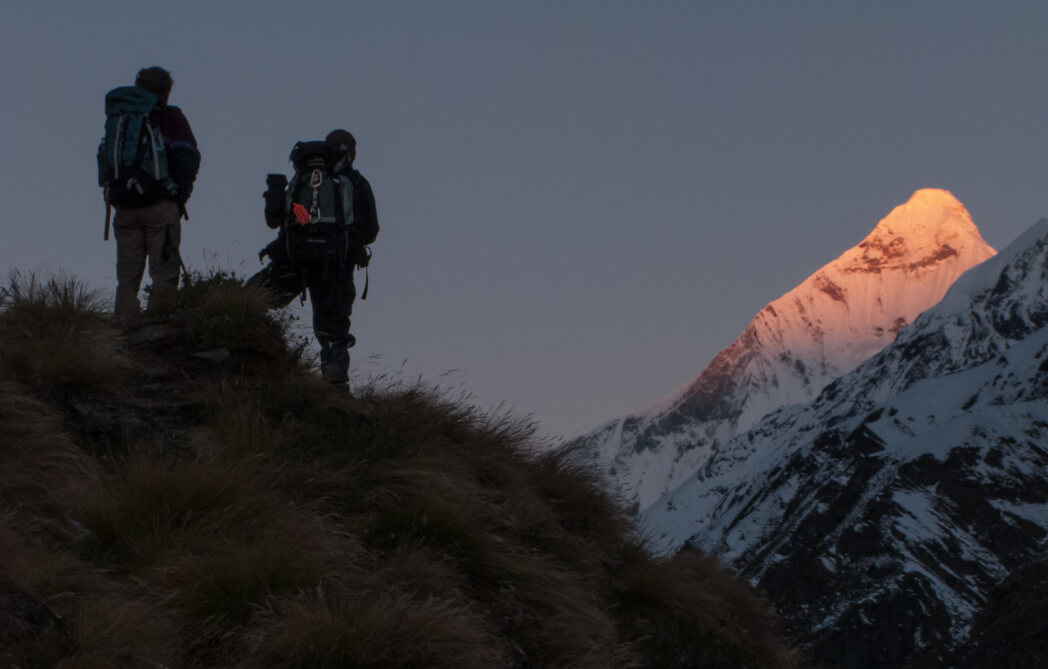
Where is Nanda Devi East Base Camp Trek?
Nanda Devi is the second highest peak in India. It is surrounded by Gori Ganga Valley on East and Rishi Ganga Valley on West. It is also the highest peak of Uttarakhand . You have to follow the trail to the east side as it is lesser in height. It is also called Sunanda Devi ( formally as Nanda Devi). It forms a 2km long and high ridge to it’s Eastern and Western side.
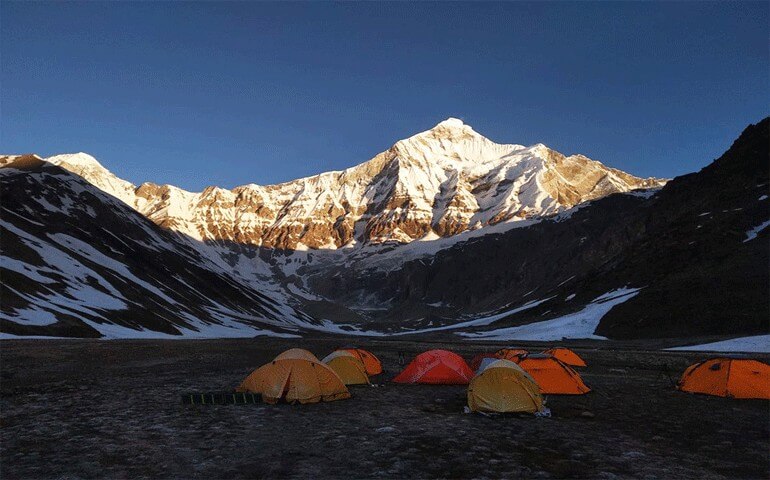
Best time to visit Nanda Devi East Base Camp
- The best season to visit the Nanda Devi Trek Mid March to Mid June & Mid September to Mid October.
- In Winter the temperature may stoop low to negative and hence the trek becomes unsuitable. The roads often get blocked due to heavy snowfall.
- In Rainy season the area is very susceptible to landslides and floods. Hence the area remains closed.
Also, avoid Winter as the temperature is quite low and not suitable for trekking as you can face many dangers on the way.
Nanda Devi East Base Camp Highlight
- ● Offers you the breathtaking view of surrounding mountains like Nanda Devi (7,816m), Panch Chuli and Nanda Kot (6,861m), and Trishul (7,074m).
- ● Takes you through the deserted villages of Munsiyari and Milam.
- ● Opportunity to spot some rare Himalayan species of black bear, Himalayan Tahr, snow leopard, Bharal and also a diverse variety of birdlife
- ● You will follow ancient Tibet Trade Routes amid the Indian Himalayas.
How To Reach Nanda Devi East coast Base Camp Trek?
Pantnagar Airport is the nearest airport which is 304 km away from Munsiyari. So you can take your flight as suitable.
The nearest Railway station is Kathgodam railway station which is 273 km away from Munsiyari. You can then take a cab to your hotel
The highways are linked well with Munsiyari. So you can reach Munsiyari from nearby cities like Haldwani, Kausani, Rishikesh, Nainital through cab or buses owned by the state.
Nanda Devi East Coast Trek Cost
According to Ahvan Adventures, the cost per person is about 34,500 per head.
Nanda Devi East Coast Trek Itinerary
Day 01: delhi – kathgodam (by ac train) – almora.
The train for Kathgodam leaves from New Delhi at 06:00 hours. Once you board the train you will arrive at Kathgodam at 11:20 hours. From there you can take a cab to Almora and board your hotel as well. You may now relax to fade away the tiredness of the journey. In the evening explore local markets to get local goodies and local famous delicacies.
Day 02: Almora – Munsiyari
Today you will check out and travel to Munsiyari via road. You will also come across the old villages, serene waterfalls, and forests. Once you arrive at Munsiyari check in to your hotel and rest for the day.
Day 03: Munsyari – Lilam
Today you will be starting your trekking journey from Munsiyari to Lilam via Barkot. From Barkot trail 2km down the hill to the bridge of Gori Ganga and arrive at Jimighat. Spend some time there, enjoy the natural beauty and smell the fresh air. Then you will trek back to Lilam. Set up your tents there and stay for the night.
Read more: Kafni Glacier Trek
Day 04: Lilam – Bugdiar
Take your breakfast early as today you will be Trekking to Bugdiar. Also, the trek will follow along the right side of the valley above the gushing Gori Ganga. After walking a few steps you will reach a gorge. The trail will then take you to Garam Pani famous for its sulfur bath. From there, your trek will take you amid the conifer and oak forest. You will walk along the path for 4 to 5 km till you reach Bugdiar. Stay for the night at your camps.
Day 05: Bugdiar– Martoli
Take an energy breakfast and get ready for your trek to Martoli. Your trial will follow Gori Ganga till the pristine Hindu temple at Bugdiar. After trekking 4km you will witness Meadows on your way to Laspadhura also called Laspa pass. Relax there for a while. Now you will have to trek for 6 to 7 km over the flat stones and finally reach Martoli. There you will also see the grass-filled meadows of Martoli. Stay there for the night.
Day 06: Martoli – Milam
Today you will reach one of the important destinations of this trek and that is Milam village. Crossing the bridges over Gori Ganga and Lwan Gad to reach Bhurpu village at an elevation of 3350 m.
Day 07: Milam – Milam Glacier – Milam
Get up early today as you will be starting for Milam Glacier. Today the trek might feel a little challenging but it will surely be rewarding once you reach your final destination. The glacier will offer you the view of Rishi Parvat ( 6692 M), Trishul (7074 M), and Hardeol (7151 M). You can definitely take your time there admiring the beauty. Then you will trek back to Milam village and camo for the night.
Day 08: Milam
Explore Milam village today. Go to local markets, shop for local goodies, click amazing pictures of the serene landscapes. Stay for the night in your camps.
Day 09: Milam – Lwani
Take your breakfast and start for the downhill trek to Lwani. Explore the beauty of the place. Set up your camps and stay for the night.
Day 10: Lwani – Nanda Devi East Base Camp
Take a good breakfast early as today you will be heading to the East Base Camp. The trail to Base Camp will take you through moraine fields, pretty picturesque meadows, and the natural beauty until you reach Naspanpatti, the Base camp. Once you arrive there, set up your tents and roam around in nature. Take your dinner and sleep for the night.
Day 11: Nanda Devi East Base Camp – Nanda Devi East
Today is the day you were looking forward to it. You will trek to Nanda Devi East. The spot is alluring and beautiful. After that trek back to your Base camp. Take your dinner and spend the night there.
Day 12: Nanda Devi East Base Camp – Martoli
After a 4-5 hrs trek, you will reach Martoli. Explore the place and spend your time there luxuriously. Eat your dinner and stay back for the day.
Day 13: Martoli – Bugdiar
Get up early and take your breakfast. Then trek down to Bugdiar via Railkot. Stay in your tents for the night. A beautiful memory to behold.
Day 14: Bugdiar – Lilam
From Bugdiar you will trek to Lilam today. Set up your camps there and spend the night in the laps of mother nature. Sing songs in front of the campfire and enjoy your moments.
Day 15: Lilam – Munsiyari
Today is the last day of the trek. You will trek down to Munsiyari. Once you reach there, travel back to your hotel and take a rest. Eat your food and have a good night’s sleep.
Day 16: Munsyari – Kathgodam
You will have to travel early morning to the Kathgodam railway station as your train the Ranikhet express will be leaving from there. Once you board your train you will reach Delhi. This is an overnight journey.
Read more: Pindari Glacier Trek
Day 17: Arrival Delhi
After you arrive in Delhi your trek journey now comes to an end. Bid goodbye with sweet memories and enjoy the post thrill the trek offers. Take good memories way back to your home.
- Share This Post:
Related Articles
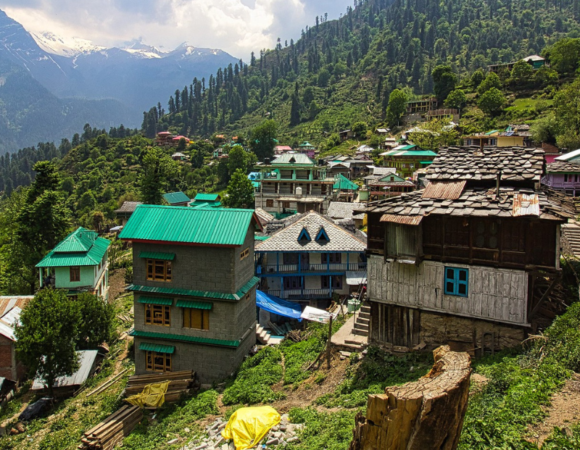
10 Best Hill Station In Himachal Pradesh, Highlights, FAQ’s
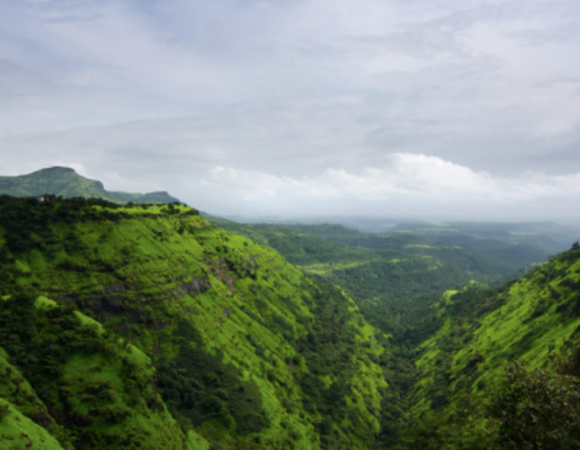
10 Best Hill Stations In Maharashtra, Highlights & FAQ’s
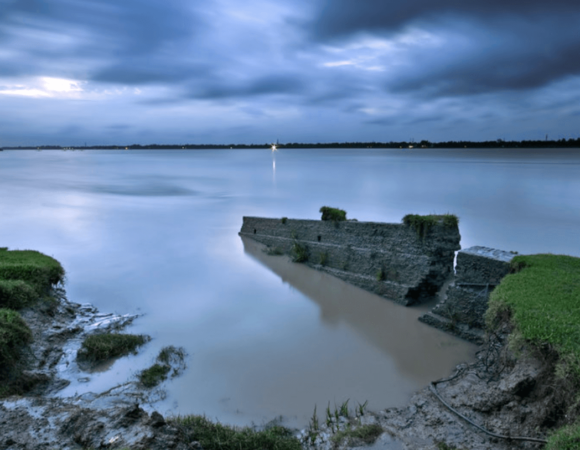
10 Best Hill Stations In West Bengal – Best Time, How to Reach Highlights & FAQs
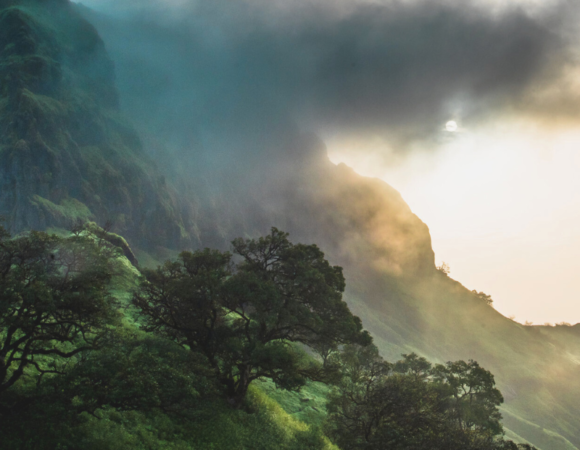
10 Best Maharashtra Trekking Places, Highlights, Treks & FAQ’s
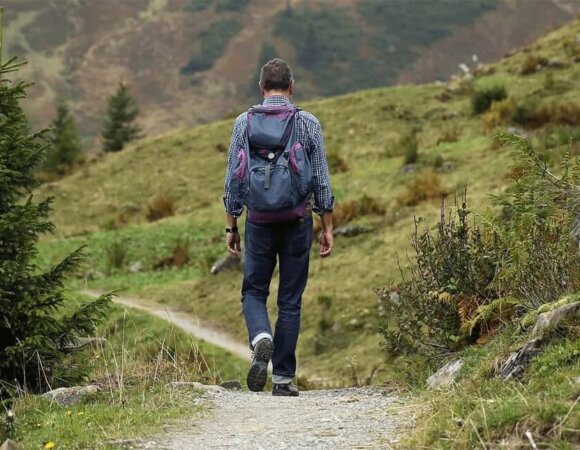
10 Best Trekking Places Near Delhi In 2024 & FAQ’s

10 Best Treks in Himachal That You Can Do in Winters
6 thoughts on “nanda devi east base camp trek guide 2024: cost, highlights, best time and itinerary”.
[…] Read more: Nanda Devi East Base Camp Trek […]
[…] Devi National Park is a national park located around Nanda Devi Peak. The park includes the Nanda Devi Shrine, a glacial basin enclosed by a group of peaks between […]
You said that wonderfully.
[…] Center Museum and serving as the headquarters of the Indian Army’s Kumaon Regiment. Nanda Devi Peak vistas, hiking trails, mountain treks, golf courses, orchards, and temples are some of […]
Add a Comment Cancel reply
Save my name, email, and website in this browser for the next time I comment.
Things To Carry On Your Trek
Book your experience with us.
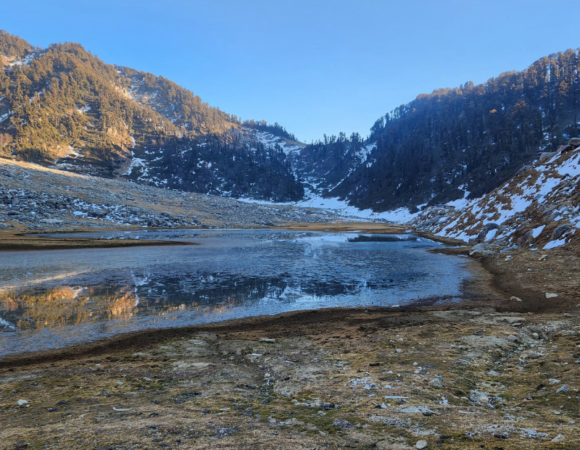
- Amenities 5
Kareri Lake Trek
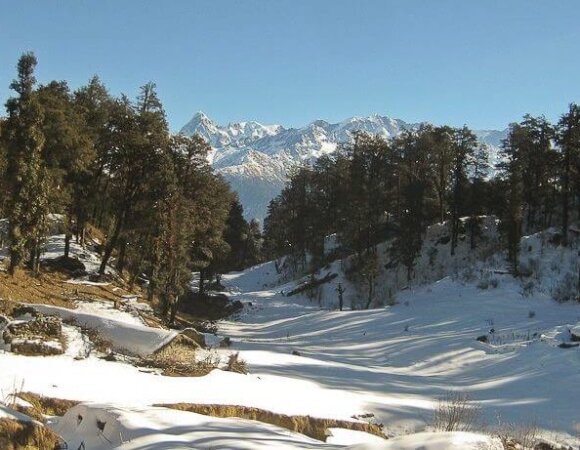
Dayara Bugyal Trek
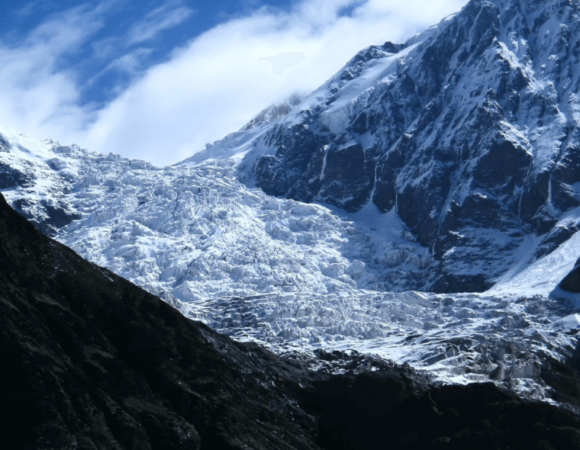
Pindari Glacier Trek
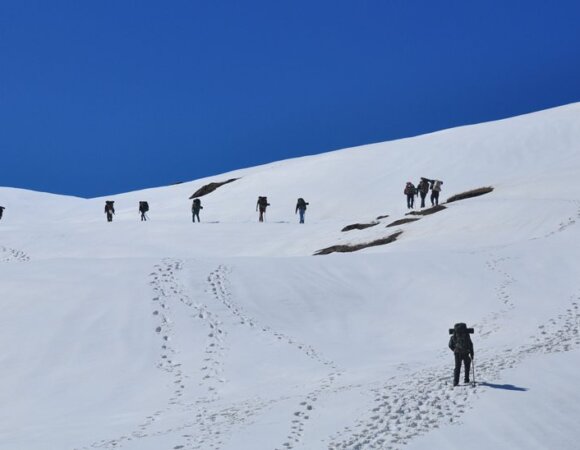
Panwali Kantha Trek
Book your unforgettable experience with us, reset password.
WhatsApp Us
- More Networks
You will receive an email containing a link allowing you to reset your password to a new preferred one.
Verification mail has been sent.
Please check your mail to verify your account.
Click Here to Login
- How To Reach

30°22'13.9"N 80°00'18.9"E
- Nanda Devi Base Camp Trek

Inquire Now
Munsiyari, Uttarakhand
Pickup Point
Railway Station, Kathgodam
Minimum Age
- Insanely beautiful vistas of the Nanda Devi and Panchachuli peaks.
- Spotting of the rare Himalayan Musk Deer, and Snow Leopard.
- Trek through some of the deepest gorges in the country.
Nanda Devi, the second-highest mountain in India, constitutes a pair of massive peaks, namely Nanda Devi East (7,816 m) and Nanda Devi West (7,434 m). The Nanda Devi East Base Camp trek affords unmatched views of the two peaks and is as close as one can get to their beauty. Beginning from the beautiful settlement of Munsiyari, the trail snakes through dense bamboo forests, verdant alpine meadows, rustic villages, and some of the deepest gorges in the country! If luck favors, the trek may also reward you with an extremely rare glimpse of the Himalayan Musk Deer, and Snow Leopard. It also introduces trekkers to the culture of the Johari Tribe, which are native to Munsiyari.
Brief Itinerary
Detailed itinerary, day 1 : arrive at munsiyari, day 2 : trek from munsiyari to lilam, day 3 : trek from lilam to bugdiyar, day 4 : trek from bugdiyar to rilkot, day 5 : trek from rilkot to ghangar, day 6 : trek from ghangar to nanda devi east base camp, day 7 : rest & explore at the nanda devi east base camp, day 8 : trek from nanda devi east base camp to rilkot, day 9 : trek from rilkot to bugdiyar, day 10 : trek from bugdiyar back to munsiyari, day 11 : depart from munsiyari.
We will arrange a cab for you from Kathgodam Railway Station. For communications purposes, we will create a Whatsapp Group before the departure date of the trek and will share the details regarding the transportation. The drop at Kathgodam after the trek will be arranged in a similar way.
How to reach Nanda Devi Base Camp Trek Starting Point - Munsiyari
The nearest airport to Munsiyari is the Pantnagar Airport (312 km). You will have to take a cab from there to Munsiyari which will take 7-8 hours.
Kathgodam is the nearest Railway Station to Munsiyari (280 km). You can take an overnight train to Kathgodam from Delhi. After reaching Kathgodam, you will have to take a cab to Munsiyari.
Well connected to the neighboring towns of Rishikesh, Nainital, Kausani, and Haldwani, Munsiyari can be reached via taxis or state transport.
Latest Stories
Why trek with us .

Get Yourself Fit
Nutrition tips, things to take, health & safety.
- Accommodations at Trek: All accommodations on the trek will be on twin sharing basis in Tents or Homestays. Any accommodation in a hotel/guest house/hostel will be in a budget hotel.
- Trek Leader and Guides: An experienced and certified Trek Leader , as well as a professional guide, will accompany you for the trek. The team will have years of experience and well equipped for any emergency situation.
- Transportation to the base camp from Kathgodam : Transportation to and fro Munsiyari from Kathgodam is included in the package.
- Services of a Professional Trekking Team: A team of an experienced Cook, Camp Staff, Porters/Mules will accompany you for all the arrangements on the trek .
- Meals: All Meals on the Trek are included. We will serve Vegetarian Indian food on the trek which will be cooked by our high altitude chefs. It will be a five-course meal plan.
- Camping and Safety Equipment: All the camping equipment such as Tents, Sleeping bags, Toilet Tents, Dining Tent, Mattresses, and other things will be provided by us and we guarantee the quality. Safety Equipment including Medical kit, Oxygen Cylinder, Oximeter, Crampons & Gaiters(if required) will be provided by us. We recommend you to bring your own sleeping bags if possible.
- Trek Permits and Forest Camping Charges: Only for Indian Clients, All the applicable trekking permits, Camping Charges, Forest Entry Fee, etc will be paid by us. Foreigners have to pay these charges if not mentioned.
- A Life-Changing Experience: We assure you that by trekking in the Himalayas you will have a life-changing experience and we will do everything we can to provide you with the best services and make your venture in the wild an unforgettable one.
Note: Prior to booking any adventure with Trekmunk, it will be mandatory to sign the waiver form and get a medical certificate from a doctor in due time, without these, you will not be allowed to start the trek. All this will be done online without using any paper.
- GST and Other Taxes: The goods and services tax is not included in the price mentioned with the trek. They are subjected to change according to the government rules of India.
- Accommodation and Food in Kathgodam: Food and stay in Kathgodam is not included in the package.
- Flights and Transportation to Kathgodam: Flights or other means of transport are not included in the package.
- Personal Equipment: Your Rucksack, personal clothing, shoes, trek poles, and other personal trekking gear is not included in this package. You have to bring your own gear according to the weather and difficulty of the trek.
- Portage of Personal Bags(Offloading): We highly advise you to carry your own burden (your rucksack) but due to any reason, if you wish to not carry your rucksack, we can arrange for a porter/mule to carry it. For this service, you will be charged over and above the trek cost. The charges for offloading vary with every trek.
- Travel Insurance: Travel Insurance is not included in this package. We recommend you to have travel insurance before opting for such adventures. You can buy insurance from us while booking the trek, it is optional.
- Personal Expenses: Any personal expenses incurred (Laundry, Bottled Water, Beverages, Snacks, Orders at tea houses or dhabas, Tips for guides, Camera fees, etc) are not included in the package.
- Emergency Expenses: Any costs arising out of unforeseen circumstances such as accidents, bad weather, landslides, road conditions and any other circumstances beyond our control are not included in the package.
- Anything not mentioned in Inclusions of the package.
Cancellation Policy And More Information
Booking Terms:
1. Confirmation Policy :
Upon Booking, An invoice will be sent to your mail & within 12 to 24 hours the booking confirmation with additional details will be sent to your mail.
2. Cancellation Policy:
Note: Following Cancellation policy will be followed for departures booked on or before 31st May 2021-
1) Cancellation up to 7 days before the start date of the trek: Get a complete cash refund (minus 5% transaction fee). The money is refunded to the same bank account, credit, or debit card from where the payment was made.
2) Cancellation during the last 6 days before the start date of the trek, and not counting the day of the trek: Full refund with 100% of the trek fee in the form of a Trekmunk Trek Voucher. Valid for 1 year from the date of issue. Can be used on any Trekmunk trek.
3) Cancellation on the start day of the trek, or no show on the start day of the trek : Unfortunately, no refund.
For more details, go to https://www.trekmunk.com/cancellation-policy
3. Refund Policy:
Any refund applicable will be processed within 10 to 15 business days as per the company policy.
4. Postpone/Transfer of a booked trek:
1. You can postpone your booked trek for a period of two months (61 days) but we will charge a 20% processing fee. The last date for the postponement will be 15 days before the start of the trek. Failing to book the slot in 2 months (61 days) time, would be considered a cancellation with no refund of any kind. Postpone of a booked trek can only be done once.
2. You can transfer your booked slot for the trek to any fit person till 15 days before the trek. You just have to mail us the request and rest we will handle. The new person has to get all the mandatory documents duly signed for the trek.
More Information:
1. We Trek for a Cause : For overall development of the areas we run our operations in, we donate Rs 100/- per booking from our profits which are used for the upliftment of the local people and conserving nature. We have named this initiative as - Trek for a Cause. For more details, follow: https://www.trekmunk.com/trek-for-a-cause
2. We are paperless : We are focusing on Sustainable Tourism and to do that we are trying all measures to convert our trek operations to be Eco-Friendly. Going Paperless is one step closer to our aim.
3. Single-Use Plastic : Trekmunk does not encourage the use of single-use plastic items. We are ensuring that our team is working together to reduce the problem and educate those around them. We will send you instructions on how to go plastic-free on your adventures.
4. Preparing for your Holiday : Getting some additional exercise makes a lot of sense to spend time before coming on a trekking adventure. The fitter you are, the more enjoyable you will find the experience. Hiking in the hill country is the best training but jogging, squash and swimming are also good for developing cardiovascular fitness and stamina. To read more on how to get fit, follow: https://www.trekmunk.com/get-fit-for-trek
5. Electricity Supply & Plug : You will get electricity supply till the starting point of the trek. If not Indian, We recommend you check if you require an adaptor for your electrical items at: http://www.worldstandards.eu/electricity/plugs-and-sockets/
6. Currency: The unit of currency in India is the Indian Rupees.
7. Health & Vaccinations:
Severe Allergies : If you have a severe allergy please inform the Trekmunk office before you travel. We will do all we can to help, but we cannot guarantee an allergy-free environment on trekmunk trips. You will need to carry your own treatment for the allergy with you, as 'adrenaline auto-injectors' are not carried as standard by our leaders and staff. You should inform your leader on the arrival of your allergy, and let them know where you keep your adrenaline pen.
Vaccinations : You should contact your doctor or travel clinic to check whether you require any specific vaccinations or other preventive measures. You should be up to date with routine courses and boosters as recommended e.g. diphtheria-tetanus-polio and measles-mumps-rubella, along with hepatitis A and typhoid. Malarial prophylaxis is not usually required for trips in the mountains, however, if you are visiting rural and remote low lying areas then they might be necessary.
8. Passport & Visas/Identity Proofs : If foreigner, Validity for 6 months, should have blank pages, and should be kept with yourself all the time.
9. Water : If you are on a trekking or cycling holiday, water is supplied to fill up your individual bottles. This will be boiled or filtered. Additionally, you should take purification tablets or a filter bottle (such as a LifeStraw, Sawyer Filter) to treat your water when in towns or where water is not supplied. We do not encourage the purchasing of single-use plastic bottles.
10. Altitude : This adventure involves going to a very high altitude. This is not something that you should worry about; the human body is quite capable of adapting to a very wide range of altitudes, but it is important that we follow some simple rules in order to acclimatize successfully. We will send you the information in your mailbox about Acute Mountain Sickness and trekking in high altitudes. On this trip, we carry bottled oxygen for use in emergencies.
11. Guidance on Tipping : Tipping is the accepted way of saying thank you for good service. Normally the guide and any other trek staff are given their tips at the end of the trek and this is best done as a group. The main guide will make sure that the tip is appropriately distributed among all the staff members on the trek.
12. Spending/Emergency Money : Approximately Rs. 8000-10000/- (in Indian Currency)should be carried for miscellaneous expenses including porter and trek crew tips, drinks, soft drinks, etc. We recommend that you carry your travel money in the form of cash as the availability of ATM is less in these remote areas. This can also serve as your emergency spending money.
13. Travel Insurance : It is recommended to have travel insurance for these kinds of adventures. When taking out insurance please ensure the policy you choose covers you for the activities and altitude included in your itinerary. We will ask for the Travel Insurance Details over a mail. Indians can buy insurance from us while booking the trek.
I and my friends went to Markha Valley trek with Trekmunk and we all had a great time. Walking up and down the hill, coming across some beautiful sites was mesmerizing. Staying in tents was so much fun. And our guide had all the knowledge about the trek. Trekmunk is really good w ...
I had the most wonderful experience trekking through the ranges of Chandrashila with Trekmunk. The small moments of achievement were phenomenal. Chandrashila is the most astonishing peak that I've ever trekked through; I've never been so fascinated. I think I am going to go for a ...
No words for the bike trip from Srinagar to Leh. One should experience it to feel it and all this because of the management of Trekmunk especially Mohit and Harshit whose efforts even made the hardest of the ride exciting adventurous and above all safe. Although some hindrances w ...
I and my friends went to Markha Valley trek with Trekmunk and we all had a great time. Walking up and down the hill, coming across some beautiful sites was mesmerizing. Staying in tents was so much fun. And our guide had all the knowledge about the trek. Trekmunk is really good with its food and accommodation facilities. I highly recommend Trekmunk. Kudos to their Team.
I had the most wonderful experience trekking through the ranges of Chandrashila with Trekmunk. The small moments of achievement were phenomenal. Chandrashila is the most astonishing peak that I've ever trekked through; I've never been so fascinated. I think I am going to go for another trek with Trekmunk soon enough! The kind of hospitality that is provided to us is worth appreciating. I made many new friends and have enjoyed each and every day of this trek to its fullest.
No words for the bike trip from Srinagar to Leh. One should experience it to feel it and all this because of the management of Trekmunk especially Mohit and Harshit whose efforts even made the hardest of the ride exciting adventurous and above all safe. Although some hindrances which are quite common like bike issues and medical problems arose with our co-riders, I liked the way these two guys handled it dexterously. I went with one of my best friends and came with a lot more and the trip turned out to be memories that can be cherished for a lifetime. Thanks, Team Trekmunk for giving me a wonderful experience. I can't wait to go on my next adventure with them.
I had an amazing trek with Trekmunk to Sandakphu November and December 2019. From the first moment of inquiry about the trek and all my questions were answered clearly and on time thanks to Dheeraj who managed to facilitate the trek quite well with his communication. Our guide Arpan was very experienced, calm, patient and very helpful to each trekker's needs in the group. He facilitated to find and hire a porter for me once I needed one although we were in the middle of the trail. He also arranged emergency transportation when I had to cut the trek and go back home for an urgent matter. I really enjoyed their service and I would like to repeat the same trek or try other treks with them again.
I was bored with my regular 9 to 5 schedule and then I decided to seclude myself from the chaotic city life. So, I went to Brahmatal trek last month along with a couple of my friends. We went with Trekmunk and it was a lovely experience. The trek guide, Ramesh was very polite and helpful. The food and snacks were amazing. The activities in the campsite during our overnight stay is something that I am gonna cherish my entire life. I am waiting for my next trek with Trekmunk.

Related Blogs
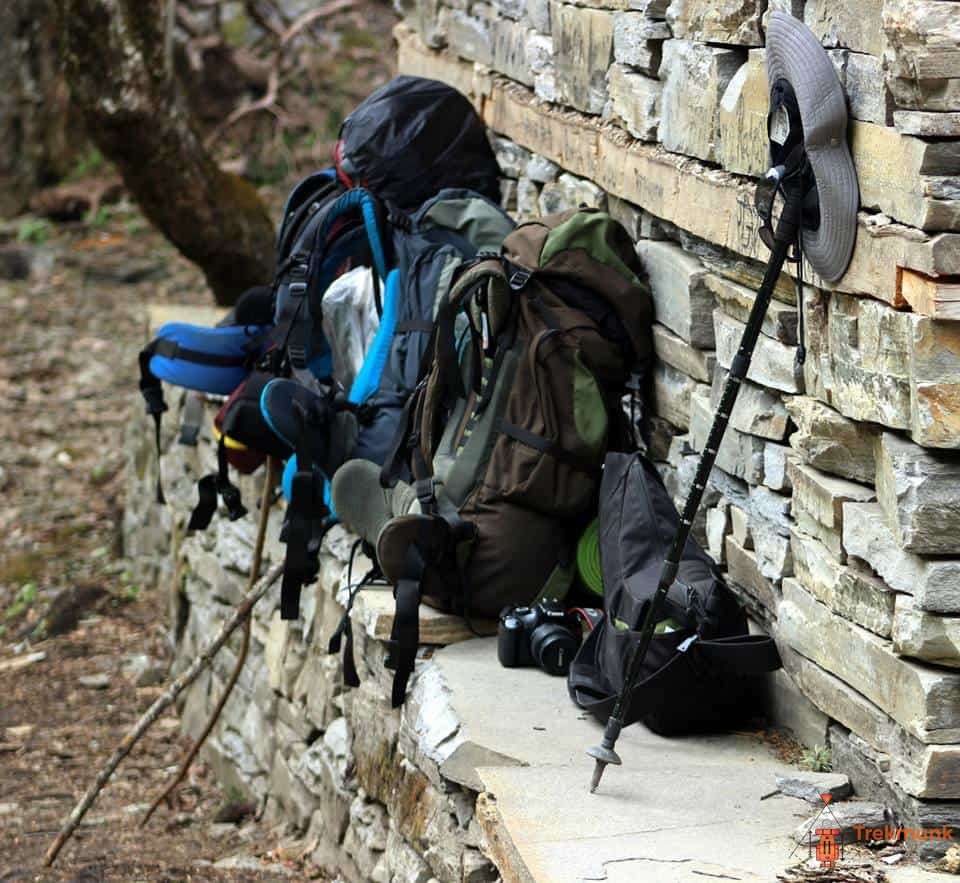
Related Tours
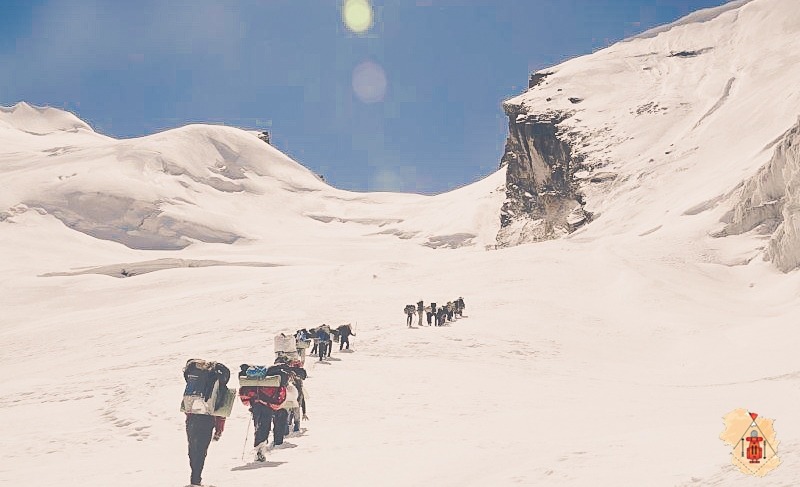
Auden's Col Trek
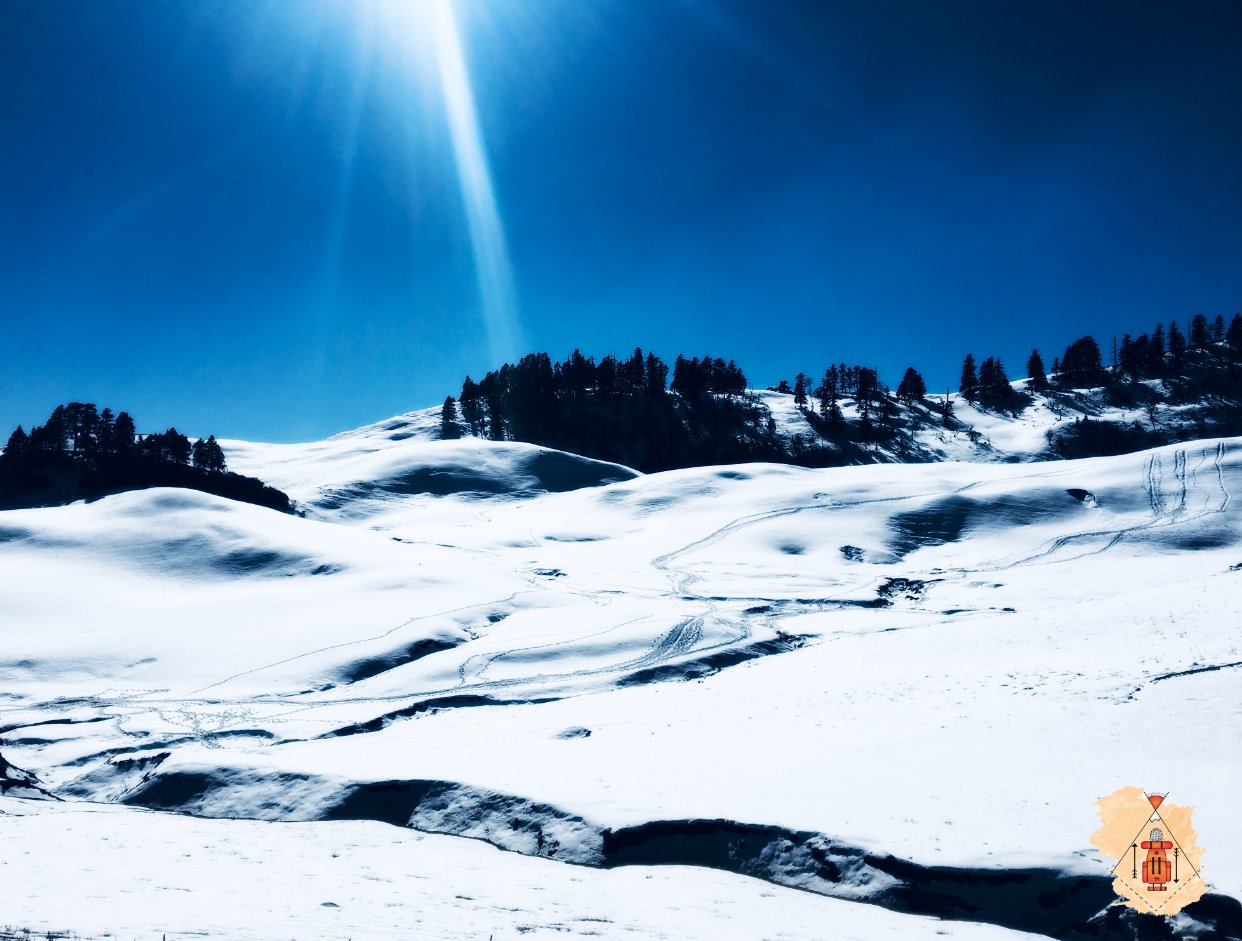
Dayara Bugyal Trek
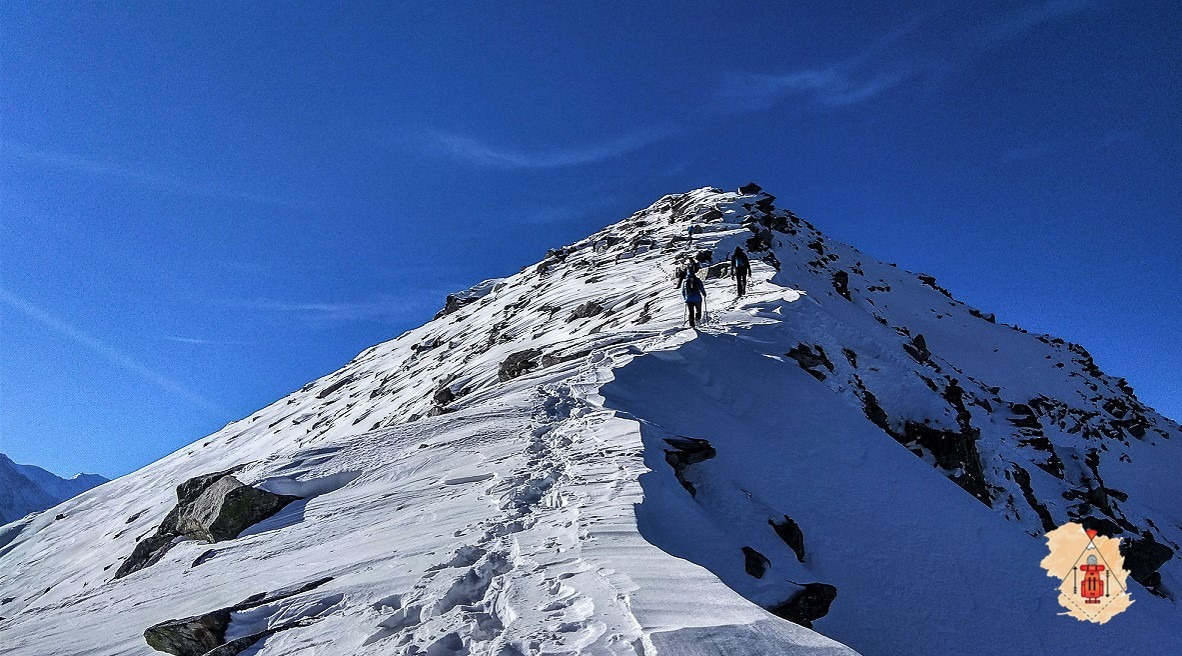
Pangarchulla Summit Trek
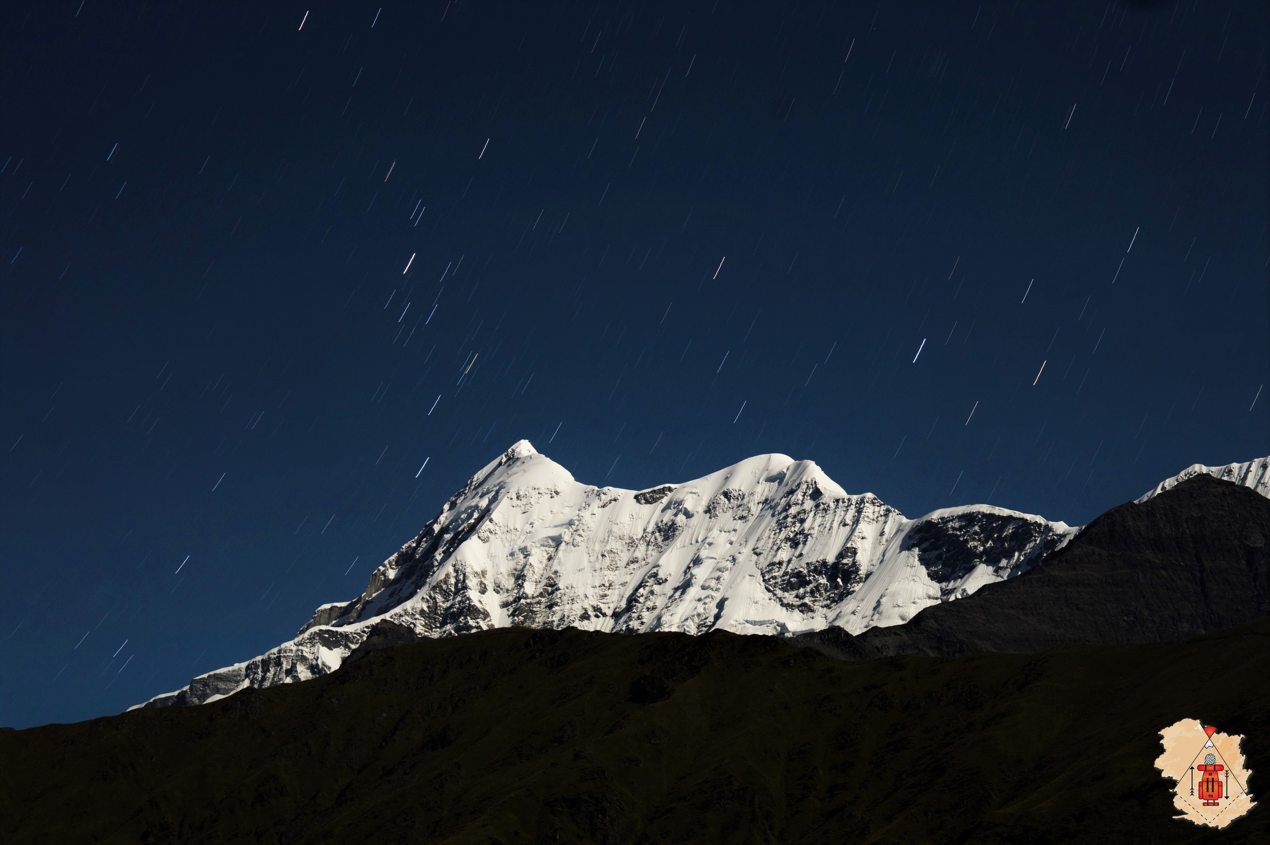
Roopkund Trek
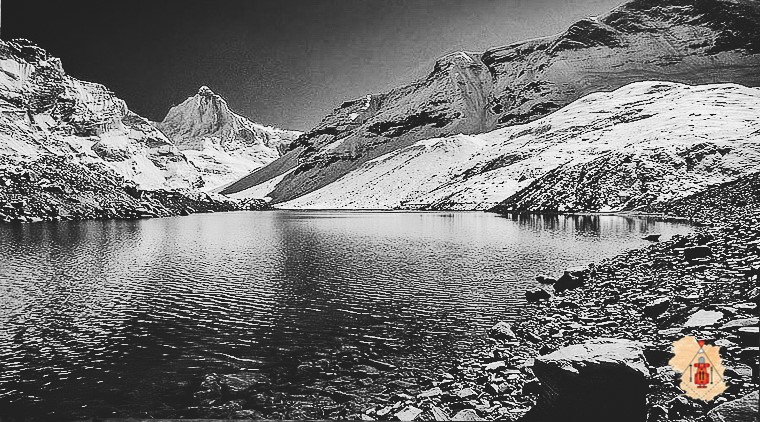
Satopanth Lake Trek
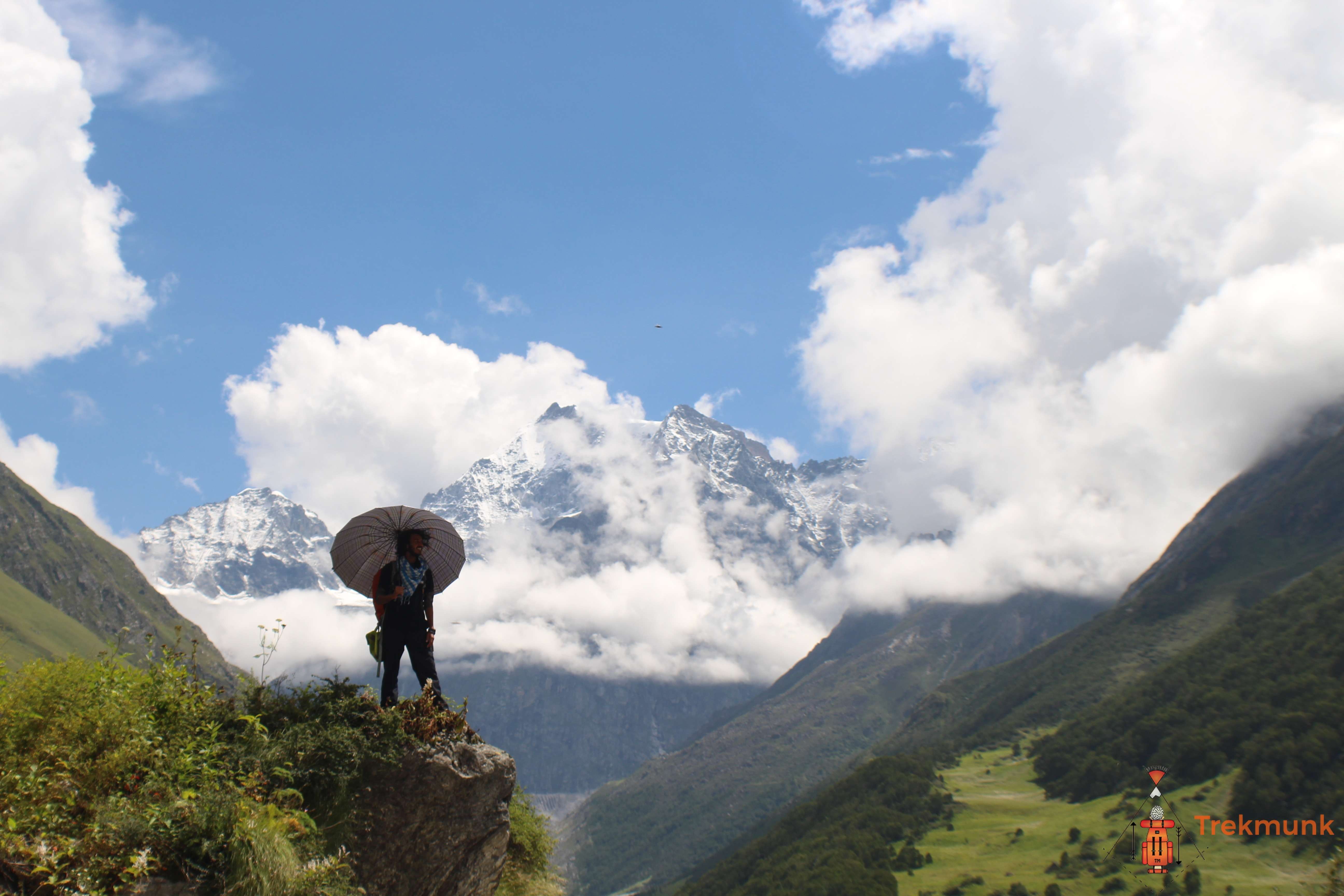
Valley of Flowers Trek

"Trekmunk is changing the indian trekking industry"
"10 Most Promising Adventure Sporting and Trekking Companies - 2020"

" Things you do for the Passion for Travel"
Hello there, How can we help you ?
Timing: 10 am to 6 pm IST (GMT +5:30)
Whats App Us

Nanda Devi Base Camp
Nanda devi base camp trek.
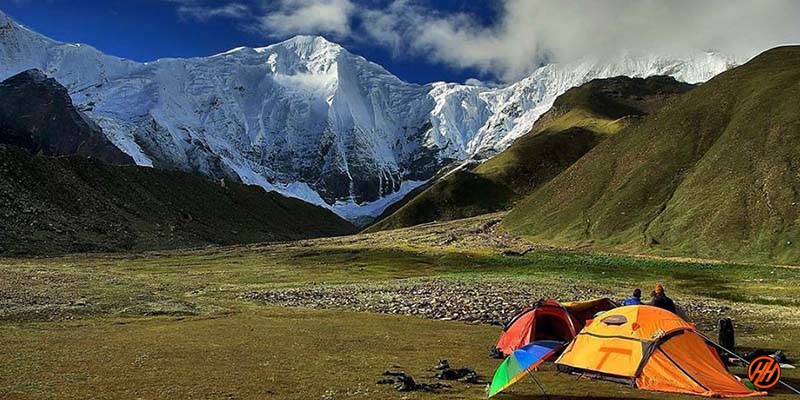
Description
Reviews (0), things to take, available dates, include / exclude, india’s highest mountain base camp trek in uttarakhand.
Nanda Devi Base Camp (7816 Meters) is the second-highest mountain Located in Uttarakhand Himalayas, India. It comes in Kumaun Garhwal which starts from a small city Munsiyari. This peak has extreme beauty and is very important to the locals. Nanda Devi Base Camp is on the eastern side of the peak and Pachu Glacier lies there. Go from the trade route, there was a civilization in ancient times; it leads to Nanda Devi Base Camp.
Nanda Devi base camp trek is very difficult to trek in Uttarakhand Himalayas , only good and knowledgeable trekkers can do this trek, which has knowledge of high treks,
Nanda Devi Peak is of two peaks, which are thus Nanda Devi is East (7,434 m) and the second and Nanda Devi is west (7,816 m). Nanda Devi East Base Camp Trek, we have seen and found that this is the right way to get a close look at the beauty of these beautiful peaks.
Kathgodam is the starting and endpoint of this trek, you will see the diverse Flora and Fauna, nature is outstanding and from Munsiyari the trail takes you through thrilling passes, green forests, and surreal meadows. Also, experience the cultures and lives of people in the mountains. From Pachu glacier the next day you will explore the Base Camp of Nanda Devi.
The Nanda Devi base camp trek, these treks are considered very special because these treks are a fantastic expedition in themselves; they are very popular and difficult trek in Uttarakhand Himalayas.
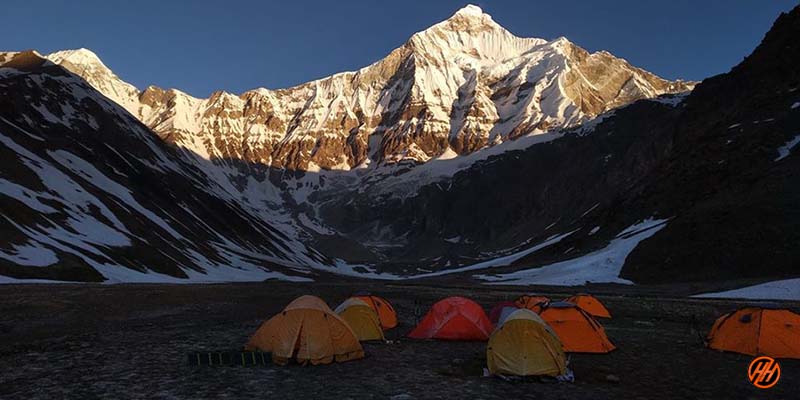
View Points of Nanda Devi Base Camp
One of the most beautiful base camps of Uttarakhand Himalayas, in India, The Nanda Devi East Base Camp. An amphitheater with peaks almost around 270 degrees has an unparallel beauty of nature. Here it is the left side of the base camp.
And this view is in the early morning from our campsite with Nanda Kot clearly visible and Mt. Changuch at the right is hidden behind the clouds. This base camp has any significance, such as climbing many peaks like Changuch, Nanda Bhanar, Nanda Lapak and above all majestic 7434 m Nanda Devi East, also climbing of 5910 m Long staff Col (or Nanda Devi Khal) and 5312 m Trail’s Pass.
The base camp can be reached in 4 to 5 days from Munsiyari, in Uttarakhand Himalayas. This was shot during our expedition to Long staff Col.
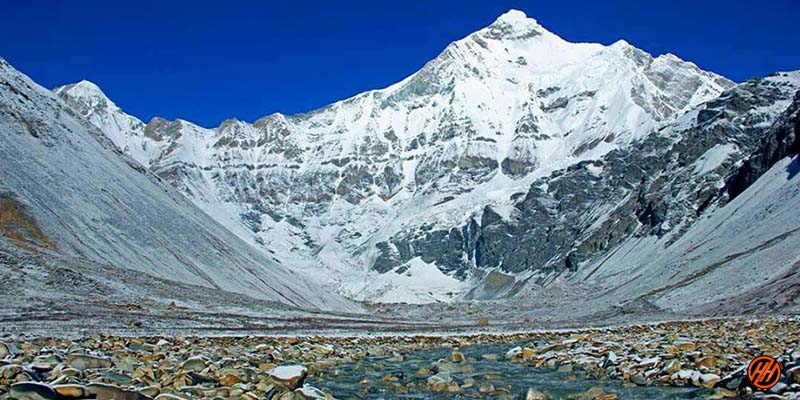
After all, Why? Is the Munsiyari best place you should Visit Here?
The Nanda Devi Base Camp trek starts from Munsiyari Village. From here you can see before you the beautiful mountain range of its four Himalayas, which offers an excellent view of Panchachuli peaks from here and then from Sri Ramganga and most the likable Saryu passes through the valleys.
Which seems like a hypothesis of its own, Munsiyari Hill Village has become home to the Johri tribe in a small beautiful place, which is quite beautiful and attracts itself to you, the people here collect herbs from the mountains and Ayurvedic Medicines are also used a lot and the trekkers who come here also take with them they are quite beneficial and are famous for woolly shawls from sheep goats hair.
Munsiyari, today is one of the most liked places of people, people also come here for a winter trek, treks originating here like Milam Glacier, and, the base for trekkers of Namik Glacier , Ralam Glaciers and Nanda Devi Peak. This area comes in the Nanda Devi National Park, which enhances the splendor of the Himalayas of Uttarakhand.
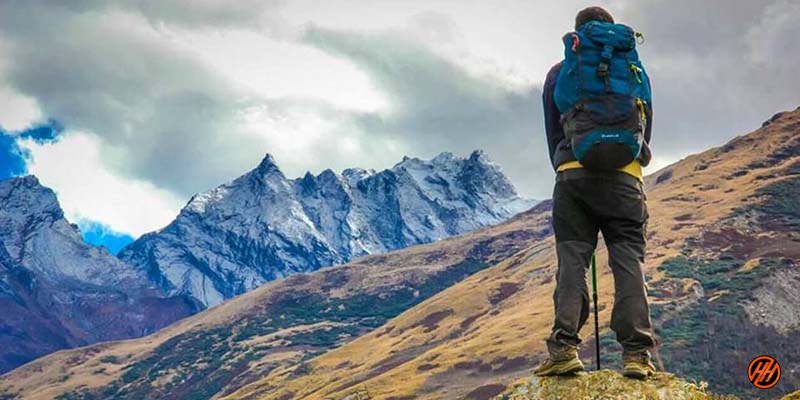
How should you do the Nanda Devi Base Camp Trek along with the local?
Note: – Whenever you do this Nanda Devi Base Camp Trek, Do it with the local people here Munsiyari or with experienced people like us who are local here. Many local people working with Himalayan Hikers, Whoever can help you from the local here, no one else can give you, and it will be useful for you all the time.
This is why we have to say that sometimes there are seasonal changes in nature, for which we all have to be ready, this is the law of adventure.
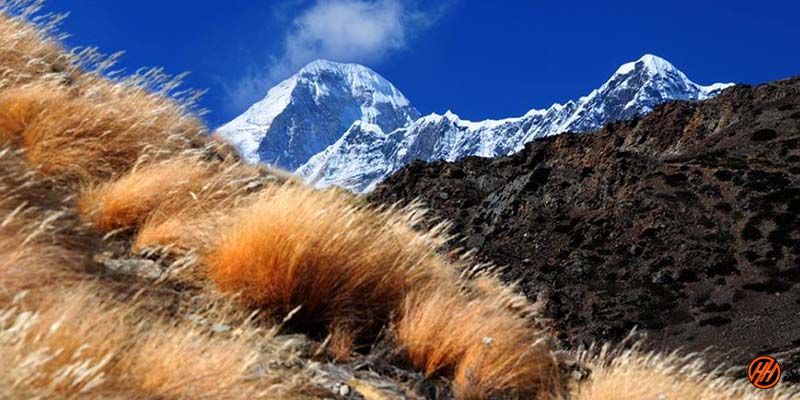
Must Read about Nanda Devi Base Camp Trek
Duration – 13 Days from Kathgodam to Kathgodam)
Best Season – May 15 th to June last week and September or October 1 st week
Level- Difficult
Highest Point- 4,000, Meters
Trekking Distance – 112 Km on foot and By taxi 554 Km
Weather: Nights are cold and the day temperature is pleasant during the season. It is unpredicted and can change anytime so do keep an extra day in the itinerary
Temperature: (2°C to -10°C)
Key Points about Nanda Devi Base Camp Trek
Level: Difficult (so first-timers trekkers should avoid)
Proper conditioning & training of body required
Group size minimum of 03 maximum of 10 people
Need proper Expedition gear & clothing for sub-zero temperatures?
Shoes are the single most important equipment
High Altitude requires proper acclimatization
Post monsoon or pre-monsoon is the best time. During rains, the region is prone to landslides
Phones don’t work on the trek, we provide to you Radio Willkie Talkie for Communication
A beautiful landscape so carry good photo gear (I couldn’t carry my best equipment)
Travel light (my backpack was heavy at about 12 kg to 15 Kg)
Keep an extra day in your itinerary for an attempt to summit account for bad weather
If you choose Good and local trekking company Himalayan Hikers than it is better for you because Himalayan Hikers is local company our mission is safe treks, growth of locals. Some groups come with us for the Expedition and high altitude treks
Alcohol and smoking are not allowed in during the Expedition
Short Itinerary of Nanda Devi Base Camp Trek
Day 1 – Pickup to you from Kathgodam to Munsiyari (277 km) (9/10 Hours) (2290 m) overnight stay Hotel
Day 2 – Trek from Munsiyari to Lilam (7 km) (4/5 Hours) (1850 m) overnight stay camp
Day 3 – Trek from Lilam to Bogudiar (12 km) (6/7 Hours) (2609 m) overnight stay camp
Day 4 – Trek from Bogudiar to Rilkot (12 km) (5/6 Hours) (3130 m) overnight stay camp
Day 5 – Trek from Rilkot to Ghanghar (13 km) (5/6 Hours) (3300 m) overnight stay camp
Day 6 – Rest Day for Acclimatization
Day 7 – Trek from Ghanghar to Pachu Glacier (7 km) (4/5 Hours) (4000 m) overnight stay camp
Day 8 – Exploration day the Nanda Devi base camp (10 km) (5/6 Hours) (4000 to 5400 m) back to camp
Day 9 – Trek from Pachu Glacier to Martoli camp (17 km) (7/8 Hours) overnight stay camp
Day 10 – Trek from Martoli camp to Rargari (20 km) (7/8 Hours) overnight stay camp
Day 11 – Trek from Rargari to Munsiyari (14 km) (6/7 Hours) overnight stay camp
Day 12 – Drive from Munsiyari to Kathgodam (277 km) (9/10 Hours)
Your Travel Plan for Nanda Devi Base Camp Trek
You can book trains, air flights, and bus tickets for your journey only according to the information given by us.
The Nandadevi Devi base trek will be of 10 days and 2 days of your journey from Kathgodam to Kathgodam
First of all, all the trekkers will have to book their flight and train bus according to our time table as our pick up is from 6 am to 7 am, you will have to reach Kathgodam in the morning.
A taxi from Himalayan hikers will link you to Kathgodam railway station.
Himalayan Hikers organize transport to Munsiyari from Kathgodam railway station. Our vehicles leave at 6:00 am to 7:00 am sharp from Kathgodam. The taxi includes your package.
In Kathgodam railway station you will get our staff that will arrange transport for you. The contacts no Transport coordinator or our office team will give you a week ago to your departure.
Planning your onward Air flight/train/ Bus booking
If you are traveling from Kolkata, Bangalore, Chennai, Pune, Mumbai, or Gujarat any other city, so you will have to come to Delhi, you will get a train from Delhi for Dehradun comfortably.
Option 01:- By Train
All trekkers booked yourself the Ranikhet Express,
Ranikhet Express to Kathgodam (Train no is 15013 Departure 10:05 pm: – Reached Kathgodam 5:05 am the train starts from Jaisalmer city. This is the best option for you
Option 02:- By Bus
You can reach Kathgodam from Delhi by a bus, board it from Delhi’s Anand Vihar ISBT, it is good if you are book the seats. Directly bus stand. But to get the bus tickets booked you have to come to the bus stand a little early
The bus leaves from Kathgodam from Delhi at around 9.00 pm. frequent buses are available until midnight. It is a journey of about 8 hours to 9 hours.
(Reach Kathgodam Railway Station between 5:00 am to 6:00 am and the vehicle will be arranged from there.)
ATM Point and Mobile Connectivity in Nanda Devi Base Camp Trek
When you leave for the Nanda Devi Base Camp Trek, you bring the cash according to your requirement and if you want to get the cash in the way, then you will have to go to Kathgodam and there will be no bank ATM to take the cash. (If you want to withdraw money then do it in Delhi)
Mobile Connectivity
The phone does not work in during the Nanda Devi trek, so any necessary calls you make from Munsiyari base camp will not be networked further. You can give your family members contact at our head office to talk about an emergency.
Day 1 : Kathgodam to Munsiyari (277 km) (2290 m)
Arrive Kathgodam and go through Kumaon hills to reach your Munsiyari. Chaukhori is a famous spot for tea gardens and an enthralling view of Himalayas.
Spend the rest of the day in a guesthouse. Dinner and overnight stay in the pre-booked accommodation.
Day 2 : Munsiyari to Lilam (7 km) (1850 m)
Lilam your campsite for today is a mini village with few houses. Post breakfast start trekking towards it, the trek today is an easy one.
Get some wonderful views from here, set up your camps and after having delicious food rest for the night.
Day 3 : Lilam to Bogudiar (12 km) (2609 m)
Post breakfast start your trek towards Bogudiar. Go through forests with bent trees. Small rivers of Gori Ganga and Ralam meet in this forest section.
Continue your trek and ahead see River Poting and Gori Ganga meet. Bogudiar village is marked from here.
Reach there, set your tents and retire for the night.
Day 4 : Bogudiar to Rilkot (12 km) (3130 m)
Today’s trek will disclose the Himalayan adventure, trekking from this point becomes tough. Start after having breakfast and you will reach a place from where the routes divert.
En route to Laspa village, there will be a short diversion which leads to Northern Nanda Kot Glacier. Continue the trek and reach Rilkot.
Set your camps beside the river and after having salubrious food retire for the night.
Day 5 : Rilkot to Ghanghar (13 km) (3300 m)
Bid goodbye to Rilkot and after a short hike you will be entertained by the Martoli Peak views and the trail further opens up to beautiful landscapes.
Before reaching Ghangar the walk is through amazing meadows which is a great relief for the legs. From this village, the beginning of the Pachu valley is marked.
At Ghanghar village you can see quaint wooden houses and a temple which is worshipped by the villagers. Set up your tents at this culturally rich village and retire for the night.
Day 6 : Rest Day for Acclimatization
Day 7 : ghanghar to pachu glacier (7 km) (4000 m).
The climb to Pachu glacier is steep so be prepared, have breakfast and towards the campsite.
Trek through the Rhododendrons forest and get closer views of the peak. Reach the campsite Pachu Glacier after 5 hours trek which lies on Nanda Devi’s Northern face.
Set up your camps here and retire for the night.
Day 8 : Explore the Base Camp
Today you can explore the surroundings. Have your breakfast and go for a hike on the glacier and explore the surroundings. From the glacier, you can have close views of the peak. Come back to the back to the campsite and settle for the day.
Day 9 : Pachu Glacier to Martoli (17 km)
Today on the trek first you will descend for long and then the ascending trail starts. Martelli lies on a trade route and there are many old fashioned houses with wooden carvings.
Mantelli gets the extremely beautiful views of Nanda Devi and Nanda Kot. Set up your camps here and overnight stay in tents.
Day 10 : Martoli to Rargari (20 km)
Post breakfast the trek starts and it will lead you close to Munsiyari when you reach Margarita.
Trek after breakfast takes you closer to Munsiyari as you arrive at Margarita. Today you will be staying in huts. Set up your tents here and retire for the night.
Day 11 : Rargari to Munsiyari (14 km)
You can reach Rargari to Munsiyari after having breakfast. Have dinner there and spend your night in a guest house or tents.
Day 12 : Munsiyari to Kathgodam (296 km)
Have breakfast and drive back towards Chaukori and from there depart to Kathgodam.
Mandatory Documents
Please carry the documents given below.
Original and photocopy of government photo identity card- (Aadhar Card, Driving License, Voters ID, etc, Passport and Visa important to foreigners Medical Certificate (First part should be filled by the Doctor and Second part by the Trekker) Declaration Certificates
Note: – Many trekkers commit the same mistake of carrying unnecessary items on a trek which only makes the backpack heavy. It is important to know the right items to carry. It differs from season to season if you are trekking in summers then carry less layers of warm clothing and if you are trekking in winters carry enough layers to protect yourself against chilly cold.
Necessary Items for trekkers

Backpack (50 to 60 liters) A strongly built backpack with good support is compulsory for a trek. (Rain cover is important)
Sturdy Trekking Shoes The shoes should be strong enough with good support. The people ask if sports shoes would be comfortable but it is good to bring the right trekking shoes.
The Clothes You Should Bring On a Trek Avoid keeping extra clothes because it only makes you backpack heavy.
Trek Pants – The jeans are never suitable for a trek so you need at least 2-3 trek pants for treks carry more for longer treks.
Jacket – Jackets are very important to carry on a trek it protects you against the chilly weather. So carry 2 jackets on a week long trek.
Layers of warm Clothing Carry warm woolen layers or fleece. Carry more layers during winter season (at least 2 to 3) and less during summer.
Thermals – The Temperature decreases at night so you might be need thermals for Night.
T- Shirts – Bring those t shirts which dry fast.
Poncho –They are needed if you are trekking on a Rainy day to keep you dry.
Hiking Pole
Water Bottle 2
Cap or Balaclava
Woolen and Waterproof Gloves
Socks (Woolen and Regular)
Torch head light
Personal Toiletry Items – (toothpaste, toothbrush, toilet paper, sanitizer etc.)
Carry Personal Medical Kit
Personal Medical Kit (Carry minimum 5 tablets and maximum 10)

Diamox – (Prevents altitude sickness)
Digene – (It cures discomfort in stomach, acidity)
Crocin Advance – (Cures fever and headache)
Aspirin/Combiflam – (Pain reliever)
Disprin – (Cures headache)
Avomine – (Prevents motion sickness)
Avil – (It treat allergies)
Norflox TZ & Lomofen – (Prevents Diarrhoea)
Ranitidine – (Reduces the amount of acid in stomach)
Volini/Moov spray – (For sprains)
Betadine/Savlon – (Antiseptic cream)
Stretchable/Elastic bandage
Note:- Use medicines only when prescribed by the doctor. In case you face any problem during your trek, discuss and take advice from the Professional guide.
Sorry! Here are no Available dates right now. For Any Queries you can Email us with [email protected] and Call Us +91 9756197558
What is Included In This Trek?
Transport Facility Dehradun To Dehradun
Forest Permit and entrance fee
Accommodation in tents on twin share basis
All meals: breakfast, packed lunch, tea, coffee, snacks, soup and dinner
(All camping gears)
High quality tents
Sleeping bags
Separate Toilet tents – Ladies and Gents
Dining Tent
Dining Table
Kitchen team
Radio Walkie Talkie for Communication
Good Experience Trek Leader guide and Technical guide
Medical Kit
Oxygen Cylinders
Crampons and Gaiters
What is Not Include In This Trek?
Personal Insurance
Medical Certificate
Personal toiletry Items and Personal Medicine kit
On first day En Route to base camp the Breakfast and Lunch are Not Included
Last Day En Route Lunch and Dinner are Not Included
Transport Facility Kasol To Kasol
There are no reviews yet.
Your email address will not be published. Required fields are marked *
Name *
Email *
Save my name, email, and website in this browser for the next time I comment.
Related Tours
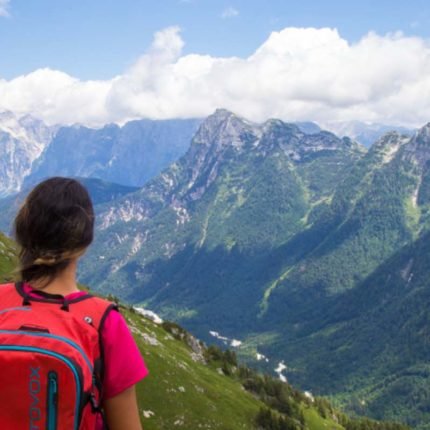
Chaainsheel Bugyal Trek
Chaainsheel Bugyal trek the most beautiful ridge trek
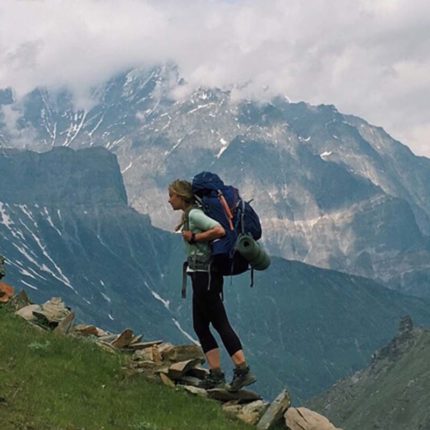
Ghepan Ghat Trek
Stunning Ghepan Ghat trek hides in Lahaul
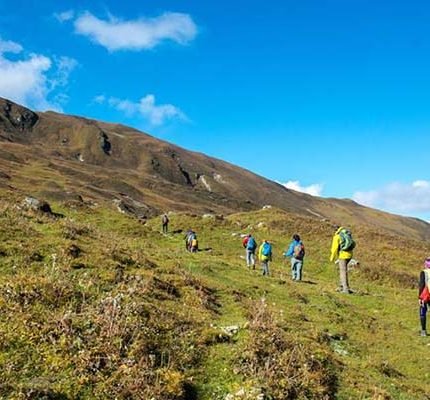
Bamsaru Khal Trek
Bamsaru Khal Trek a Lush Green Valley in Garhwal
Price: ₹ 40,500.00
Book the tour
Send a quick enquiry.
- Overview Itinerary Dates Include/Exclude
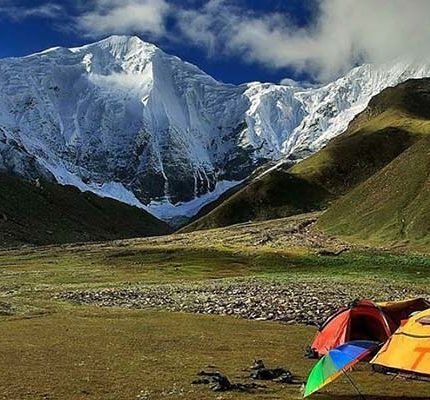
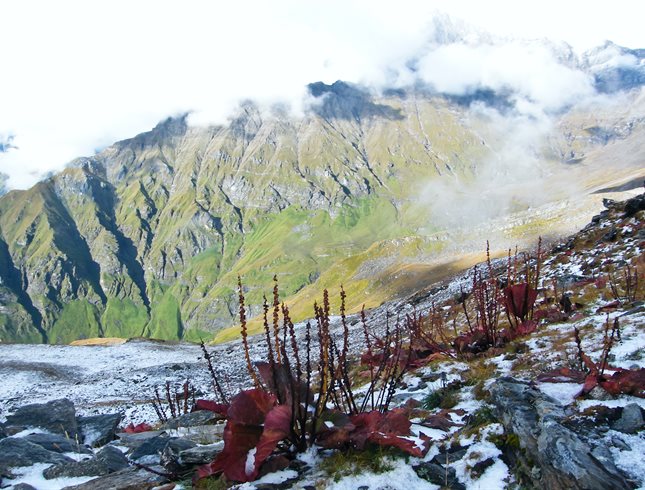
Nanda Devi Base Camp Trek
Uttarakhand • 10 days.
MAX ALTITUDE
₹ 29900 + 5% GST
Munsyari to Munsyari
Available Batches
Brief description.
Nanda Devi (7816 M) is India’s second highest mountain. It is a massif with two peaks namely the Nanda Devi East (7434 mtrs.) and Nanda Devi West (7,816 mtrs.). Nanda Devi East Base Camp Trek is the perfect way to witness the beauty of the sister peaks - standing in the centre of a ring of peaks – majestic and aloof. The trek is approached through the Rishi Ganga gorge, one of the deepest in the world. The trek begins from Munsiyari that offers excellent views of the Panchachuli peaks and then passes through the Ramganga and Saryu valleys. Munsyari is a small beautiful hamlet with a scenic array of waterfalls and home to the Johari Tribe who are famed for their ayurvedic medicines and woolen shawls. Munsiyari is the base for trekkers to Milam, Namik, Ralam glaciers & the Nanda Devi Peak. The region is adjacent to Nanda Devi National Park which is one of the most spectacular wilderness in the Himalayas. It is home to a variety of Flora & Fauna. If luck is favoring you on this trip you might even sight the elusive Snow Leopard or the Himalayan musk deer.

Arrive in Munsyari (2290 M)
Arrive in Munsyari by evening. Hotel stay & dinner will be arranged by us. Rooms will be on twin or triple sharing basis. Address of the Hotel & Contact person will be provided by us in a separate email before the departure date.
Munsiyari to Lilam (2000 M). 7 Kms Trek, 2-3 Hours
Today trek is easy and planned so for better acclimatization. After breakfast in the Hotel, we board a taxi and drive to Selapani (10 Kms)which is the last road head. The trek begins with a steep descent to Gori Ganga River. We cross the river through a bridge at a place called “Jimighat”. From here a gradual ascent along the river bring us to Lilam Village. Lilam is the winter home for the residents of Milam Village (Closer to Milam Glaciar). Although most of the people have become permanent residents of Lilam, few families still continue the tradition to migrating to Milam in summer. We will arrive in Lilam by late afternoon.Overnight stay in Camps.
Lilam to Bugdiyar (2700 M). 13 Kms, 6-7 Hours
We will trek in the same gorge. The trek is parallel to the river on a trail which consist of Bamboo thickets & Connifer trees. After about 5 Kms we come to a point where a steam called Ralam meets Gori Ganga.The trail climbs from here to our next milestone which is a tea shop at Radgari. Trekking along the river we arrive in Bugdyar which is a beautiful camping site. It also has a small rest house. There is a memorial in Bugdyar which is dedicated to Villagers and army personnel who died in an avalanche in 1989. A cruel reminder of what nature’s fury can do to a place and its people. Overnight stay in Camps.
Bugdiyar to Rilkot (3200 M). 15 Kms, 7-8 Hours
Cross the bridge over the river. Initially the climb is steep upto a overhanging cliff which shelters a diety. The tail after that eases out. Now you are walking at the level of river parallel to it. This is probably the best section of the complete trail. There are two notable waterfall on the way both of the height of 80 M or more. The trail ascends gradually till we reach Rilkot by late afternoon. Overnight in the camps.
Rilkot to Ghangar (3300 M). 12 Kms, 6-7 Hours
We are above the tree line & the region is arid now. The villages on the way are deserted till we reach Burphu. Behind the village you can spot Burphu Peak (6300 M).Now we are entering the Pachu valley which leads to Nanda Devi base Camp. Ghangar (3340 M) is a small village with beautiful Johari houses. If you come here in the month of October, you will see goat skins drying on the rooftops of houses with beautifully carved wooden doors & windows. There is also an ancient temple in the village. The eastern side of Nanda devi east also comes into view from here.
Ghangar to Nanda Devi east Base Camp. (3900 M), 7 Kms,3-4 Hours
The narrow trails climb steadily into the Pachhu Valley, through small stretches of tiny rhododendron & birch trees. The view is mostly dominated by the North face of Nanda devi east above the Pachhu glacier. In the later half, the valley opens up to reveal beautiful, lush alpine meadows. A beautiful campsite lies within a small distance of the foot of Nanda Devi. Overnight Camping.
Nanda Devi East Base Camp
Day for rest & exploring the surroundings utilize this day to soak in the beauty of this amazing place. Photographers can put their cameras to good use today.
Nanda Devi East Base camp to Rilkot. 19 Kms, 7-8 Hours
Trek from Base camp to Rilkot following the same route. Overnight in camps.
Rilkot- Bugdyar. 15 Kms, 6-7 Hours
Trek from Rilkot to Bugdyar following the same route. Overnight in camps.
Bugdyar – Munsyari. 20 Kms,7-8 Hours
Trek from Bugdyar to Munsyri following the same route. Overnight in Hotel.
Frequently Asked Questions
Pick your question, eligibility: experience required.
Should have at least 7-10 trek days in the Himalayas in their kitty. For the trek’s achieving more than 5000 metres, a person must have a prior experience of trekking at altitudes of or more than 3700 metres.
Eligibility: Fitness benchmark
Jog/Run for 5 Kms in 25-30 mins Or Walk continuously for 10 kms (with 3-4 small breaks) on plain terrain (slight incline is better) Hold your breath for 40 seconds 3 sets of Climbing 30 – 40 steps in one stretch Push Ups – 10 Lunges & Squats – 15 X 2 sets If you are meeting these benchmarks, please use the preparation schedule to improve your fitness till you achieve the above benchmarks.
Eligibility: Requisite Skills
Know campsite basics like how to use a sleeping bag, sleeping tet, toilet tent. Ascending & Descending technique for mountain trails Basic mountain mannerisms Ascending & Descending on snow Basics of Mountain Sickness Basics of Mountain Hazards How to cross small water streams
Best Season: What are the best months to visit this trek?
Pre monsoon : May - June Post monsoon : September - October
Packing List: What to pack
For packing list, refer to the blog section below.
Connectivity: How to Reach the base of the trek & how to go back from the end point?
The base of Nanda Devi Base Camp Trek is Munsiyari. By Flight : Pantnagar serves as the nearest airport to Munsiyari lying at a distance of 249 km. Connected with daily flights from Delhi, it is easy to commute from the airport to the village by taxis available outside the airport. Naini Saini Airport in Pithoragarh is the other option, however, the flight are not that frequent from this airport. By Road : Munsiyari is connected to many major cities of Uttarakhand as well as neighbouring states via a well maintained network of road. State-owned buses and private buses run regularly from Delhi and other states. Since the journey from Delhi to Munsiyari is quite long, it is advisable to break your journey at various stops and finally change the bus from either Almora or Pithoragarh. By Train : Kathgodam (275 km) and Tanakpur (286 km) are the two best options of the nearest railway head to reach Munsiyari via rail. These stations are well connected to many major cities via good rail network. Cabs and buses can be hired from outside the station till Munsiyari.
About the activity: Why should I go for this trek?
Nanda Devi (7816 M) is India’s second highest mountain. It is a massif with two peaks namely the Nanda Devi East (7434 mtrs.) and Nanda Devi West (7,816 mtrs.). Nanda Devi East Base Camp is the closest an admirer of the Himalayas can get to witness the beauty of the sister peaks - standing in the centre of a ring of peaks – majestic and aloof. The trek is approached through the Rishi Ganga gorge, one of the deepest in the world. There is also a chance of spotting snow leopards and musk deer.
Connectivity: What is the cellular network connectivity for this trek?
Munsiyari has 3G coverage for all major networks.
Nearby attraction: What are the nearby attractions that I can explore?
- Thamari Kund: A beautiful alpine lake in the middle of the forest. Plenty of musk deer can be spotted here.
- Nanda Devi Temple: One of the oldest temples dedicated to Goddess Sati in the form of Nanda Devi, a 3km walk from Munsiyari.
- Tribal Heritage Museum: With an exhaustive collection of wooden utensils, brass hookahs and bags made of yak skin, a one of its kind museum in Munsiyari provides a glimpse into the history and culture of Bhotiya tribe of Uttarakhand. The curator and owner of the museum Sher Singh Pangtey, fondly called Massab, established the Tribal Heritage Museum before the soaring Panchachauli peaks in 2000. The museum is believed to be one of its kind to showcase the mountain tribe by a private individual in the country.
- Birthi Falls: Falling from the height of 126m, Birthi falls offers an extremely refreshing experience. With lush green surroundings blooming in various colors, it makes for an ideal place to sit and enjoy tea and lunch.
Age limit: What is the minimum & maximum age limit?
The minimum age limit is 13 years. However, minors aged between 13 to 17 should be accompanied with their parents or guardians. If you are above the age of 60, kindly carry a medical certificate from your doctor that deem you fit for adventure activities like trekking.
Eligibility: Is this trek good for me?
The Nanda Devi Base Camp Trek is a moderate plus trek i.e. it requires more strength and endurance than moderate level treks. It is a high altitude trek climbing to the height of 4000 meters. Therefore, it is recommended that you have prior trekking experience and learn about campsite basics, ascending descending on mountain trails, basics of high altitude acclimatization process and then move up a notch with Nanda Devi Base Camp Trek. On Bikat scale the difficulty level of this trek is 5. For details on trek difficulty level, please read on Bikat Rating Scale
- Jog/Run for 5 Kms in 25-30 mins or Walk continuously for 10 kms (with 3-4 small breaks) on plain terrain (slight incline is better) - You would be required to produce a screenshot from a fitness app testifying the same
- Hold your breath for 30-35 seconds
If you are not meeting these benchmarks, please use the preparation schedule to improve your fitness till you achieve the above benchmarks.
Eligibility: Requisite skills
- Know campsite basics like how to use a sleeping bag, sleeping tent, toilet tent
- Ascending & Descending technique for mountain trails
- Basic mountain mannerisms
- Ascending & Descending on snow
- Basics of Mountain Sickness
- Basics of Mountain Hazards
- How to cross small water streams
The best months to undertake this trek are in May, June, September and October.
You must have prior trekking experience reaching altitudes of more than 3000 meters. You must be physically fit to successfully complete this trek.
Mandatory documents: What are the mandatory documents required for the expedition?
ID Proof (Soft Copy to be sent to us in Advance & original to be carried) and Medical Certificate (Soft Copy to be sent to us & original to be carried) are the mandatory documents required for this trek.
Transport: What time will we reach the end point on last day of the trek?
The participants will be dropped at Haldwani by the evening a day after returning from the trek.
Transport: In case we opt for the transport with you, where will you pick us from and where will you drop?
We will pick up the participants from Haldwani and take them to the base camp of the trek, Munsiyari.
Miscellaneous : Is it safe for solo woman traveller to trek in Fixed departures?
Yes, it is absolutely safe for solo woman to travel in fix departures. Women on the trek will be sharing tent with each other. In case you are the only woman on the trek, you will be given a separate tent.
Miscellaneous : Will you give certificates on completion of trek?
Yes, e-certificates will be given at the end of each trek provided that you completed it. It will bear your name, the trek, and the maximum altitude you achieved on the trek.
Miscellaneous : Are there any local stores/shops from where I can shop trekking necessities?
There is a possibility of buying stuff from shops in Munsiyari. However, please do not leave anything for last minute buying.
Miscellaneous : Is the trekking pole necessary?
Yes, trekking pole is necessary. If you don’t want to buy one, you can rent it from us on minimal daily basis charges. You can request the renting link from us.
Miscellaneous : Who will lead us on the trek?
A team of participant will be led by a course certified trek leader and a local guide. All participants are requested to abide by what their leader says. There will also be a team of kitchen staff and porters on the trek. We maintain 1:8 ratio of trek leader and participants. All our trek leaders and staff have a certified training in first-aid and rescue operation.
Miscellaneous : Is there an option to offload my backpack?
If you want to offload your rucksack, you will have to make a request for offloading a few days prior the trek through an email so that arrangement can be made in advance. You will be charged per day for offloading your rucksack. In case you decide to offload on the spot, you may have to pay a higher price than usual. However offloading your rucksack is not recommended since it is not a safe practice.
Weather conditions: When will there be snow on this trek?
You can expect a good amount of snow in the first season i.e. May-June. It is difficult to expect snow post monsoons in September-October when the trek opens again for its second season.
Equipment and facilities: What equipment can I rent from you?
You can rent following items from us- Trekking Pole, Trekking Shoes, Fleece Jacket, Rucksack.
Equipment and facilities: What kind of food will be provided for the trek?
Vegetarian food will be served throughout the trek. The only non-vegetarian item served on our treks are eggs. Our kitchen staff follows a proper menu for breakfast, lunch and dinner which has been designed in order to fulfil the nutritional requirements of the participants. There will be milk, poha, eggs, muesli/corn flakes, bread and butter served for breakfast. Rice or simple roti sabzi will be packed for lunch. In dinner, you will have dal, egg curry or any other vegetarian dish along with rice, roti, and a dessert item. Packed lunch will be provided to you on the days you are trekking. You are requested to carry your own tiffin box and a mug to consume food. The meals consumed on journey and arrival day are not included in our cost.
Equipment and facilities: If we trek in snow, what equipment will you provide?
You will be provided with good quality of gaiters and microspikes from us depending upon the situation of the snow. Our trek leaders will also be carrying ropes and ice axe.
Equipment and facilities: Are there any washroom/toilet facilities on the trek?
Toilet tents will be provided to you on the trek.These are portable toilets tents where a deep pit will be dug. A shovel will be provided inside the tent to cover the waste after you have made your business. You can take a toilet roll inside. Make sure you dig used toilet paper along with the waste. Though water is recommended in place of toilet paper. Please refrain from using wet wipes as they are non-biodegradable. There will be no facility for bathing on the trek. Go through our blog section for tips on how to maintain personal hygiene on treks.
Equipment and facilities: What kind of tents and sleeping bags will be provided to us?
We provide 4 seasons tents by Gipfel for higher altitudes which can easily withstand heavy snowfall and storms. They are spacious enough to accomodate 3 people at once with a vestibule to place the backpacks. Our sleeping bags are made up of Heatseeker Pro synthetic insulation that can provide you comfort in -10 degrees celsius. We also use additional fleece liners to have thermal efficiency even in the extreme temperatures of -17 degrees Celsius. If you carry your own sleeping bag, you will get a cashback reward provided that you inform us as soon as you have booked your trek.
Accommodation: What will be the accommodation type in this trek?
When you arrive in Munsiyari, your stay will be made at a homestay. The rooms will be provided on twin or triple sharing basis. You will receive the details of your accommodation through email few days prior the trek. On trekking days, all the trekkers will be accommodated in twin or triple sharing tents. Along with this, there will be also be a toilet tent and a dining tent installed at every campsite as we roll.
The minimum age limit is 13 years. However, minors aged between 13 to 17 should be accompanied by their parents or guardians. If you are above the age of 60, kindly carry a medical certificate from your doctor that deem you fit for adventure activities like trekking.
Kathgodam is located in Nainital district of Uttrakhand. Nainital is 53 km from Kathgodam and can be reached by local buses. Nainital is a famous tourist spot in the mountains & visited by a lot of people all around the year. Naini Lake is the heart of Nainital where you can enjoy boating, yachting, and paddling. Perch on the Tiffin Top to enjoy the views of Nainital. Stroll at The Mall Road where you can buy some souvenirs from the trip.
Cellular Network is intermittent at Munsiyari. There is no cellular connectivity beyond Munsiyari.
The base camp of the Nanda Devi Base Camp trek is the quaint village of Munsiyari. Munsiyari is at a distance of 290 km from Kathgodam/Haldwani and can be approached by local buses, shared taxis or private taxi. Kathgodam is well connected to Delhi through rail and road transport. Here is how you can reach: By Road: Uttarakhand Roadways provides all kinds of bus services between Delhi ISBT to Haldwani. The distance between Delhi to Kathgodam is 294 km which takes about 7 hours to cover. You can book your bus tickets online through https://utconline.uk.gov.in/ or any other bus services available. You can also hire a private taxi or an outstation cab from Delhi. These taxis come at exorbitant prices. By Rail: Kathgodam is the last railhead before Lohajung. Board Ranikhet Express from Delhi which reaches Kathgodam early in the morning. Or you can take Delhi Sampark Kranti which reaches Kathgodam in the night in case you want to stay for the night. By Air: Pantnagar Airport is the closest to Lohajung at a distance of 256 km. There is one Air India flight running everyday between Delhi and Pantnagar. It is suggested to make your bookings well in advance due to low frequency of flights. In case you are flying to Pantnagar, take a taxi from airport to Kathgodam and then take one of those shared jeeps to reach Lohajung.
Packing List: How should I select my trekking shoe?
Packing List: How should I pack my rucksack?

Learning Experience
- We are an Adventure Learning Organisation first.
- We want you to not just complete a trek safely but also pick up some basic trekking knowledge and skills along the way.
- To achieve this we have integrated learning modules into our itineraries.
- These modules will help you build the necessary skills to progress from trekking to mountaineering over time.
Loyality Programs
Our community is an integral part of us and we take pride in our trekkers and climbers. When you complete at least three days on any trek or expedition with us, you become eligible for our membership and referral programs.
- Currently we have three levels:
- Basic Membership
- Summiteer Membership
- Leader Membership
Personalized Attention
- Our group sizes on treks don’t exceed 15 members in order to maintain a healthy Participants : Leader Ratio of 8:1.
- Over time we have found this number to be optimum when it comes to ensuring personalised attention to every member of our group.
- On mountaineering expeditions this number is even smaller. Our group sizes are capped at 12 members ensuring a Participants : HAP Ratio of 2:1.
Best Expedition Leaders
- Our Expedition leaders are advanced mountaineering course qualified, specially trained in rescue procedures from NIM and certified first-aid responders.
- Even our local guides are certified first-aid responders.
Eco-friendly Practices
- Group sizes are capped at 15 people.
- Batch sizes are capped at 250 people per trail per season.
- We follow a rolling campsite model.
- We are constantly exploring and introducing new trails to reduce the burden on existing ones.
For us, a successful summit is not about reaching the highest point of a mountain but about making it safely back to base.
- To ensure this:
- Every region of ours is mapped with an emergency evacuation plan.
- The equipment we use is UIAA certified.
- Our trek leaders are AMC certified with specialisation in rescue procedures.
- Our support staffs are trained in first aid as well.
What's Included
Whats included.
- Food as per menu on the trek
- Forest Permits/Camping Charges, if any (upto the amount charged for Indian nationals)
- Tents, Sleeping bags, Sleeping mats
- Safety Equipment includes static rescue rope, seat harness, carabiners, pulleys
- Trek guide, cook, helpers, and porters for carrying common supplies
- Mountaineering course certified Trek Leader with Wilderness Emergency Responder & Rescue. course from NIM Uttarkashi
Whats Not Included?
- Portage of personal bags during the trek
- Meals during road journeys
- Any Expense of personal nature.
- Cost of any kind of Travel Insurance.
- Any Expense not specified in the inclusions list.
Cancellation Policy
Cash refund.
Cancellations up to 30 days prior to departure date 5% Deduction
Between 30 days to 15 days prior to departure 50% deduction
Less than 15 days of departure No Cash Refund
Voucher Refund
Cancellations up to 5 days prior to departure date No Deduction
Cancellations less than 5 days prior to departure No Refund
Please note
- Cash refund is applicable only in case of bookings made without using any promotional offer code or vouchers.
- This is only a brief of cancellation terms. For finer details please refer Detailed Cancellation Policy.
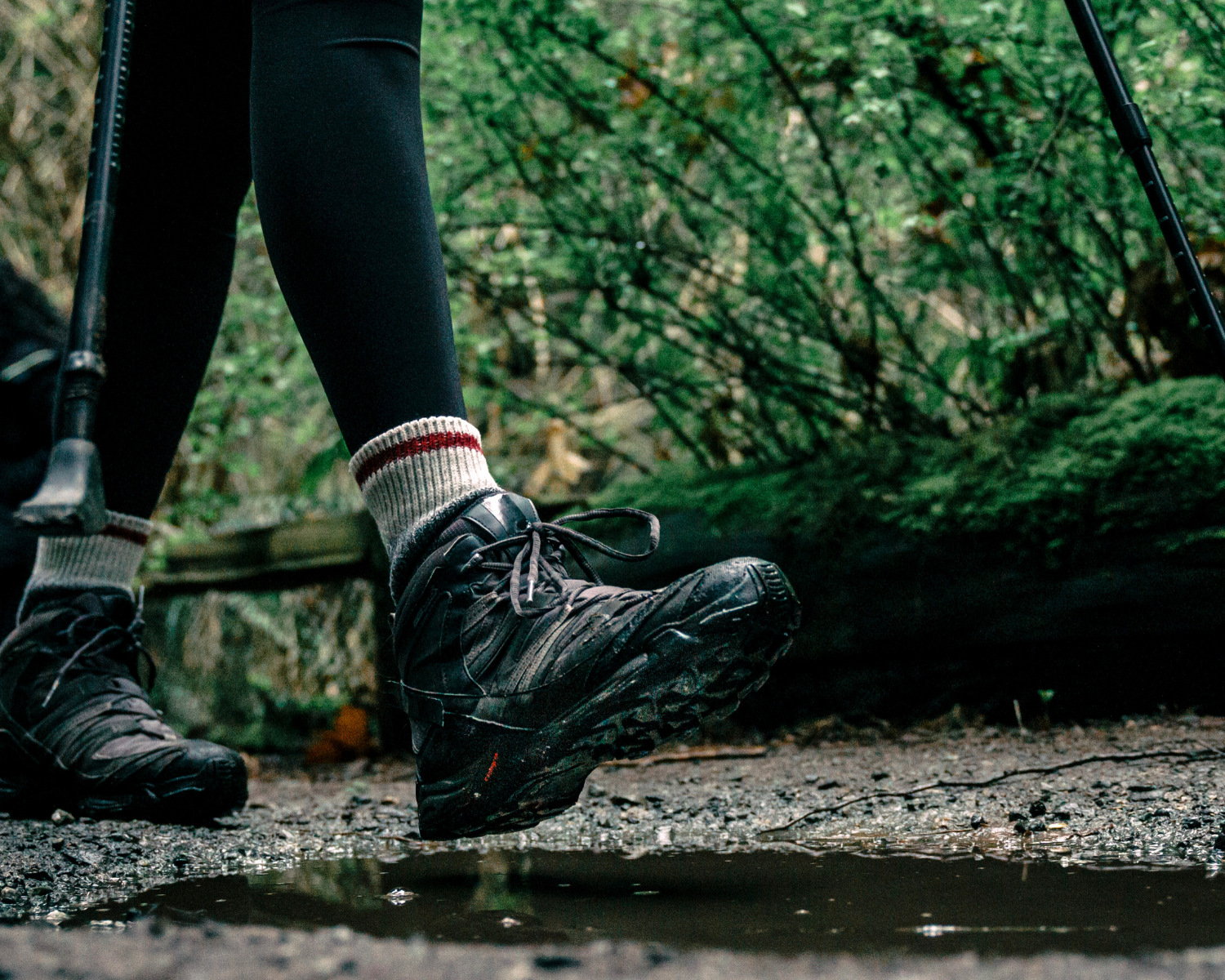
How to Choose the perfect pair of Trekking Shoes?
Sarthak Madan 21 May 2021
<p><span style="color: #000000;">Your choice of trekking shoes can make your trek a blissful or blister-full experience based on how well it fits you. A good pair of trekking shoes is the most essential piece of equipment you will use while hiking.&n

Campcraft Basics : How to Pack your Rucksack
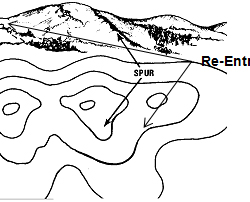
10 Mountain features that must be a part of any trekker’s vocab!
Experiential.
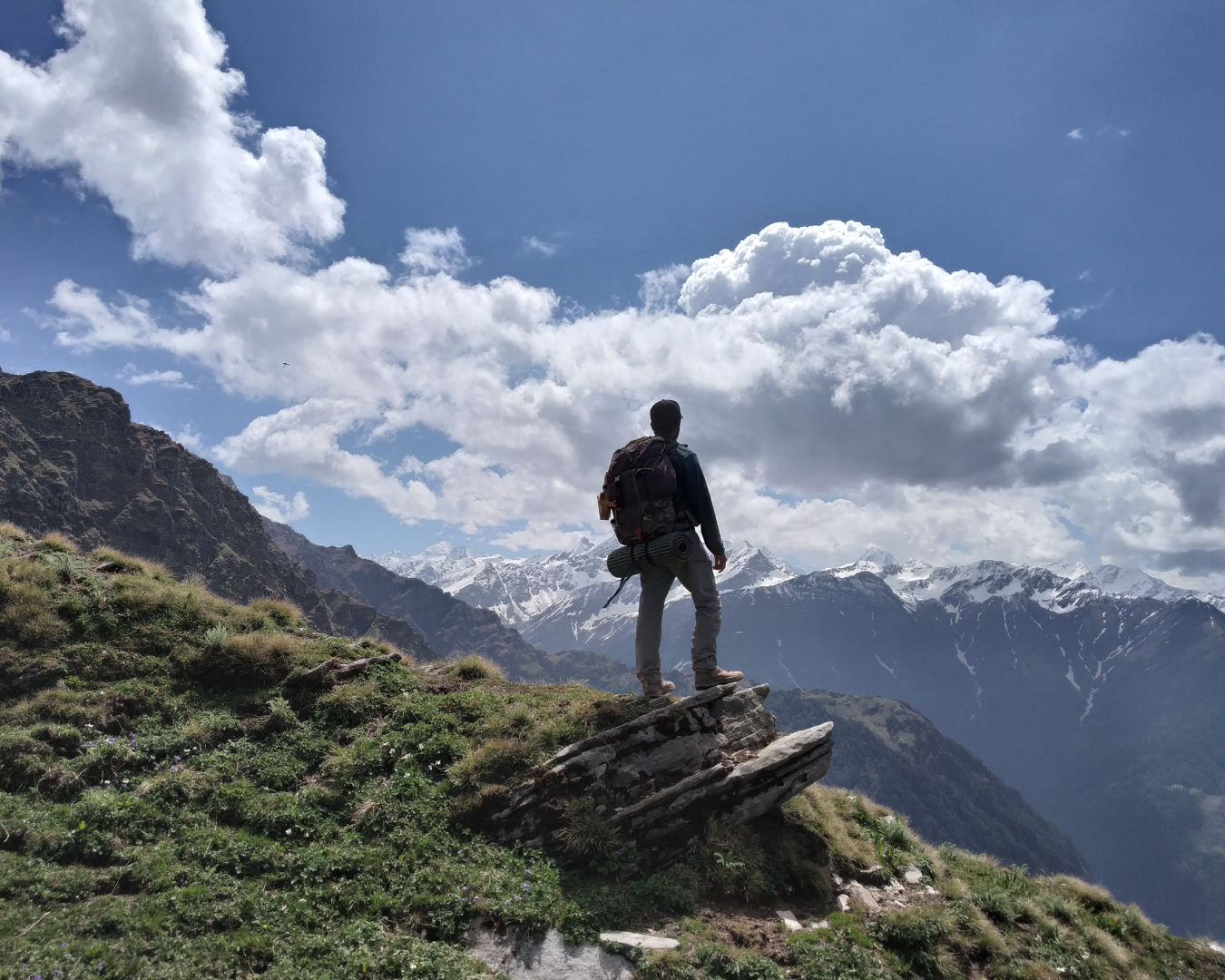
BARAADSAR LAKE: THE RABBIT OUT OF A HAT: A PHOTO STORY
Informative.
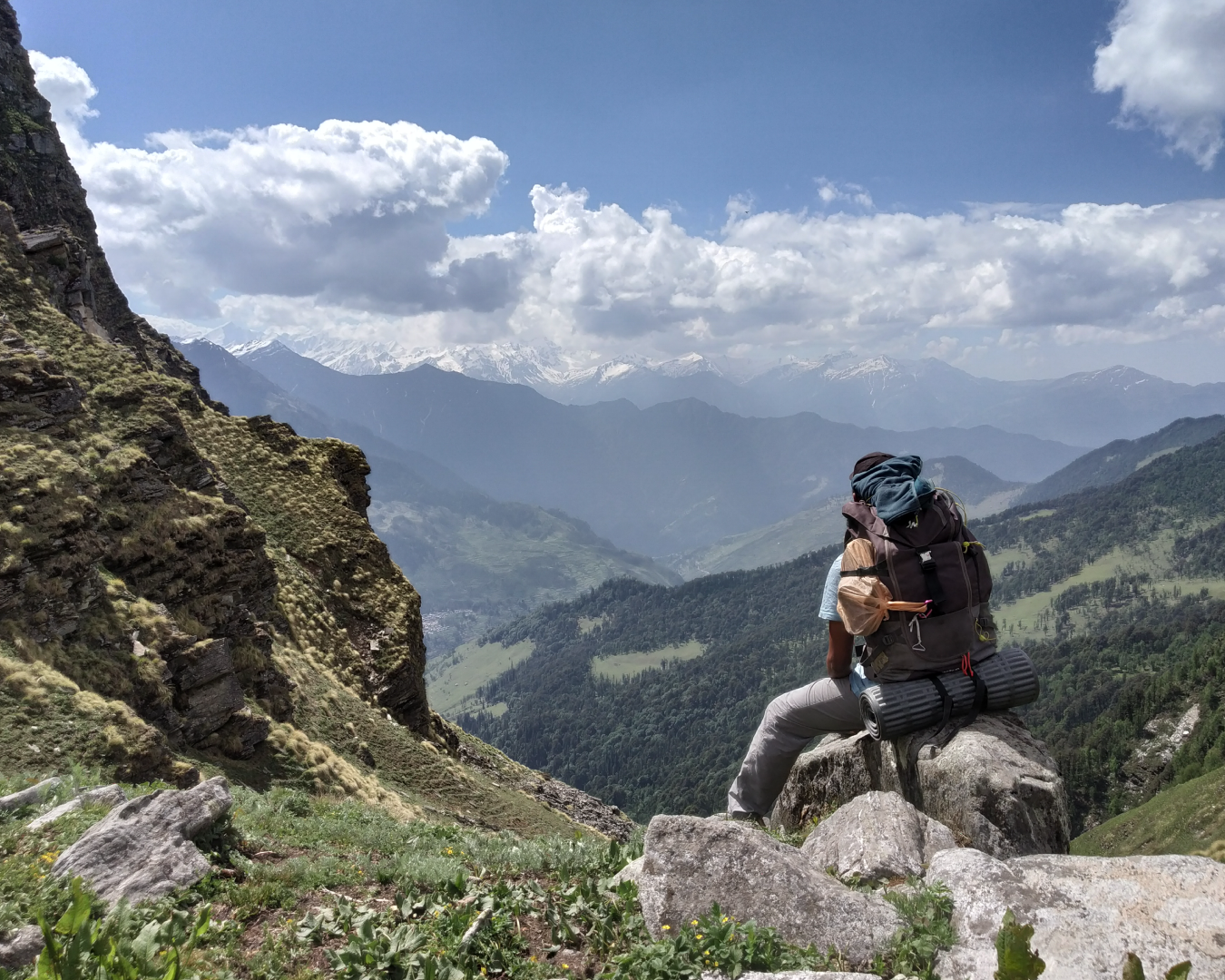
HIGHLIGHTS OF BARAADSAR LAKE
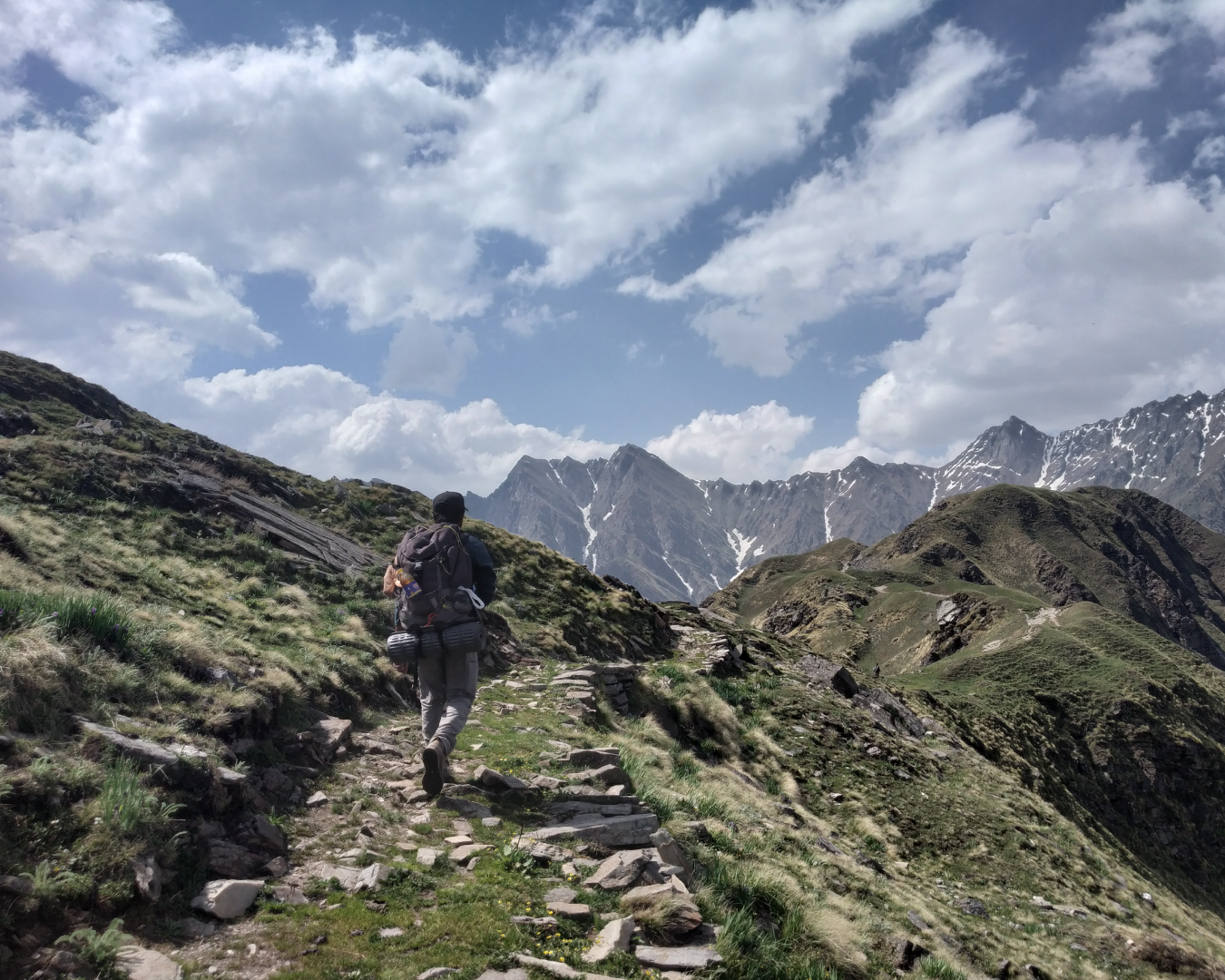
Baraadsar lake: Who is this trek meant for?
Enter your email, certifications.

Events by Month
- January July
- February August
- March September
- April October
- May November
- June December
Events by Activity
- Popular Treks
- Aspirational Expeditions
Events by Grade
Events by duration.
- 5 & more Nights
Bikat Adventures
- Environment Policy
- Privacy Policy
- Terms & Conditions
- Work With Us
- Address: 303, 3rd Floor, Tower B4, Spaze Itech Park, Sector 49. Gurgaon
- Pre Sale - 7838148127 , Post Sale - 8588878499, 9667639126
- Cancellation & Refunds
- Content Sharing
We are Social
Payments we process, submit enquiry.

Nanda Devi Milam Glacier Trek
Quick informations.
- 📅 Duration: 14 days 14 nights
- 🔼 Highest Altitude: 4196m
- 🛑 Grade: Moderate + ( know trek grades )
- 👍 Best Time: May, Jun, Sep, Oct
- 🏃 Activity Type: Trek
- 🔄 Trail Type: Same Exit Entry Point
- 🚩 Starts From: Munsiari
- 🚩 Ends In: Munsiari
- 🌏 Region: India - Uttrakhand
- 🎌 Country: India
- 🛪 Nearest Airport: Pantnagar, Uttrakhand
- 🚉 Nearest Rail Head: Kathgodam, Uttrakhand
Key Geographical Highlights
Daywise itinerary for nanda devi milam glacier trek, ▼day 1 arrival day munsiyari.
Prapare for a long but picturesque, interesting, engaging, colourful and a long tiring journey to Munsiyari. We are expected to reach by evening where our team waits to receive us and keep things ready for us.
▼Day 2 Rest Day Munsiyari
Munsiyari is a beautiful little hamlet with boasting views of the Panchachuli group of peaks. Spending the day here not only recovers our last day's tiring journey, but also gets us in sync with the mountain life. We also find some important time to resolve some paperwork and permissions with the administration.
▼Day 3 Trekking Day Lilam
After breakfast, we board the jeep to take us to the road head from where we start the trek. A sharp descend till Jimighat and then gentle climb following the Gori Ganga to reach Lilam village.
▼Day 4 Trekking Day Bogudiyar
The day starts with steep climb up to the famous Nain Singh Top which offers good view of the the surrounding mountains. A sharp descend follows to meet the mule track near Rargari, from where the route follows the gentle climb keeping Gori Ganga on your right to reach Bougudiyar marked with ITBP camps. Its a long but rewarding day.
▼Day 5 Trekking Day Martoli
A long picturesque trail climbing gradually following the Gori Ganga. Martoli is a beautiful meadow with some of the best views of Nanda Devi and other peaks. It has few very old houses of the local Bhotias. The trek is gentle, but longer. We may spend the night at Rilkot too if we are tired, but Martoli is a very desired campsite to spend the night and an exploration extra day. We will come back here on return too.
▼Day 6 Trekking Day Ghangar
A gradual climb to Ghangar from Martoli.
▼Day 7 Trekking Day Pachu Glacier
Today we leave the Gori Ganga river and turn left following the Pachu river to its snout. We camp there. The day offers close view of the divine peak of Nanda Devi. This was the first climbing route taken by Longstaff to climb this peak but with failure.
▼Day 8 Trekking Day Milam
Today, we ease out in this lovely campsite and explore the corners. By afternoon, we leave for Milam village. It will give us more days to explore Milam.
▼Day 9 Exploration Day Milam
Explore Milam Glacier and its snout. Have a relaxing day seeping in the views and Himalayan geography
▼Day 10 Trekking Day Martoli
Trek back to Martoli. Start early to have some time in hand to explore Martoli
▼Day 11 Trekking Day Bogudiyar
Retrace the same trail
▼Day 12 Trekking Day Lilam
▼day 13 trekking day munsiyari, ▼day 14 trekking day kathgodam.
Our trek ends. We drive back to Kathgodam
Nanda Devi Milam Glacier Trek - Package & Cost Details
▼ cost terms.
Must Read - Important Pre-Booking Information
▼ Fixed Departure Dates
We do not organize fixed departures for this trip.
If you want to do this trek with us, please fill this form to Request A Customized Private Trip Plan just for your team members. We will get back to you with all the details specific to your personalized requirements
▼ Cancellation Policy
When should you book.
We typically get booked about 3 - 6 months in advance. It is advisable to book this much in advance as you get early bird discounts and also your travel costs like flights/hotels/trains etc are much cheaper and confirmed if you book well in advance.
Rules Of Cancellation:
If cancellation is done:
- Up to 30 days or more before the trek start date - Full Refund of the total paid amount
- Between 30 days to 20 days before the trek start date - 50% refund of the invoiced amount . 50% of the invoice amount will be charged as a cancellation penalty.
- Between 20 days to 0 days before the trek start date - No refund. Free rescheduling or transfer of slots is allowed as specified below.
- Transfer Of Slot to a Different Batch/ Trek : No Loss Of Money, valid up to 1 year from the Invoice date. It can be availed up to 20 days before Trek Start Date by sending an email.
- Transfer of Slot to Friend/ Family For Same Batch: No Loss Of Money, valid up to 1 year from Invoice date. It can be availed up to 7 days before Trek Start Date by sending an email.
- Validity : This rule is only applicable for treks between 4000 to 6000 meters of any grade
Find detailed info on Cancellation & Refund Policy

Sunanda Devi or Nandadevi East Base Camp trek with Milam glacier is one of the best available treks in the Kumaun Himalayas of Uttrakhand. The starting point of the trek - Munsiyari itself is a ...
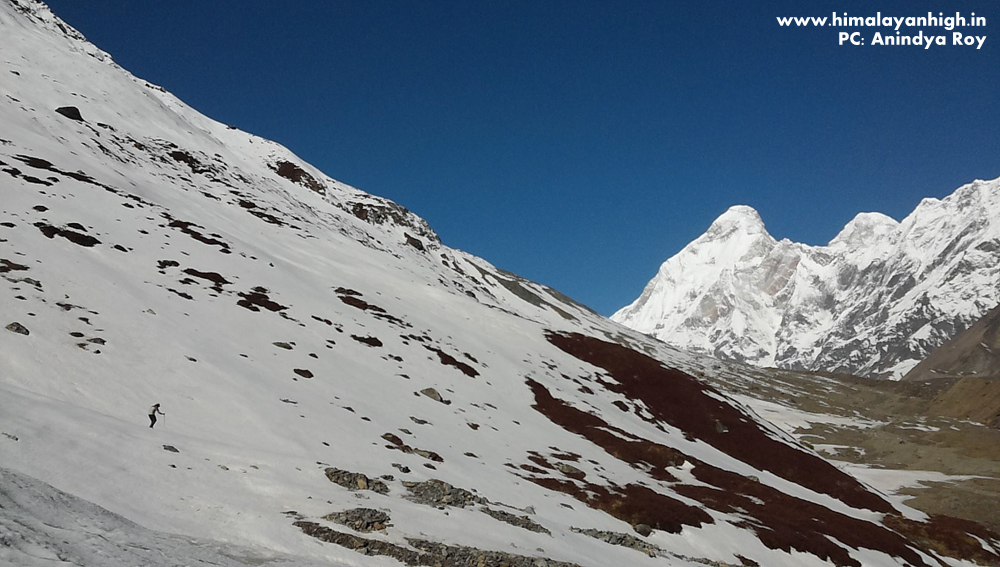
Sunanda Devi or Nandadevi East Base Camp trek with Milam glacier is one of the best available treks in the Kumaun Himalayas of Uttrakhand. The starting point of the trek - Munsiyari itself is a very beautiful hamlet in the lap of the Himalayan peaks.
The 5 peaks of Panchachuli, twin peaks of Nandadevi, Trishuli, Hardeol, Nandakot, and glimpses other peaks including those of the neighboring Nepal makes this trek a wonderful and picturesque journey.
Milam glacier is the source of the river Gori Ganga and is one of the biggest glaciers of the region. The glacier is fed by 7 other glaciers namely Timphu glacier, Sakram glacier, West Bamchu glacier, Mangraon glacier, Surajkund glacier, Ikualari glacier, Bilanlari glacier.
The village of Milam, Lilam, Martoli, Pachu and other villages on the route gives lot of insights into the local life and culture. It is perhaps the best way to explore the Kumaon Himalayas and also understand the Himalayan geography

Nanda Devi Milam Glacier Trek - Why Its A Must-Do
- Nandadevi is India's highest 'self-owned' peak at 7816 meters. Its an elegant looking mountain with its signature peak.
- Nandadevi East is one of the twin peak of Nandadevi at 7434 meters
- Milam glacier, the source of Gori Ganga and the largest glacier of the area. It is fed by 7 other parallel glaciers namely Timphu glacier, Sakram glacier, West Bamchu glacier, Mangraon glacier, Surajkund glacier, Ikualari glacier, Bilanlari glacier
- Beautiful view of Trishuli, Nandakot, Nandadevi, Hardeol, Mangraon, Sakram, Bamchu, Deo Damla, Latu Dhura, etc and other peaks of Nepal
- An excellent oppurtunity to experience some of the most remote villages of Kumaon Himalayas and its landscape
- Aditionally, explore the deep valleys of Shalang and Lawan gad
- introduction
- geographical info
- detailed itinerary
- elevation profile
- package Details
- common questions
- contact info
- description
- key highlights
+91 8017216725
+91 9434062849
Write To Us
WhatsApp Us
Best summer destinations : Chopta - Nainital - Mussoorie - Kanatal - Dhanaulti - Chakrata - Auli - Kausani - Mukteshwar - Chaukori - Pangot
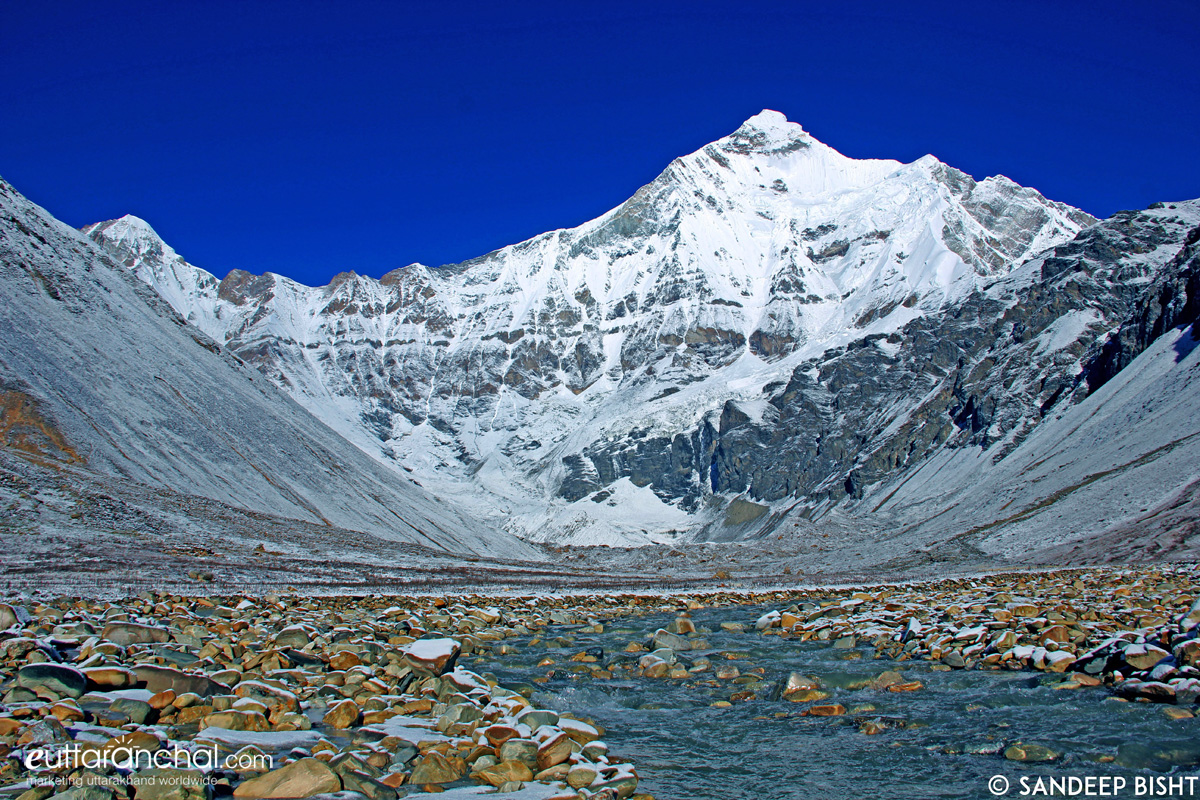
- Nanda Devi Base Camp
- Uttarakhand
- Uttarakhand Tourism
- 1 Tour Packages
- Send Enquiry
Nanda Devi East Base Camp Trek
The Nanda Devi is one of the most gigantic and gorgeous peaks in India. It is the second-highest peak in the country and the 23 rd highest peak in the world. The Nanda Devi Base Camp Trek will also take you on a ride in the midst of the resplendent biosphere of The Himalayas.
Nanda Devi East Base Camp is the closest to reach by a trekker to admire the beauty of Nanda Devi and Nanda Devi East peaks.
Get Nanda Devi East Base Camp Trekking Guide, Trek Route, Travel Tips
- Nanda Devi Base Camp Tour Packages
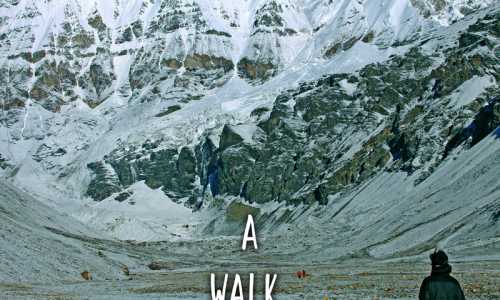
- Tour Packages
- How to Reach
The peak of Nanda Devi and the mountains surrounding it were closed in 1983 to preserve and protect its fragile ecosystem. The area around is the Nanda Devi National Park which is declared as a World Heritage Site by UNESCO. The trek to the Nanda Devi Base Camp is a difficult trek of 9 to 12 days depending on your trek guide.
This trek of Nanda Devi Base Camp will provide you a glimpse of many enormous Himalayan peaks. This trek leads you to the base camp on the eastern side of the peak which is also the home to Panchu Glacier. You will get to witness the rich biodiversity of this place with a sneak peek in the lives of the Himalayan people.
Chasing Nanda Devi Base Camp Video by eUttaranchal
Best Time to Travel to Nanda Devi Base Camp Trek
The Best Time to Travel the Nanda Devi Base Camp Trek is during the months of May to June & September to October. During this time the weather is bearable as it is neither to cold nor too rainy, which makes trekking in this region a bit easier.
Nanda Devi Base Camp Travel Tips
- This trek should be taken by regular trekkers as it is a tough trek, and adequate preparation is a must.
- Horses and mules can carry stuffs till Martoli only, after that only porters can carry equipments.
- Munsiyari is the last market from where you can buy ration, vegetables, fruits, medicines, etc
- Try to make all important calls in Munsiyari, after that Network do not work
Suggested Itinerary of Nanda Devi East Base Camp Trek
Day 1- Kathgodam-Munisiyari (2290 mtrs): Drive - 278 kms
- Arrive at Kathgodam from your respective city, you can travel by bus or train as Kathgodam is well connected to railways and roadways across the entire Uttarakhand. Then travel on your journey to Munsiyari while passing by the lush grandeurs of the Himalayas.
- Stay overnight at Chaukori and explore the place as it is very famous for its tea gardens and iconic views of The Himalayas.
Day 2- Munsiyari – Lilam (1850 mtrs) : Trek - 7 kms
- The trek begins from a small trek from Munsiyari to lilam which is a small winter village of this area.
- Stay overnight at Ilam.
Day 3- Lilam – Bogudiar (2609 mtrs) : Trek - 12 kms
- Trek through the forest of Utees, where the small rivulets of Ralam and Goriganga meets.
- Keep following the way, you will arrive at a point where the Goriganga meets the river Poting, marking the village Bogudiar, stay overnight here.
Day 4- Bigudiar – Rilkot (3130 mtrs) : Trek - 12 kms
- The Trans-Himalaya trek begins from here while you will head towards Rilkot.
- A short diversion on the way to the Lapsa Village to visit the Northern Nanda Kot Glacier. Keep trekking you will reach the Village Rilkot where you can stay overnight by the river.
Day 5- Rilkot – Ghanghar (3300 mtrs): Trek - 13 kms
- Start from Rilkot, at a distance you will find the Martoli Peak, which will open up the view of the true form of the Trans-Himalayan landscapes.
- Walking in the midst of the meadows you will arrive at the village Ghanghar. This village marks the beginning of the Panchu Valley which eventually leads to Nanda Devi base camp. Explore the culture of this area and stay overnight at this village.
Day 6- Ghanghar – Panchu Glacier (4000 mtrs) : Trek - 7 kms
- The steep trek to Panchu Glacier begins on this day. You will pass by the Rhododendron trees where the peak seems to loom closer and closer.
- After trekking for about 5 hours and 7 kms you will discover the Panchu Glacier on the Northern face of Nanda Devi. Stay overnight here.
Day 7- Explore the Nanda Devi Base Camp
Watch the beautiful sunrise at the Nanda Devi Peak from here. Walk up and down the glacier and get a very clear and beautiful view of the Nanda Devi Peak.
Day 8- Panchu Glacier – Martoli : Trek - 17 kms
- You will trek downhill for a while before having an uphill trek at a distance.
- The town of Martoli falls on an important ancient trade route, therefore you will see a number of houses with many ancient wood carvings. This town is also famous for getting the unbeatable views of the Nanda Devi east and the Nanda Kot. Stay here overnight.
Day 9- Martoli – Rargari : Trek - 20 kms
- The trek will take you towards Munsiyari as you arrive at Rargari, where you will stay overnight.
Day 10- Rargari – Munsiyari : Trek - 14 kms
You will travel on your way back to Munsiyari, where you will stay overnight.
Day 11- Munsiyari – Kathgodam : Drive - 278 kms
It is the day of departure. You will travel to Kathgodam from Munisyari. You can halt at Chaukori for refreshments and further move ahead to Kathgodam from where your trekking journey will end and you can head out to your hometown.
Trail Type: Circular trail which starts and ends at Munsiyari. The trail is slippery and prone to landslides in many areas.
Nanda Devi Base Camp Photo Gallery
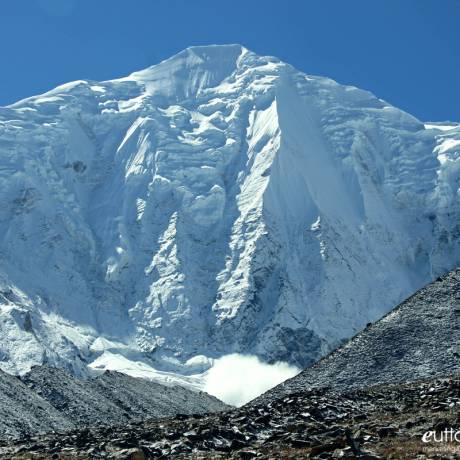
- Nanda Devi Base Camp Travel Guide
- How to Reach Nanda Devi Base Camp
- Nanda Devi Base Camp FAQs
- Nanda Devi Base Camp Photos
What is Nanda Devi Base Camp famous for?
Nanda Devi Base Camp is famous among tourist as Trekking, Expedition, High Altitude Trek, Camping, Kumaon Trekking.
Nanda Devi Base Camp is popular destination for following activities/ interests - Adventure , Base Camps (Trek) , Trekking .
Plan your Trip
Uttarakhand travel update.
Char Dham yatra will start from 10 May 2024, Bookings Now Open! Check Char Dham Tour Packages - Hotels in Badrinath - Char Dham Yatra by Helicopter - Kedarnath Helicopter Booking Guide - Char Dham hotels
Char Dham Closing Dates: Gangotri , Yamunotri and Kedarnath dhams are closed now. Badrinath temple will be closed 19 Nov. Check out Char Dham Yatra tours : Char Dham News . Char Dham Registration is compulsory for visiting Char Dham Temples. Check Kedarnath Helicopter Ticket booking guide .
Traveling to Uttarakhand? Check out Uttarakhand Covid Stats , Uttarakhand Travel Guidelines and Uttarakhand Travel News
Char Dham Update: Gangotri , Yamunotri , Kedarnath and Badrinath are open for pilgrims. Check out Char Dham Yatra tours : Char Dham News . Char Dham Registration is compulsory for visiting Char Dham Temples. Check Kedarnath Helicopter Ticket booking guide .
Last Updated: 26 Apr 2024
Nanda Devi Base Camp overview
- Best time to visit Nanda Devi Base Camp Jun, Aug, Sep,
- Starts from Munsiyari
- Trek grade Tough
- Trek duration 6-10 Days days
- Located in Chamoli, Garhwal
- Famous for Trekking, Expedition, High Altitude Trek, Camping, Kumaon Trekking
Travelling to Nanda Devi Base Camp in 2024?
Contact us for planning your Nanda Devi Base Camp tour with best travel packages of as per your requirements!
- Char Dham Yatra
- Char Dham Packages
- Chopta Tourism
eUttaranchal
- Uttarakhand Tour Packages
- Uttarakhand Hotels
Customer Service
- Return, Cancellation & Refund
- Privacy Policy
- Terms of Use
Business Connect
- List your Package
- List your Hotel
- Send Feedback
- Nainital - Musoorie
- Haridwar - Rishikesh
- Chopta - Tungnath
- Badrinath - Kedarnath
- Auli - Joshimath
- Kedarkantha - Har ki Dun
- Corbett - Binsar
- Badrinath Hotels
- Kedarnath Hotels
- Nainital Hotels
- Rishikesh Hotels
- Mussoori Hotels
- Chopta Hotels
- Corbett Resorts
- Adi Kailash Packages
- Valley of Flower Tours
- Kumaon Tours
- Badrinath Packages
- Kedarnath Packages
- Chopta Packages
- Nainital Packages
- Valley of Flowers - Hemkund Sahib
- Kuari Pass Trek
- Satopanth Trekking
- Phulara Ridge Trek
- Brahmatal Trek
- Panchachuli Base Camp Trek
- Nag Tibba Trek
Get Customized Tour Package
- +91 9611102222
- [email protected]

- Upcoming Treks Two Day Treks One Day Treks Karnataka
- Himalayan Treks
- We also offer Corporate Outings Member Registration
- About Our Company Our Social Responsibility Career @ BMC BMC Building a Team in Chennai Contact us

- Nanda Devi Base Camp Trek - Himalayas
- Need help for booking
- Himalayan Treks & Expeditions
- Himalayan Treks in Uttarakhand
About Place: The people of Johar, as the Milam valley is locally known, were traders whose caravans crossed from India into Tibet by the high passes of Unta Dhura and Kungribhingri La. Once the trading season was over the entire population of Milam and the surrounding areas migrated to Munsyari or lower during winter. Trade stopped with the Indo-China conflict of 1962 and these once prosperous villages are now deserted. However the trail still exists, linking the villages and beckoning trekkers. Munsyari is the starting point of Nanda Devi Trekking and OSHIN offers you a combined itinerary that includes a visit to the Nanda Devi base camp area followed up by a trip to Milam glacier. Initially five days of walking takes you to Pachu (3950 mts, 60 kms) the base camp area for Nanda Devi East. The location is exquisite and we usually spend a full day over here. We then return from Pachu to camp at Burfu, across th Gori Ganga river. From Burfu we ascend to Milam where we spend a day and then return to Munsyari. We are sure that Trekking In Nanda Devi will be the most cherish moment of your life.
Trip Highlights:
Duration : 12 Days 11 Nights
Activity Type : High Altitude Trekking
Highest Altitude : 4150m
Grade : Moderate to Difficult
Best time : June-July / September-October
Starting Point : Kathgodam Railway Station
Ending Point : Kathgodam Railway Station
Region : Uttarakhand - Himalayas
Group size : 15 People
Few important points to note before you decide to register:Click Here
What is included in the tour.
Cost Includes:
- Camping Tents, Kitchen tents, Dining Tent and Sleeping bags (Holofill) and Carry mats.
- Nutritious, high calorie vegetarian food
- Transportation from Kthgodam to Munsyari.(Day-1)
- Guide, cook and camp helpers.
- Tented accommodation (3 people in each tent)
- Basic First Aid
- Forest Permission Charges
- Coordinator throughout the trek
- Transporttaion from Munsyari to Kathgodam ( Day-12)
- Insurance
What is NOT included in the tour
Cost Excludes:
- Any expenses of personal nature like phone call etc
- Any air/train to reach Delhi and return from Delhi.
- Travel from Delhi to Kathgodam.
- Any hotel accommodation
- Horses with horsemen to carry your loads on the route.
- Your Accommodation or any other expenses before or after the trek schedule.
- Extra food apart from mentioned above
- Anything not mentioned above.
- Backpack 35- 40 Liters (You can chose to send it with horse/porter at actual cost)
Things to Carry List:
Backpack (55,65 L) with sturdy straps and supporting frame. Quechua Forclaz 60 is a good choice.
Daypack (20-25 L) optional. Useful for summit/pass day, handy if you want to offload your backpack on the trek.
Trekking shoes Sports shoes are an absolute NO in trekking. You need Traction on Snow and Sport Shoes with PVC soles hardly justifies the choice. Ensure the shoes are well used before the trek. Forclaz 500 and Woodland are good choices.
3 pair of track pants (at least one should be synthetic quick-dry kind). Or 3 pair of cotton pants with lots of pockets. Track pants are light and we highly recommend them. Plus when things get really cold then layers of clothes matter.
3 cotton t-shirt with collar. Avoid bright colours like red and fluorescents. Stick to lighter tones. There are plenty of Birds and Animals one would come across while trekking and you won�t want them to get scared with your dressing sense.
One full Sleeve Sweater. A fleece jacket would be an alternative.
A full sleeve thick Jacket.
4 pairs of Undergarments.
1 pair of Thermal Inners.
4-5 pair of Sports Socks.
Woolen Monkey cap/Balaclava that cover the ear.
Light weight Rain Coat/Poncho (to escape a quick burst of rain).
Hand Gloves (water proof).
Sunglasses Buy the one which will cover your eyes well. Choose from Black, Green, Brown. Blue coloured Sunglass cannot block UV rays.
Avoid multi toned ones too. Sunglasses prevent snow blindness, and are mandatory for treks.
Sun Cap and/or Head-Scarf.
Trekking Pole is mandatory.
Light towel (a quick drying kind).
Chap stick or Lip Balm.
Cold Cream and Sun Screen Lotion (SPF 40+).
2 Water bottles (1 L each). Do not carry packaged water bottles.
LED torch with extra set of cells/ Head Lamps (preferred).
Personal Toilet Kit (minimal) and Toilet Paper.
Small Repair Kit consisting of Safety Pins, Needle, Thread and String (mandatory).
Slippers/Sandals (for walking around campsite).
While there are adequate food provided on trek, some do feel very less energetic compared to others. So you can carry few energy bars,dry fruits, etc
Camera, writing or recording material to log your experience.
Note : 1] Permit for Inner Line will be require so need two photo with ID proof.
2] Itinerary can be changed, in case of snow, rainfall and landslides.
Tentative Schedule:
Day - 1 Kathgodam to Munsyari (Altitude: 6500 ft, Distance : 290 Kms, 9-10 Hours Drive)
Reporting at Kathgodam Railway Station at around 06:30AM (You are expected to reach Kathgodam on previous night). We will meet up there & proceed to Lohajung which is around 290 kms and 9-10 hours drive.On the wy we will be waiting for breakfast and Lunch. Reach Munsyari, Introduction, Briefing & Overnight stay at camp.
Day - 2 Munsyari to Lilam ( Altitude:6070ft, Trekking distance - 15km, 6/7hrs trek )
Early morning after finishing the breakfast, we will travelling towards the starting point of the trek by jeep .From Darkot village we start descending towards Jimighat and from there gentle climbing up till Lilam village via Gori Ganga.Overnight stay in tents .
Day - 3 Lilam to Bugdyar ( Altitude: 8100ft, Trekking distance - 14km, 6/7 trek )
This day's climb was a crucial one. The trail now began uphill towards the Nain Singh top with beautiful landscape along with a large view of Bugdyar Meadows. It takes a Minimum of 6/7hrs to reach to the top of Bugdyar. Overnight stay in tents.
Day - 4 Bugdyar to Railkot - Martoli ( Altitude: 11000ft, Trekking Distnce - 15km, 8/9hrs trek )
Woke up early in the morning and we continue our trek along with the Gori Ganga. This range also has some beautiful water streams along with the icy-cold water.The initial part of the trek would be through the bank of the river through the rocks. A gradual ascent that offers excellent views of the snow-covered mountains Nanda Devi and thers peaks ! Overnight stay in tents .
Day - 5 Martoli to Ghanagar ( Altitude: 11200ft, Trekking Distance - 14km, 8/9hrs trek )
Steep 3 hour ascent followed by a steep descent followed a gentle up and down walk. The trail crosses the stream and heads up the mountain.Overnight stay in tents.
Day - 6 Ghangar to Panchu Glacier ( Altitude: 13200ft, Trekking Distance - 10km, 7/8hrs trek )
Medium climb to Glacier 13,200ft. The days trek is a long walk on meadows with the scenery changing for the better all along.From this point you can see magical close view of Nanda Devi peak !! Overnight stay in tents.
Day - 7 Panchu to nanda devi base camp and back to Panchu ( Altitude: 15200ft, Trekking Distance - 16km, 8/9hrs trek )
The climb continues to the Nanda Devi Base Camp. While the route on the Nanda Devi trek will take most of the time, the return is a fairly easy descent.We retrace the same trail back to panchu.Overnight stay in tents.
Day - 8 Panchu to Railkot ( Altitude: 11000ft,Trekking Distance - 16km, 8/9hrs trek )
Return to the pasture at Railkot on the same trail that was taken on the way up.Overnight stay in tents.
Day - 9 Railkot to Bugdyar ( Altitude:8100ft,Trekking Distnce - 15km, 8/9hrs trek )
From the Railkot campsite head down along the stream towards the tree line.Dont walk beside the stream but walk along the ridge on the right.Overnight stay in tents.
Day -10 Bugdyar to Lilam ( Altitude:6070ft, Trekking distance - 15km, 6/7hrs trek )
The days trek is a killer on your toes and knees.Looking behind at the opposite mountains, spot the Gujjar huts amidst the tall pines. You will not fail to notice the bareness of the mountains here and the greenery on the other side.Overnight stay in tents.
Day - 11 Lilam to Munsyari ( Altitude:6070ft, Trekking distance - 15km, 6/7hrs trek )
The last stretch of the last day does become an endurance test but soon the stone paved village track comes up and in no time you enter the main road of Munsyari Village.Overnight stay in Guest House / Tents.
Day - 12 Munsyari to Kathgodm ( Distance : 290 Kms, 9-10 Hours Drive)
Depart from Munsyari to Kathgodam (9-10 Hrs. drive).On the way we will stop for Lunch .Expected time to reach Kthagodam is 6 to 6.30pm.
Trips end here with Lifetime beutiful Memories !!!
Note: 1] There is a different permission charge for Foreigner & the difference amount should be paid by the participant on spot.
3] We advice you keep a extra day and plan your travel because the weather in the himalaya is unpredictable.
- INCLUSIONS/EXCLUSIONS
- THINGS TO CARRY
OTHER POPULAR TOURS

Kashmir Great Lakes Trek, Himalayas - 2023

Trek to Hampta Pass

Mt.Yunam Trekking Expedition
OTHER ACTIVITIES

- Dispute Resolution
- Privacy Policy
- Terms & Conditions
- Cancellation Policy

- May 12, 2023
- 38 min read
Conquering the Mighty Nanda Devi East: A Himalayan Adventure of Epic Proportions
Updated: May 20, 2023
Standing tall and proud in the Indian state of Uttarakhand, Nanda Devi East is a majestic peak that has beckoned mountaineers and adventure enthusiasts for decades. With its soaring altitude, challenging terrain, and awe-inspiring beauty, an expedition to Nanda Devi East promises an unforgettable journey into the heart of the Himalayas. Join us as we embark on a virtual exploration of this remarkable mountain and the incredible experience of a Nanda Devi East expedition .

The Enigmatic Nanda Devi East:
Nanda Devi East, with its elevation of 7,434 meters (24,390 feet), is the second-highest peak in the Nanda Devi Sanctuary, a UNESCO World Heritage Site. It is part of the Nanda Devi Biosphere Reserve, a protected area known for its rich biodiversity and pristine natural surroundings. The mountain's imposing presence and its remote location make it a challenging and coveted destination for mountaineers from around the world.
Expedition Highlights:
A Nanda Devi East Expedition demands technical climbing skills, physical endurance, and a spirit of adventure. The expedition typically begins in the picturesque town of Munsiyari, followed by a trek through lush forests, charming villages, and alpine meadows. As the altitude increases, the terrain becomes more rugged, and climbers face icy slopes, steep ridges, and crevassed glaciers. The final ascent to the summit involves technical climbing, including rock and ice climbing, making it a thrilling and demanding endeavor.
Pristine Natural Beauty:
Throughout the expedition, trekkers are treated to awe-inspiring vistas and breathtaking landscapes. The trail winds through diverse ecological zones, including dense forests of oak and rhododendron, cascading waterfalls, and tranquil alpine meadows adorned with vibrant wildflowers. As climbers ascend higher, the views open up to reveal towering snow-clad peaks, deep valleys, and the vast expanse of the surrounding Himalayan range.
The Nanda Devi Sanctuary:
The Nanda Devi East expedition takes place within the Nanda Devi Sanctuary, a pristine alpine haven that is home to a remarkable array of flora and fauna. The sanctuary boasts rare and endangered species such as the Himalayan musk deer, Himalayan tahr, and elusive snow leopard. The undisturbed ecosystem and the sheer beauty of the sanctuary add an extra layer of enchantment to the expedition, making it a truly immersive experience in nature's lap.

A Triumph of Endurance and Teamwork:
Reaching the summit of Nanda Devi East is not merely a physical accomplishment but also a testament to the power of teamwork, determination, and resilience. Climbers must navigate challenging conditions, acclimatize to high altitudes, and overcome their own limits. The camaraderie and support among team members foster a sense of unity and shared achievement, forging lifelong bonds and memories.
The Nanda Devi East Expedition begins in the picturesque town of Munsiyari, located in the Pithoragarh district of Uttarakhand, India. Munsiyari serves as the base camp for the expedition, and from there, climbers embark on a multi-day trek through lush forests, rugged terrain, and charming Himalayan villages. The trek serves not only as a physical warm-up but also as an opportunity to acclimatize to the high altitude and immerse oneself in the breathtaking natural beauty of the region.
As the climbers advance towards the base camp, the landscape transforms into a rugged alpine terrain, characterized by towering peaks, glaciers, and deep valleys. The Nanda Devi Sanctuary, a pristine and protected area, comes into view, adding an air of mystique and reverence to the expedition. The sanctuary is renowned for its rich biodiversity, housing several rare and endangered species of flora and fauna.
Upon reaching the base camp, climbers are faced with the awe-inspiring sight of Nanda Devi East towering above them. The mountain presents a formidable challenge, with its steep and icy slopes, unpredictable weather conditions, and technical climbing sections. The ascent requires advanced mountaineering skills, including ice climbing, glacier travel, and rope techniques.
Climbers typically establish multiple high camps on their way to the summit, each serving as a temporary home as they progress higher into the thin air. The acclimatization process becomes crucial as climbers adapt to the extreme altitude, where oxygen is scarce, and the body is pushed to its limits. The expedition demands physical endurance, mental resilience, and meticulous planning to navigate the technical sections and overcome the inherent risks associated with high-altitude mountaineering.
One of the highlights of the Nanda Devi East Expedition is the breathtaking panoramic views that await climbers at every step of the journey. From the summit, one can witness the rugged grandeur of the Himalayan range, with peaks like Nanda Devi, Trishul, and Panchchuli dominating the horizon. The serenity and solitude of the mountains create an unparalleled sense of peace and accomplishment for those who brave the challenges and reach the pinnacle of Nanda Devi East.
However, it is important to note that the Nanda Devi East Expedition is not without its risks and challenges. The extreme altitude, unpredictable weather, avalanches, and crevasses pose significant threats to climbers. Therefore, prior experience in high-altitude mountaineering, physical fitness, and proper equipment are essential prerequisites for participating in this expedition. Safety precautions, including adequate acclimatization periods, experienced guides, and thorough risk assessment, are crucial to ensure a successful and safe journey.
Furthermore, it is essential to approach the expedition with a deep respect for the environment and local culture. The Nanda Devi region is not only a mountaineer's paradise but also a sanctuary of immense ecological significance. Climbers must adhere to the principles of responsible tourism, leaving no trace behind and minimizing their impact on the delicate ecosystem.
Know more about Nanda Devi
Nanda Devi is a prominent mountain peak located in the state of Uttarakhand, India. It is the second-highest mountain in India, with an elevation of 7,816 meters (25,643 feet). Nanda Devi holds a significant place in the hearts of mountaineers and nature enthusiasts due to its awe-inspiring beauty and challenging ascent.

The name "Nanda Devi" translates to "Bliss-Giving Goddess" in Hindi. It is believed to be named after the Hindu goddess Nanda Devi, who is revered as a deity of strength and protection. The mountain holds great spiritual and cultural significance for the local communities residing in the region.
Nanda Devi is part of the Nanda Devi Biosphere Reserve, which has been designated as a UNESCO World Heritage site. The biosphere reserve encompasses an extensive area, including the Nanda Devi National Park, the Valley of Flowers National Park, and surrounding areas. This region is known for its rich biodiversity, including rare and endangered species of flora and fauna.
The mountain's terrain is characterized by steep and rocky slopes, glaciers, and deep valleys. The challenging nature of Nanda Devi's ascent attracts experienced mountaineers from around the world. The first successful ascent of Nanda Devi was made in 1936 by a British expedition led by Bill Tilman and Noel Odell.
One of the most notable features of Nanda Devi is its distinctive twin-summit structure, with Nanda Devi East being the slightly lower of the two peaks. The mountain is known for its majestic beauty, often shrouded in clouds and surrounded by pristine alpine landscapes. Its snow-clad peaks, jagged ridges, and vast glaciers create a mesmerizing sight for those fortunate enough to witness it.
The climbing routes to Nanda Devi are known for their technical difficulty, requiring advanced mountaineering skills. The peaks' remote location, extreme altitude, and unpredictable weather conditions make the ascent even more challenging. Proper acclimatization, physical fitness, and careful planning are crucial for a successful and safe expedition.
Despite its allure, Nanda Devi is not easily accessible to all climbers. The Indian government has placed restrictions on climbing Nanda Devi since 1983 to protect the fragile ecosystem and preserve the mountain's pristine nature. Special permits are required, and climbers must adhere to strict guidelines and regulations set by the authorities.
Nanda Devi's surroundings are also home to indigenous communities, such as the Bhotiya and Rung tribes, who have a deep connection to the mountain and its natural resources. Their unique culture and traditions add to the cultural richness of the region.
For those who are unable or choose not to attempt the climb, there are other ways to experience the grandeur of Nanda Devi. Trekking routes, such as the Nanda Devi Inner Sanctuary and the Valley of Flowers, offer breathtaking views of the mountain from different angles. These treks take visitors through lush meadows, vibrant alpine flowers, and serene valleys, providing a glimpse into the mesmerizing beauty of the Himalayas.
In conclusion, Nanda Devi stands as a symbol of natural beauty, spiritual significance, and mountaineering excellence. Its towering peaks and rugged landscapes captivate the hearts and minds of adventurers, while it's ecological importance and cultural heritage inspire a sense of conservation and respect. Nanda Devi continues to be a beacon for those seeking to test their limits, connect with nature, and embrace the magnificence of the Himalayas.
Nanda Devi East Expedition Itinerary
Lata village is located in the Chamoli district of Uttarakhand in India. It is a remote village situated at an altitude of around 2,100 meters in the Garhwal Himalayas.
To reach Lata village, you can take a flight to Dehradun or Pantnagar airports, which are the nearest airports. From there, you can hire a taxi or take a bus to Joshimath, a town approximately 256 kilometers from Dehradun.
You can take a shared taxi or private jeep from Joshimath to Lata village. The drive is approximately 25 kilometers and takes around 2 hours.
It's important to note that the roads leading to Lata village are narrow and steep, and the drive can be challenging. It's recommended to hire an experienced driver or a local guide who can help you navigate the roads safely.
Alternatively, you can also trek to Lata village from Joshimath. The trek is approximately 25 kilometers and takes around 2 days. The trek offers stunning views of the surrounding valleys and peaks and is a popular option for adventure enthusiasts.

Here is a detailed itinerary for the Nanda Devi East Expedition:
Day 1: Arrive in New Delhi, India
Upon arrival in New Delhi, you will be greeted at the airport by a representative from the expedition team.
Transfer to a hotel in Delhi and check-in.
Take some time to rest and recover from your journey.
In the evening, attend a briefing session with the expedition leader and team members.
The briefing will provide you with important information about the expedition, safety protocols, and any last-minute preparations.
You will have the opportunity to ask questions and clarify any concerns you may have.
Enjoy a delicious welcome dinner with your expedition team and fellow climbers, where you can get to know each other and build camaraderie.
Overnight stay at the hotel in Delhi.
Please note that the Nanda Devi East Expedition typically begins in Munsiyari, so the itinerary for the subsequent days will involve traveling from Delhi to Munsiyari and commencing the trek.
Day 2: Delhi to Munsiyari
Day 2 of the Nanda Devi East Expedition begins with an early morning departure from Delhi towards Munsiyari. Munsiyari is a picturesque hill station located in the Pithoragarh district of Uttarakhand, nestled in the lap of the snow-capped Himalayas. The journey from Delhi to Munsiyari takes approximately 12-14 hours, depending on the road conditions and traffic.
Leaving Delhi, you will drive through the bustling cityscape and gradually transition into the serene countryside as you make your way towards the foothills of the Himalayas. The route from Delhi to Munsiyari takes you through several towns and cities, including Haldwani, Almora, and Pithoragarh, offering glimpses of the stunning landscapes and traditional mountain life.
As you ascend into the higher altitudes, the road becomes more winding and steep, offering breathtaking views of the surrounding valleys, rivers, and forests. The lush greenery gradually gives way to alpine forests and meadows, and the air becomes cooler and crisper with every passing mile.
Along the way, you will have opportunities to stop at scenic spots, small towns, and roadside dhabas (local eateries) to rest, refresh, and savor local delicacies. The journey itself is an adventure, as you navigate through narrow mountain roads and soak in the awe-inspiring natural beauty of the region.
Upon reaching Munsiyari, you will be greeted by the majestic views of the snow-covered peaks of the Nanda Devi range. Munsiyari is a popular base camp for treks and expeditions in the region, including the Nanda Devi East Expedition. Settle into your accommodation, which could be a guesthouse or a hotel, and take some time to relax and acclimatize to the higher altitude.
Before embarking on the Nanda Devi East Expedition, it is crucial to spend a day or two in Munsiyari for acclimatization purposes. This will help your body adjust to the high altitude and reduce the risk of altitude sickness during the expedition.
During your stay in Munsiyari, you can explore the local market, interact with the friendly locals, and soak in the tranquil ambiance of the Himalayan town. You may also take short hikes or visit nearby attractions like the Birthi Falls or the Maheshwari Kund.
As you conclude Day 2, make sure to rest well and prepare for the upcoming days of the Nanda Devi East Expedition, which will take you deeper into the mesmerizing landscapes of the region.
Please note that the driving time and distance mentioned are approximate and can vary depending on road conditions and traffic.
Day 3: Trek to Forest Camp (2,600m)
Day 3 of the Nanda Devi East Expedition begins with an early morning start from Munsiyari to embark on the trek towards Forest Camp. Forest Camp, situated at an altitude of 2,600 meters, serves as the first campsite on the route to Nanda Devi East.
The trek from Munsiyari to Forest Camp is approximately 9-10 kilometers and takes around 5-6 hours, depending on your pace and the trail conditions. The trail gradually ascends through dense forests, offering a mix of shaded paths and occasional glimpses of the surrounding valleys and peaks.
As you leave Munsiyari behind, the trail meanders through a variety of flora, including rhododendron forests, oak trees, and other alpine vegetation. The crisp mountain air and the melodious sounds of birds accompany you along the journey, creating a serene and peaceful atmosphere.
The initial part of the trek involves a moderate ascent, followed by a relatively flatter section as you traverse through the forested trails. You might come across streams or small waterfalls, providing refreshing spots to take a short break and replenish your energy.
Along the way, you may encounter fellow trekkers, local shepherds, or even spot some wildlife native to the region, such as Himalayan birds or mountain goats. The trail offers ample opportunities to appreciate the natural beauty of the area, with occasional panoramic views of the Himalayan peaks.
As you approach Forest Camp, the surroundings become quieter and more secluded. The campsite is typically set amidst the forest, providing a peaceful environment for resting and rejuvenating. Once you reach Forest Camp, you can settle into your tents or campsite, and the support staff will arrange meals for you.
Take this opportunity to rest, enjoy the serene surroundings, and soak in the tranquility of the Himalayas. It is essential to stay hydrated, eat nutritious food, and allow your body to acclimatize to the increasing altitude.
During your stay at Forest Camp, you can explore the nearby areas, take short walks, or indulge in some photography, capturing the breathtaking landscapes and the play of light and shadows in the forest. The support staff will be available to assist you with any requirements and ensure your comfort.
As you conclude Day 3 at Forest Camp, relish the tranquility of the mountain wilderness and prepare for the upcoming days of the Nanda Devi East Expedition, which will take you further into the heart of the Himalayas.
Day 4: Trek to Belta (3,200m)
On Day 4 of the Nanda Devi East Expedition , you will continue your trek from Forest Camp to Belta, situated at an altitude of 3,200 meters. This segment of the journey offers stunning views, diverse landscapes, and a gradual ascent through the picturesque Himalayan terrain.
Leaving Forest Camp, you will follow a well-marked trail that gradually gains altitude. The path winds its way through dense forests, opening up to occasional clearings and meadows, providing glimpses of the surrounding peaks.
As you ascend, the vegetation begins to change, transitioning from dense forests to alpine meadows adorned with vibrant wildflowers, depending on the season. The trail becomes more rugged, with occasional steep sections that require careful navigation. Trekking poles can be handy for stability during the ascent.
Throughout the trek, keep an eye out for the magnificent Himalayan vistas that unfold before you. The snow-capped peaks, including Nanda Devi East, Nanda Kot, and other prominent summits, grace the horizon and serve as a constant reminder of the awe-inspiring natural beauty that surrounds you.
Along the way, you may pass by grazing grounds where you might encounter shepherds tending to their livestock. The local culture and way of life add a unique charm to the trek, providing an opportunity for cultural exchange and appreciation.
After a few hours of trekking, you will reach Belta, your campsite for the day. Belta offers a picturesque location with panoramic views of the mountains and the valley below. Settle into your tents or campsite and take some time to rest and rejuvenate.
The campsite at Belta is usually equipped with basic facilities, including tents, sleeping bags, and a dining area. The support staff will ensure that meals are provided to keep you nourished and energized.
While at Belta, take the opportunity to explore the surroundings, interact with fellow trekkers, or simply bask in the serenity of the mountains. The clean mountain air and the peaceful ambiance make it an ideal place to relax and soak in the natural beauty around you.
As you conclude Day 4 at Belta, reflect on the progress you've made so far and prepare yourself for the upcoming days of the Nanda Devi East Expedition. Each step brings you closer to the majestic Nanda Devi peak, and the journey continues to unfold with new adventures and breathtaking vistas.
Day 5: Trek to Lwani (3,400m)
On Day 5 of the Nanda Devi East Expedition, you will trek from Belta to Lwani, situated at an altitude of 3,400 meters. This segment of the trek offers a gradual ascent through scenic landscapes, including alpine meadows, rhododendron forests, and captivating mountain views.
Starting from Belta, you will follow the well-defined trail that winds through the mountainside. The initial part of the trek involves a steady climb, taking you through lush green meadows dotted with colorful alpine flowers during the blooming season. The vibrant hues of the flowers against the backdrop of the snow-clad peaks create a mesmerizing sight.
As you continue ascending, the trail leads you into dense rhododendron forests. Depending on the season, the rhododendrons may be in full bloom, painting the forest with shades of red, pink, and white. The forest provides a refreshing shade as you make your way through the cool and serene surroundings.
Throughout the trek, keep an eye out for wildlife sightings. The region is home to various species of birds, including Himalayan monals, pheasants, and other mountain avifauna. If you're lucky, you might spot some mountain goats or even langurs swinging through the trees.
As you approach Lwani, the trail opens up to breathtaking views of the surrounding peaks, including Nanda Devi East and its neighboring summits. The combination of the pristine environment, the serene atmosphere, and the magnificent views make Lwani a truly remarkable campsite.
Upon reaching Lwani, settle into your campsite or tents and take some time to rest and acclimatize to the increasing altitude. The support staff will ensure that you are provided with meals to keep you energized.
During your stay at Lwani, you can explore the surroundings, take short walks, or simply immerse yourself in the natural beauty of the area. The campsite itself offers panoramic views, allowing you to witness the changing hues of the mountains as the sun rises and sets.
Take this opportunity to interact with fellow trekkers, share stories, and immerse yourself in the camaraderie of the mountains. The support staff will be available to assist you and provide any necessary guidance or support.
As you conclude Day 5 at Lwani, take a moment to appreciate the progress you've made and the incredible landscapes you've witnessed. Rest well and prepare yourself for the next phase of the Nanda Devi East Expedition, which will take you further into the realm of the mighty Himalayas.
Day 6: Trek to Base Camp (4,100m)
On Day 6 of the Nanda Devi East Expedition, you will continue your trek from Lwani to Base Camp, situated at an altitude of 4,100 meters. This is a significant day as you approach the base of the majestic Nanda Devi East Peak, one of the highest mountains in India.
Leaving Lwani, the trail gradually gains altitude as you make your way through rugged terrain and rocky paths. The landscape begins to change, with alpine meadows giving way to barren slopes and moraines. The ascent becomes steeper, and the air gets thinner, reminding you of the high-altitude environment.
As you climb higher, the views become even more awe-inspiring. You will be surrounded by towering peaks, including the magnificent Nanda Devi East, dominating the skyline with its snow-covered summit. The sense of grandeur and serenity intensifies with each step.
The path may lead you through glacial streams, rocky ridges, and boulder fields. Trekking poles and sturdy hiking boots will be valuable for stability and balance on uneven terrain. It's essential to take caution and follow the guidance of your trek leader or guide.
As you approach Base Camp, the landscape becomes more rugged, and the surroundings more pristine. The campsite at Base Camp is typically set against the backdrop of the towering Nanda Devi East peak, offering unparalleled views and a sense of awe-inspiring beauty.
Upon reaching Base Camp, take some time to rest, acclimatize, and absorb the magnificence of your surroundings. The support staff will ensure that you are provided with nourishing meals to replenish your energy levels.
Base Camp serves as the launching point for further exploration and ascent toward the summit of Nanda Devi East. Spend your time at Base Camp preparing for the upcoming days of the expedition, organizing gear, and finalizing plans with your team and expedition leader.
The environment at Base Camp is remote and challenging, but it also holds an incredible sense of achievement and adventure. Immerse yourself in the mountaineering spirit, connect with your fellow trekkers, and relish the beauty and solitude of the high mountains.
As you conclude Day 6 at Base Camp, you are one step closer to your goal of reaching the summit of Nanda Devi East. Embrace the challenges and the rewards that lie ahead, and rest well to ensure your body is ready for the next phase of the expedition.
Day 7-10: Acclimatization and training at Base Camp
During Days 7 to 10 of the Nanda Devi East Expedition, you will primarily focus on acclimatization and training at Base Camp. These days are crucial for adjusting to the high altitude and preparing yourself physically and mentally for the challenging ascent to the summit.
Acclimatization is a vital process in high-altitude mountaineering as it allows your body to adapt to the reduced oxygen levels. Spending several days at Base Camp helps your body gradually adjust to the high altitude, reducing the risk of altitude-related illnesses.
During this period, you will engage in various activities aimed at enhancing your mountaineering skills and building endurance. The specific training regimen may vary depending on the expedition's plan, the expertise of your team, and the guidance of your expedition leader. Here are some common activities during the acclimatization and training period:
1. Physical Training: Engage in exercises and activities that improve your cardiovascular endurance, strength, and flexibility. This may include hiking in the surrounding area, short climbing sessions on nearby rocks, and practicing yoga or stretching exercises.
2. Technical Skills Practice: Familiarize yourself with mountaineering equipment, including ice axes, crampons, ropes, and harnesses. Learn and practice essential techniques such as roping up, self-arrest, and crevasse rescue. Your expedition leader or guides will provide training and guidance.
3. High-altitude Safety and Awareness: Learn about the potential risks and hazards of climbing at high altitudes. Understand the symptoms and prevention of altitude sickness, frostbite, and other altitude-related conditions. Practice proper acclimatization techniques, hydration, and nutrition strategies.
4. Expedition Briefings: Receive detailed briefings from your expedition leader about the route, weather conditions, safety protocols, and the overall plan for reaching the summit. Discuss team dynamics, roles, and responsibilities during the climb.
5. Mental Preparation: Use this time to mentally prepare yourself for the challenges ahead. Visualize the ascent, anticipate potential difficulties, and develop a positive mindset. Strengthen your mental resilience, focus, and determination.
Throughout these days, you will also have opportunities to rest, recover, and bond with your fellow team members. Base Camp provides a serene and breathtaking environment to reflect, appreciate the natural beauty, and build camaraderie with your expedition companions.
Your support staff at Base Camp will ensure that you are provided with nutritious meals and necessary supplies to sustain your energy levels. Stay hydrated, maintain a balanced diet, and get sufficient rest to optimize your acclimatization and training process.
During the acclimatization period, keep communication lines open with your expedition leader and follow their instructions. They have the expertise and experience to guide you through this crucial phase of the expedition.
As Day 10 concludes, you will be ready and well-prepared for the next phase: the final push towards the summit of Nanda Devi East. Your acclimatization and training will set the stage for the ultimate challenge ahead, bringing you closer to the realization of your mountaineering dream.
Day 11-16: Climb to Advanced Base Camp (4,800m) and back to Base Camp
During Days 11 to 16 of the Nanda Devi East Expedition, you will embark on the climb from Base Camp to Advanced Base Camp, situated at an altitude of 4,800 meters. This phase of the expedition involves a challenging ascent and descent, pushing your physical and mental limits as you get closer to the summit.
Day 11: Base Camp to Camp 1 (5,400m) Leaving Base Camp, you will make your way towards Camp 1. The terrain becomes more demanding, with steep slopes, rocky sections, and possibly some crevasses. You will rely on your mountaineering skills, including the use of ropes, crampons, and ice axes. Camp 1 will serve as your temporary shelter for the night.
Day 12: Rest Day at Camp 1 This day is dedicated to rest and acclimatization at Camp 1. It allows your body to adjust to the higher altitude before proceeding further. Use this time to hydrate, eat well, and recover from the physical exertion.
Day 13: Camp 1 to Camp 2 (6,000m) and return to Camp 1 On this day, you will ascend to Camp 2, located at an altitude of 6,000 meters. The route may involve traversing challenging terrain, including snow slopes and icy sections. Once at Camp 2, you will spend a brief period acclimatizing and then descend back to Camp 1 for the night.
Day 14: Rest Day at Camp 1 Similar to Day 12, this day will be dedicated to rest and acclimatization at Camp 1. Take the opportunity to recuperate, eat well, and prepare for the final push to Advanced Base Camp.
Day 15: Camp 1 to Advanced Base Camp (4,800m) and return to Camp 1 The highlight of this phase is reaching Advanced Base Camp. The ascent involves traversing challenging terrain, including steep slopes and potentially icy sections. Upon reaching Advanced Base Camp, you will savor the accomplishment and take in the breathtaking views. After spending some time at Advanced Base Camp, you will descend back to Camp 1 for the night.
Day 16: Descend to Base Camp On this day, you will descend from Camp 1 to Base Camp, retracing your steps and carefully navigating the challenging terrain. The descent allows your body to gradually adjust to the lower altitude and provides a well-deserved rest upon reaching Base Camp.
Throughout this phase of the expedition, safety remains a top priority. You will be accompanied by experienced guides and support staff who will ensure proper equipment usage, rope techniques, and safety protocols. Regular communication with your expedition leader is essential to assess weather conditions, monitor your health, and make informed decisions.
At Base Camp, you will have the opportunity to rest, recover, and celebrate the milestones achieved during this challenging climb. The support staff will provide nourishing meals and a comfortable environment for you to recharge.
As you conclude Day 16 at Base Camp, you will have gained valuable experience, honed your mountaineering skills, and come closer to the ultimate goal of summiting Nanda Devi East. The coming days will bring new challenges and adventures as you continue your ascent toward the pinnacle of the expedition.
Day 17-24: Summit Attempt
During Days 17 to 24 of the Nanda Devi East Expedition, you will make the summit attempt to conquer the majestic peak. These are the most critical and demanding days of the expedition, requiring physical endurance, mental strength, and mountaineering expertise.
Day 17: Rest Day at Base Camp Before embarking on the summit push, you will take a rest day at Base Camp to allow your body to recover and prepare for the challenging days ahead. It is essential to hydrate, eat well, and mentally prepare for the final ascent.
Day 18: Base Camp to Camp 1 (5,400m) Leaving Base Camp, you will begin the ascent towards Camp 1. This segment may be familiar to you from the previous climb. It involves traversing steep slopes, rocky sections, and possibly crossing crevasses. You will reach Camp 1 and spend the night there.
Day 19: Camp 1 to Camp 2 (6,000m) Continuing the ascent, you will climb from Camp 1 to Camp 2. The route becomes more challenging, with steeper sections and possibly icy terrain. Your mountaineering skills and equipment will be put to the test. Upon reaching Camp 2, you will acclimatize and rest for the night.
Day 20: Rest Day at Camp 2 This day is dedicated to rest and acclimatization at Camp 2. It allows your body to adjust to the higher altitude before proceeding further. Rest, hydrate, and consume adequate nutrition to maintain your strength.
Day 21: Camp 2 to Camp 3 (6,500m) From Camp 2, you will make your way towards Camp 3. The climb becomes even more challenging, with steep and technical sections. The altitude will test your endurance and mental resilience. Once at Camp 3, you will rest and prepare for the summit push.
Day 22: Summit Day The summit day is the culmination of your efforts and the most physically and mentally demanding part of the expedition. You will wake up early in the morning to begin the final ascent to the summit of Nanda Devi East. The route may involve negotiating snow slopes, icy sections, and exposed ridges.
The climb requires the use of ropes, crampons, and ice axes, as well as a high level of mountaineering expertise. Your team will work together, following the guidance of experienced guides and expedition leaders. The final stretch toward the summit will push your limits, but the reward of reaching the pinnacle is unparalleled.
Standing at the summit of Nanda Devi East, you will be rewarded with panoramic views of the surrounding Himalayan peaks and a sense of accomplishment that words cannot fully describe. Take a moment to savor the moment, capture memories, and reflect on the incredible journey that has brought you here.
Day 23: Contingency Day This day serves as a contingency in case of any unforeseen circumstances or unfavorable weather conditions during the summit attempt. It provides flexibility in adjusting the schedule and ensuring safety.
Day 24: Descend to Base Camp After the summit attempt, you will begin the descent back to Base Camp. The descent allows your body to gradually adjust to lower altitudes and provides a well-deserved rest upon reaching Base Camp. You can celebrate your successful summit, share stories with fellow climbers, and enjoy the sense of accomplishment.
As you conclude Day 24 at Base Camp, you will carry with you the memories, experiences, and lessons learned from the Nanda Devi East Expedition. It is a testament to your determination, resilience, and love for the mountains. Celebrate your achievements and savor the fulfillment of conquering one of the most magnificent peaks in the Indian Himalayas.
Day 25-29: Descend to Lata Village
Day 25: Descend from Base Camp to Lwani - Begin the descent from Base Camp, leaving behind the majestic Nanda Devi East. - Trek back through the rugged terrain and rocky paths towards Lwani. - Enjoy the scenic beauty and reflect on the successful expedition. - Set up camp at Lwani and spend the night. - Overnight camping at Lwani.
Day 26: Trek from Lwani to Belta - Continue the descent from Lwani to Belta. - Trek through the alpine meadows and retrace your steps. - Enjoy the picturesque views and the sense of accomplishment. - Set up camp at Belta and spend the night. - Overnight camping at Belta.
Day 27: Trek from Belta to Munsiyari - Resume the descent from Belta to Munsiyari. - Trek through the meadows and forests, enjoying the final leg of the journey. - Arrive in Munsiyari and transfer to a hotel. - Celebrate the successful expedition and relax in Munsiyari. - Overnight stay in Munsiyari.
Day 28: Drive from Munsiyari to Kathgodam - Depart from Munsiyari and drive back to Kathgodam. - Enjoy the scenic drive and reminisce about the expedition. - Arrive in Kathgodam and check into a hotel. - Rest and relax after the long journey. - Overnight stay in Kathgodam.
Day 29: Departure from Kathgodam - Check out from the hotel in Kathgodam. - Depart from Kathgodam and make your way back home or to your next destination.
During the descent from Base Camp to Lata Village, the itinerary may vary depending on the specific route chosen by your expedition team and the logistics involved. It's important to consult with your expedition leader for a detailed itinerary and make necessary arrangements for transportation and accommodations along the way.

Q&A on Nanda Devi East Expedition
1. what is the nanda devi east expedition.
The Nanda Devi East Expedition is a challenging mountaineering expedition to climb Nanda Devi East, which is one of the twin peaks of Nanda Devi, located in the Garhwal region of Uttarakhand, India. Nanda Devi East stands at an elevation of 7,434 meters (24,389 feet) and is considered one of the most technically demanding peaks in the Indian Himalayas. The expedition involves climbing steep slopes, and negotiating difficult terrain and requires a high level of mountaineering skills and experience. It attracts experienced climbers from around the world who seek to conquer this formidable peak.
2. Where is Nanda Devi East located?
Nanda Devi East is located in the Garhwal region of Uttarakhand, India. It is part of the Nanda Devi Sanctuary, which is a UNESCO World Heritage Site. The peak is situated in the Kumaon Himalayas, specifically in the eastern part of the Nanda Devi massif. The region is known for its breathtaking beauty, remote wilderness, and challenging mountaineering opportunities. The nearest major town to Nanda Devi East is Joshimath, which serves as a base for many expeditions in the area.
3. How tall is Nanda Devi East?
Nanda Devi East, also known as Nanda Devi Main, stands at an elevation of 7,434 meters (24,389 feet) above sea level. It is one of the highest peaks in the Indian Himalayas and is considered a formidable challenge for mountaineers due to its technical difficulties and remote location. Nanda Devi East is often overshadowed by its sister peak, Nanda Devi Main, which is the highest peak in the Nanda Devi massif and the second-highest mountain in India.
4. What is the difficulty level of the Nanda Devi East Expedition?
The Nanda Devi East Expedition is considered a highly challenging and technically demanding mountaineering expedition. It is typically rated as a difficult to very difficult climb. The peak presents a variety of challenges including steep and technical terrain, high altitude, unpredictable weather conditions, and remote location. Climbers attempting the Nanda Devi East Expedition are required to have significant mountaineering experience, excellent physical fitness, technical climbing skills, and the ability to handle extreme conditions. It is not recommended for novice climbers and is generally reserved for experienced mountaineers who have previous high-altitude climbing experience.
5. How long does it take to complete the Nanda Devi East Expedition?
The duration of the Nanda Devi East Expedition can vary depending on several factors, including the climbing route chosen, weather conditions, acclimatization needs, and the experience level of the climbing team. On average, the expedition can take anywhere between 4 to 6 weeks.
The expedition typically involves several days of trekking to reach the base camp, followed by the establishment of higher camps for acclimatization and further ascent. The climbing team needs to allow for adequate rest days, acclimatization periods, and weather windows for summit attempts. The actual summit push can take several days, depending on the climbing route and the pace of the team.
It's important to note that mountaineering expeditions are subject to unpredictable conditions, and unexpected delays due to weather or other factors can occur. Therefore, it's essential to have a flexible schedule and allow for additional days as required for a safe and successful summit attempt.
6. What permits are required for the Nanda Devi East Expedition?
To undertake the Nanda Devi East Expedition, several permits are required. Here are the permits typically necessary:
1. Indian Mountaineering Foundation (IMF) Permit: The IMF permit is mandatory for all mountaineering expeditions in India, including the Nanda Devi East Expedition. It is issued by the Indian Mountaineering Foundation, and climbers need to apply for this permit well in advance. The permit covers the climbing period and specifies the number of climbers in the team.
2. Inner Line Permit (ILP): An Inner Line Permit is required for foreigners to enter the restricted areas of Uttarakhand. Since Nanda Devi East is located within the Nanda Devi Sanctuary, which is a restricted area, climbers need to obtain an ILP. The permit is obtained from the District Magistrate's office or the Tourism Department in Uttarakhand.
3. Environmental Fees: Climbers are also required to pay environmental fees for the Nanda Devi Sanctuary. The fees contribute to the preservation and conservation efforts in the area.
It's important to note that the permit requirements may change, and it's advisable to consult with local authorities, mountaineering associations, or experienced mountaineering operators for the most up-to-date information and guidance on obtaining the necessary permits for the Nanda Devi East Expedition.
7. What is the best time to attempt the Nanda Devi East Expedition?
The best time to attempt the Nanda Devi East Expedition is during the pre-monsoon and post-monsoon seasons, which are generally considered the most favorable for climbing in the region. The recommended timeframes are:
1. Pre-monsoon Season (April to June): This period offers stable weather conditions and clearer skies, making it suitable for climbing. However, the early part of the season may have some residual snow and colder temperatures. April and May are generally considered the best months for the expedition during the pre-monsoon season.
2. Post-monsoon Season (September to October): After the monsoon season, the weather becomes more stable, with reduced precipitation and clearer views. September and October are popular months for climbing Nanda Devi East during the post-monsoon season.
It's important to note that weather conditions can vary, and it's crucial to monitor weather forecasts and consult with experienced mountaineers or local authorities to determine the most appropriate time to attempt the expedition. Additionally, it's advisable to avoid the monsoon season (July and August) due to heavy rainfall, which can make climbing conditions hazardous and increase the risk of landslides and avalanches.
8. Are there any age restrictions for the Nanda Devi East Expedition?
Yes, there are age restrictions for the Nanda Devi East Expedition. The minimum age requirement for participating in the expedition is usually 18 years old. This is to ensure that climbers have a certain level of physical fitness, maturity, and mountaineering experience to handle the challenges and risks associated with high-altitude climbing.
In addition to the minimum age requirement, it's essential for climbers to be in excellent physical condition, have prior mountaineering experience at high altitudes, and possess the necessary technical climbing skills. The expedition involves demanding physical exertion and requires climbers to be able to handle extreme weather conditions, steep terrain, and long periods of strenuous activity.
It's important to note that age restrictions and eligibility criteria can vary depending on the expedition organizer, guiding agency, or local regulations. Therefore, it's advisable to consult with experienced mountaineering operators or expedition leaders who can provide specific information and guidance regarding age requirements for the Nanda Devi East Expedition.
9. What is the cost of the Nanda Devi East Expedition?
The cost of the Nanda Devi East Expedition can vary depending on several factors, such as the expedition duration, the services and support provided by the guiding agency, the number of climbers in the team, the level of logistical support, and the overall itinerary.
To my knowledge, it's difficult to provide an exact cost as it can change over time. However, it's important to note that mountaineering expeditions to peaks like Nanda Devi East are typically expensive due to the remote location, logistical challenges, and the need for experienced guides and support staff.
The cost of the expedition usually includes services such as expedition permits, accommodation during the expedition (base camps and higher camps), meals, experienced guides and porters, equipment, transportation, and other logistics. Additionally, climbers may need to budget for personal climbing gear, travel to the starting point of the expedition, visa fees (for international climbers), insurance, and any additional acclimatization or training programs.
It's advisable to contact reputable mountaineering operators or guiding agencies that specialize in Himalayan expeditions to get accurate and up-to-date information on the cost of the Nanda Devi East Expedition and to understand the specific inclusions and exclusions of the package they offer.
10. Is technical climbing experience required for the Nanda Devi East Expedition?
Yes, technical climbing experience is required for the Nanda Devi East Expedition. Nanda Devi East is known for its technical difficulties and challenging terrain. Climbers attempting this expedition should have prior experience in technical mountaineering skills, including proficiency in rock and ice climbing techniques, rope handling, crevasse rescue, and high-altitude mountaineering.
The route to the summit of Nanda Devi East involves steep slopes, exposed ridges, ice and snow sections, and potentially challenging rock formations. Climbers must be comfortable using climbing equipment such as crampons, ice axes, ropes, harnesses, and other necessary gear.
Additionally, climbers should have experience in managing high-altitude conditions, including acclimatization protocols, recognizing signs of altitude sickness, and understanding the risks associated with climbing at extreme altitudes.
Due to the technical nature of the climb, it's important for climbers to have adequate training and experience in mountaineering and to possess the necessary skills to navigate and overcome the challenges presented by Nanda Devi East. Novice climbers without sufficient technical climbing experience are advised to gain experience on other peaks and receive proper training before attempting the Nanda Devi East Expedition.
11. Are there any base camps established during the Nanda Devi East Expedition?
Yes, during the Nanda Devi East Expedition, base camps are typically established to serve as the starting point and central hub for the climb. These base camps provide a place for climbers to rest, acclimatize, and organize their equipment and supplies before ascending further.
The exact number and location of base camps may vary depending on the expedition's logistics and the specific route chosen by the climbing team. Generally, at least one base camp is established at a lower elevation to serve as a staging area for initial acclimatization and preparation.
As the climbers progress toward the summit, additional higher camps are often set up at strategic points along the route. These higher camps provide intermediate resting points and allow climbers to gradually ascend while acclimatizing to the altitude. The number of higher camps can vary based on the climbing route and the needs of the team.
Establishing base camps and higher camps is an integral part of the expedition's logistical planning and plays a crucial role in supporting climbers' safety, health, and successful summit attempts. The camps provide necessary shelter, food, and equipment storage while climbers adjust to the altitude and prepare for the challenging sections of the climb.
12. What are the major challenges faced during the Nanda Devi East Expedition?
The Nanda Devi East Expedition presents several major challenges for climbers. Some of the key challenges faced during the expedition include:
1. Technical Difficulty: Nanda Devi East is known for its technical difficulties, including steep slopes, exposed ridges, icy sections, and challenging rock formations. Climbers need to possess strong technical climbing skills and experience to navigate these sections safely.
2. High Altitude: The altitude of Nanda Devi East is significant, reaching over 7,000 meters (24,000 feet). Climbers must contend with the effects of high altitude, including reduced oxygen levels, increased risk of altitude sickness, and physical and mental fatigue. Adequate acclimatization and proper altitude management are crucial to mitigate these challenges.
3. Extreme Weather Conditions: The Himalayas are known for their unpredictable and harsh weather conditions. Climbers may encounter strong winds, heavy snowfall, storms, and extreme cold temperatures. Adverse weather can pose risks and make climbing more challenging. Climbers need to be prepared for changing weather conditions and exercise caution.
4. Remote and Isolated Location: Nanda Devi East is situated in a remote and isolated region of the Indian Himalayas. The expedition requires extended periods of trekking and mountaineering in rugged terrain, often far from civilization. Limited access to facilities and resources adds to the logistical challenges of the expedition.
5. Logistics and Supplies: Mountaineering expeditions require careful planning and organization of logistics and supplies. Carrying sufficient food, fuel, equipment, and other essential supplies to sustain the team throughout the expedition can be challenging, particularly in the remote environment of Nanda Devi East.
6. Avalanche and Rockfall Hazards: The steep terrain and glaciated sections of Nanda Devi East increase the risk of avalanches and rockfalls. Climbers need to be aware of potential hazards and practice safe route-finding and climbing techniques to minimize the risk of accidents.
Managing and overcoming these challenges requires thorough preparation, physical and mental resilience, teamwork, and adherence to proper safety protocols. Experienced climbers with solid mountaineering skills, adequate training, and appropriate equipment are better equipped to tackle these challenges and increase their chances of a successful expedition.
13. Are there any rescue and emergency facilities available during the expedition?
During the Nanda Devi East Expedition, rescue and emergency facilities may be limited due to the remote and isolated location of the mountain. However, there are efforts made to provide assistance in case of emergencies. Here are some important points to consider:
1. Expedition Team Preparedness: It is crucial for the climbing team to be adequately prepared and self-sufficient in managing emergency situations. This includes carrying necessary medical supplies, and communication equipment (such as satellite phones or radios), and having team members trained in first aid and rescue techniques.
2. Helicopter Rescue: In some cases, helicopter rescue may be available for evacuation in emergency situations. However, the feasibility of helicopter rescue depends on weather conditions, availability of helicopters, and the operational capability of the rescue services. It's important to note that helicopter rescues in high-altitude and extreme terrain are challenging and may not always be possible.
3. Local Support: Local mountaineering associations, guiding agencies, and authorities may provide support and assistance during emergency situations. They can help coordinate rescue efforts, provide information, and assist in arranging external help if needed.
4. Personal Travel Insurance: It is highly recommended for climbers to have comprehensive travel insurance that covers mountaineering activities, including search and rescue expenses, medical evacuation, and emergency medical treatment. It is important to carefully review the insurance policy to ensure that it adequately covers the specific requirements of high-altitude mountaineering.
Climbers participating in the Nanda Devi East Expedition should prioritize safety, adhere to proper mountaineering practices, and be prepared to handle emergencies self-sufficiently. It is essential to have a detailed emergency plan in place, communicate it within the team, and maintain open lines of communication with local authorities and support services.
14. What equipment and gear are required for the Nanda Devi East Expedition?
The Nanda Devi East Expedition requires climbers to have a comprehensive set of equipment and gear to ensure safety and success in the challenging mountain environment. While specific gear preferences may vary among climbers, here is a general list of essential equipment required for the expedition:
1. Climbing Gear:
- Mountaineering boots
- Climbing harness
- Climbing helmet
- Ascenders and/or prusik cords
- Rappel device
- Carabiners (locking and non-locking)
- Climbing rope (dynamic and static)
2. Clothing:
- Base layers (moisture-wicking shirts and pants)
- Insulating layers (fleece jackets, down jackets, etc.)
- Waterproof and breathable shell jacket
- Waterproof and breathable pants or bibs
- Insulated pants or bibs
- Warm hat or beanie
- Gloves (lightweight and heavyweight)
- Mountaineering socks
- Sunglasses with UV protection
- Glacier goggles
3. Camping Gear:
- Four-season tent
- Sleeping bag (rated for extreme cold temperatures)
- Sleeping pad or mattress
- Backpack (large enough to carry gear and supplies)
- Trekking poles
4. Personal Gear and Accessories:
- Headlamp with spare batteries
- Water bottles or hydration system
- High-altitude sunscreen
- Lip balm with SPF
- Personal toiletries and medications
- Pocket knife or multitool
- First aid kit
- Communication devices (satellite phone, two-way radio)
5. Miscellaneous:
- Mountaineering stove and fuel
- Cooking utensils and mess kit
- High-energy food and snacks
- Repair kit (duct tape, cord, etc.)
- Navigation tools (map, compass, GPS device)
- Emergency shelter (bivy sack or emergency blanket)
- Avalanche safety gear (probe, shovel, avalanche transceiver)
It's important to invest in high-quality gear, ensure proper fit and functionality, and carry spare parts when necessary. Climbers should also consider the weight and portability of their equipment, as they will be responsible for carrying their gear throughout the expedition. Additionally, consulting with experienced mountaineers or hiring professional guides can provide valuable insights into the specific gear requirements for the Nanda Devi East Expedition.
15. How physically fit do you need to be for the Nanda Devi East Expedition?
The Nanda Devi East Expedition is a physically demanding undertaking that requires climbers to be in excellent physical condition. The expedition involves prolonged periods of strenuous activity, steep ascents, high-altitude trekking, and technical climbing on challenging terrain. Here are some key aspects of physical fitness required for the expedition:
1. Cardiovascular Endurance: Climbers should have good cardiovascular fitness to endure long days of trekking and climbing at high altitudes. Regular aerobic exercises such as running, hiking, cycling, or swimming can help improve cardiovascular endurance.
2. Strength and Muscular Endurance: Strong leg and core muscles are essential for carrying heavy backpacks, maintaining balance on steep slopes, and handling the physical demands of climbing. Strength training exercises, including weightlifting, squats, lunges, and core exercises, can help build muscular endurance.
3. Altitude Fitness: Acclimatization and adaptation to high altitudes are crucial for a successful expedition. Spending time at high altitudes before the expedition, engaging in altitude training or simulated altitude exercises, and participating in previous high-altitude treks or climbs can help prepare the body for the challenges of Nanda Devi East.
4. Flexibility and Balance: Flexibility and balance are important for maneuvering through challenging terrain and performing technical climbing moves. Incorporating stretching exercises, yoga, and balance training into your fitness routine can help improve flexibility and balance.
5. Mental Resilience: The Nanda Devi East Expedition requires mental resilience to cope with physical exertion, long days, adverse weather conditions, and potential setbacks. Mental preparation, including visualization exercises, meditation, and developing a positive mindset, can help climbers maintain focus and determination during challenging situations.
It's important to consult with a healthcare professional or a certified fitness trainer to assess your current fitness level and develop a training plan tailored to your individual needs. Gradual conditioning and training over an extended period are recommended to build up the necessary strength, endurance, and fitness required for the Nanda Devi East Expedition.
16. Are there any training programs available for the Nanda Devi East Expedition?
Yes, there are training programs available to prepare climbers for the physical and technical challenges of the Nanda Devi East Expedition. These training programs are designed to improve climbers' fitness, mountaineering skills, and overall preparedness for the expedition. Here are some common types of training programs that climbers may consider:
1. Physical Fitness Training: Training programs focus on improving cardiovascular endurance, strength, and flexibility. They typically include activities such as cardio exercises (running, hiking, cycling), strength training (weightlifting, bodyweight exercises), flexibility exercises (stretching, yoga), and endurance training (long hikes, stair climbing). Hiring a personal trainer or consulting with a fitness professional can help develop a customized training plan based on individual fitness levels and goals.
2. Altitude Training: Altitude training programs aim to simulate high-altitude conditions to help climbers acclimatize and adapt to reduced oxygen levels. These programs may include training in simulated altitude chambers or participating in high-altitude treks or climb in other mountainous regions. Altitude training helps prepare the body for the physiological demands of climbing at high altitudes.
3. Technical Climbing Skills: Developing or enhancing technical climbing skills is crucial for the Nanda Devi East Expedition. Climbers may consider joining mountaineering courses or hiring experienced guides for training in specific techniques such as rock climbing, ice climbing, rope handling, crevasse rescue, and glacier travel. These courses provide hands-on training and practice in a controlled environment to build confidence and proficiency in technical climbing skills.
4. Expedition Preparation: Training programs may also focus on expedition-specific preparations, such as understanding the route, practicing navigation skills, understanding equipment usage, and honing team dynamics and communication. These programs help climbers familiarize themselves with the logistics and challenges of the Nanda Devi East Expedition, improving their overall preparedness.
It's important to start training well in advance of the expedition, allowing ample time for gradual progression and adaptation. Consulting with experienced mountaineers, joining climbing clubs or organizations, or seeking guidance from professional guiding agencies can provide valuable insights and resources for training programs specific to the Nanda Devi East Expedition.
17. What are the accommodation options during the Nanda Devi East Expedition?
During the Nanda Devi East Expedition, accommodation options are limited due to the remote and rugged nature of the region. Here are some common types of accommodations that climbers may encounter during the expedition:
1. Base Camps: Base camps are established at lower elevations and serve as the starting point and central hub for the expedition. These camps typically consist of tents or temporary structures where climbers can rest, eat, and organize their equipment. Base camps provide a basic level of comfort but may lack amenities such as running water and electricity.
2. High Camps: As climbers ascend higher on the mountain, they may establish high camps at strategic points along the route. High camps are usually more rudimentary than base camps, consisting of small tents or bivouacs that provide shelter for climbers during their ascent and descent. High camps are temporary and often located in exposed areas with minimal amenities.
3. Tented Camps: Temporary tented camps may be set up at various locations along the trekking route to and from the mountain. These camps provide basic accommodation in tents and may have shared facilities such as dining tents and portable toilets. Tented camps offer a relatively more comfortable option for rest and recovery during the trekking phase of the expedition.
4. Local Lodges or Homestays: In some villages along the approach to Nanda Devi East, there may be local lodges or homestays available. These are basic accommodations provided by local residents, offering a chance to experience the local culture and hospitality. However, the availability and standards of such accommodations may vary, and they may not be available at all stages of the expedition.
It's important to note that the emphasis during the Nanda Devi East Expedition is on the climbing aspect, and accommodations are primarily functional and geared towards supporting the climbing objectives. Climbers should be prepared for basic living conditions, be self-sufficient with camping gear, and carry their own tents and sleeping bags for the expedition.
18. Are there any restrictions on photography or filming during the Nanda Devi East Expedition?
There may be certain restrictions on photography or filming during the Nanda Devi East Expedition. These restrictions are typically put in place to respect the local culture, protect the environment, and ensure the safety of the climbers. Here are some considerations regarding photography and filming:
1. Permits and Regulations: Depending on the specific region and route of the expedition, climbers may be required to obtain permits that outline the guidelines for photography and filming. These permits may specify areas where photography is restricted or prohibited, particularly in sensitive or culturally significant locations.
2. Cultural Sensitivity: It is important to respect the local culture and traditions of the region. In some cases, photography or filming may be restricted in religious or sacred sites. It is advisable to seek guidance from local authorities or experienced guides regarding cultural sensitivities and any specific restrictions.
3. Environmental Protection: The Nanda Devi region is known for its pristine natural environment and fragile ecosystems. Climbers are often encouraged to follow "Leave No Trace" principles, which include minimizing their impact on the environment. This may involve restrictions on photography or filming that could potentially harm or disturb the natural habitat or wildlife.
4. Safety Considerations: During technical climbing sections or in hazardous areas, climbers may need to prioritize safety over photography or filming. In such situations, climbers are advised to focus on their own safety and the safety of their team members rather than engaging in photography or filming activities that may distract or compromise their safety.
It's important for climbers to research and understand the specific guidelines, regulations, and cultural sensitivities associated with photography and filming in the Nanda Devi East region. Consulting with local authorities, professional guiding agencies, or experienced climbers who have previously undertaken the expedition can provide valuable insights and guidance regarding photography and filming restrictions. Respecting the local customs, adhering to the regulations, and prioritizing safety and environmental conservation will contribute to a responsible and positive expedition experience.
19. Is it possible to combine the Nanda Devi East Expedition with other treks in the region?
Yes, it is possible to combine the Nanda Devi East Expedition with other treks in the region, allowing climbers to explore and experience more of the beautiful Himalayan landscape. The Nanda Devi region offers several trekking routes and nearby peaks that can be incorporated into an extended expedition. Here are a few treks that can be combined with the Nanda Devi East Expedition:
1. Nanda Devi Inner Sanctuary Trek: This trek takes you to the base of Nanda Devi's main peak, exploring the pristine Nanda Devi Sanctuary. It offers stunning views of the surrounding peaks, glaciers, and alpine meadows. It can be done before or after the Nanda Devi East Expedition.
2. Valley of Flowers Trek: Located in close proximity to Nanda Devi, the Valley of Flowers is a UNESCO World Heritage Site known for its vibrant alpine flowers. This trek can be done before or after the expedition and provides an opportunity to witness the breathtaking floral diversity of the region.
3. Roopkund Trek: The Roopkund Trek takes you to the famous Roopkund Lake, known as the Skeleton Lake due to the ancient human skeletons found in its vicinity. This trek can be combined with the Nanda Devi East Expedition to add an additional adventure to your journey.
4. Kuari Pass Trek: The Kuari Pass Trek offers panoramic views of the Himalayan peaks, including Nanda Devi and other prominent peaks of the region. It can be a great option to include in your itinerary before or after the Nanda Devi East Expedition.
Combining these treks with the Nanda Devi East Expedition provides an opportunity to explore the diverse landscapes, ecosystems, and cultural heritage of the region. However, it's important to plan your itinerary carefully, consider the duration and physical demands of each trek, and ensure that you have ample time for acclimatization and recovery between treks. Consulting with experienced trekking agencies or local guides can help you design a well-rounded itinerary that suits your preferences and abilities.
20. Are there any local guides or Sherpas available for the Nanda Devi East Expedition?
Yes, there are local guides and Sherpas available for the Nanda Devi East Expedition. Hiring a local guide or Sherpa can greatly enhance the safety, efficiency, and overall experience of the expedition. Here are some key points to consider:
1. Local Guides: Local guides have extensive knowledge and experience of the Nanda Devi region. They are familiar with the routes, weather patterns, cultural aspects, and logistical considerations specific to the area. They can provide valuable insights, navigate the terrain effectively, and ensure climbers' safety throughout the expedition.
2. Sherpas: Sherpas are renowned for their mountaineering expertise and have been instrumental in supporting numerous Himalayan expeditions. They possess exceptional skills in high-altitude climbing, route-setting, and managing logistics in challenging mountain environments. Sherpas can assist with carrying heavy loads, setting up camps, fixing ropes, and providing crucial support during technical sections of the climb.
3. Safety and Support: Local guides and Sherpas are well-versed in high-altitude safety protocols, emergency response procedures, and rescue techniques. They can offer guidance on acclimatization, manage risks, and provide assistance in case of emergencies or adverse situations. Their presence can enhance the overall safety and well-being of the climbing team.
4. Cultural Interactions: Hiring local guides or Sherpas also offers the opportunity for cultural exchange and deeper engagement with the local communities. They can share insights into the local traditions, history, and customs, enriching the expedition experience.
When choosing a local guide or Sherpa, it is important to consider their qualifications, experience, and reputation. Look for individuals or guiding agencies with a proven track record of organizing successful expeditions in the Nanda Devi region. You can seek recommendations from fellow climbers, research online reviews, or contact reputable mountaineering organizations for guidance in finding reliable guides or Sherpas.
Working with local guides and Sherpas not only ensures a smoother expedition but also supports the local economy and the livelihoods of those living in the region.
#NandaDeviEast
#NandaDeviExpedition
#HimalayanAdventure
#MountainClimbing
#PeakClimbing
#Mountaineering
#HighAltitudeTrekking
#AdventureTravel
#ExploreTheWild
#OutdoorExploration
#MountaineersLife
#HimalayanBeauty
#WildernessJourney
#NatureLovers
#ExpeditionLife
- Uttarakhand
Recent Posts
Exploring the Majestic Beauty of Panchachuli Glacier
10 ultimate expeditions in India
How to do Beas Kund Trek - Himachal Pradesh
A Complete Guide to Trekking Tours in India
India Tours
International tours, destination wedding, medical tourism, plan your trip.
- Trekking in India
Nanda Devi Trek
- Accommodation
- Sightseeing
- Trip Highlights
Best Time to Visit
About nanda devi sanctuary trek.
The Nanda Devi Sanctuary Trek is one of the popular treks in the Garhwal Himalayan region that takes you to the abode of the sacred Goddess Nanda Devi, idolizing to India’s highest peak Nanda Devi, rising and shining at an altitude of 7,816 meters. The hulking high pyramid peak, rising from the gigantic ring of high mountains and with the sacred Garhwal at its backdrop, is the major attraction in this trek. The vicinity offers high mountaineering routes and trekking opportunities for all. The Nanda Devi trek passes through the opulent Nanda Devi Sanctuary, an amphitheater of seventy miles in perimeter and stretching to an altitude of 6,000 meters lies adjacent to the Rishi Ganga valley.
Several attempts were made to climb the Nanda Devi Peak but it was only in 1934, Bill Tilman accompanied by Eric Shipton reached the sanctuary and then in 1936 climbed the summit with Noel Odell. With this ascent, Nanda Devi became the highest peak attained by man, a record which remained until the 1950 ascent of Annapurna. Nanda Devi trekking tour takes the demented trekkers to the tremendously unapproachable basin being named as ‘Nanda Devi Sanctuary’. The Rishi Ganga River originates here and then flows down from Nanda Devi to create a deep valley. Nanda Devi East that rises and shines at an elevation of 7,434 meters is a supreme summit that encloses the Sanctuary from the east. It is joined to the main summit by a spiky, 3 km edge almost entirely at a height of over 7,000 meters to bring perfect Nanda Devi trekking routes.
The Nanda Devi trek commences from Lata, a small village that is approximately 2 hours drive from Joshimath. From Lata village, the trek commences towards Lata Kharak at an elevation of 3,689 meters and thereafter turns towards Dharansi Pass, which is set an altitude of 4,250 meters. At this point one can capture the rewarding view of the snow clad peaks of Dronagiri, Nanda Gunthi and many more. The Nanda Devi trek from Lata Kharak to Dharansi Pass follows a steep climb that crosses Jhandi Dhar and Bagfyana Pass. Thereafter, from Dharansi Pass, the journey follows a steep descend to Debrugheta and follows back to Dharansi Pass. The downhill trek continues towards Hitoli at 2,900 meters and finally ends at Joshimath.
Nanda Devi Sanctuary Trek Highlights
- Visit the legendary villages of Rainee and Lata, which were the birthplace of the Chipko movement in the Himalayas
- Witness the rare and endangered mammals of the Indian Himalaya like the musk deer, blue sheep, serow, Himalayan black bear, Thar and snow leopard.
- Opportunity to witness the flights of varied bird species as the entire trail is blessed with 100 species of high altitude birds
- Avail the exclusive opportunity of interaction with locals and villagers and get a sneak peek in to their simple lives.
Best time to travel to Nanda Devi Sanctuary is in summers (April – June) and springs (September – October) as during these months the weather remains pleasant.
In summers:
The weather of Nanda Devi Sanctuary remains salubrious during summers. The Himalayas are distinctly visible. Carrying woolens is advised.
In monsoons:
The greenery of Nanda Devi welcomes the tourist to lose oneself amidst the beauty of nature. There are chances of roads block for a couple of hours due to landslides but the scenic beauty of Nanda Devi Sanctuary during monsoons is worth taking the risk for. Carrying raincoats is adviced.
In springs:
Serenity and solitude are at its best during springs at Gomukh Tapovan. You can see the best of Nanda Devi Sanctuary during the spring time.
Where is the Nanda Devi Sanctuary?
Nanda Devi National Park is located in the Indian state of Uttarakhand in the upper Himalayan ranges. A part of the Garhwal Himalayas, the park can be entered from Lata village, which is around 23 km from Joshimath. Mountain peaks surround it from all sides except the west where it is bounded by an inaccessible gorge.
Nanda Devi Trek (Detailed Itinerary)
Delhi – haridwar - rishikesh, other benfits (on arrival).
- Stay Included
In the morning, take an AC train for Haridwar at 06:50 hrs. After arriving in Haridwar, meet our guide who will help you transfer to Rishikesh, check into your hotel. Evening time is free for leisure activities. Overnight stay at the hotel.
Rishikesh - Joshimath (253 kms/8-9 hrs)
Today, we will drive to Joshimath and enroute visit Devprayag (the confluence of Bhagirathi and Alaknanda river). Upon your arrival at Joshimath, check into your hotel. Evening time is free to explore the beautiful Joshimath town. Overnight stay at the hotel.
Joshimath - Lata Village (2317 mts/7599 ft) (2 kms/1 hrs)
After spending time in Joshimath, we shall leave the national highway and drive on the mountain roads. The 28 km drive from Joshimath to Lata Village takes about an hour. Enroute, witness the thermal hydro project at the enchanting Tapovan village. At Lata, you will be introduced to porters and trekking team. We shall then trek through the fields and abandoned houses. Upon arriving at the village, we are likely to get a warm welcome by the local people. In the evening, visit the Nanda Devi Temple and explore the beauty of village. Overnight stay in the village.
Lata Village - Lata Kharak (3689 mts/12099 ft) (9 kms/7 hrs)
The trek from Lata village passes through Oak, Rhododendron and Pine forests, to a ridge followed by crossing of a side stream. After this, the trail again climbs over another ridge and continues to another side stream. After crossing the second side stream the trail becomes steeper, with a series of switch backs. Finally, the trek for today terminates at the campsite at Lata Kharak. Overnight stay in the tents.
Lata Kharak - Semi Kharak - Lata Kharak
Today, we will undertake a trek to Semi Kharak, on a boulder path. The trek will take around 4 hours to complete both ways. Return to camp and enjoy lunch. Evening time is free for leisure activities. Overnight stay in tents.
Lata Kharak - Dharansi Pass (4250 mts/13940 ft) (10 kms/4 -5 hrs)
Our trek today will be from Lata Kharak to Dharansi Pass. The trail from Lata Kharak is steep till Jhandi Dhar. From Jhandidhar the trail becomes a bit easier for about 1.5 kilometer before it becomes steep again for 500 meters to reach Bagfyana Pass. From here, we shall ascend and descend through the narrow gorge of Satkul to reach Dharansi Pass. Overnight stay in tents.
Dharansi Pass - Tolma Village
The trek today is a long descent to the village of Tolma. One starts the reverse trek on same trail till Jhandidhar. From this point, a new trail which descends down a ridge and continues to descend further through an Oak and Rhododendron forests finally terminates at the village of Tolma. Overnight stay in the village.
Tolma Village - Surai Thotta (8 kms/3-4 hrs) - Karanprayag (90 kms/3-4 hrs)
The trekking trail descends through fields to reach Surai Thotta. We will board the vehicles and drive towards Karanprayag via Joshimath and Nandprayag. Overnight stay in the hotel.
Karanprayag - Haridwar (195 km/6-7 hrs) - Delhi
We will drive 195 kilometers in around 7 hours. Enroute visit the confluences at Rudraprayag and Devprayag. Arrive at Haridwar by evening and from here catch an AC Train for Delhi at 18:05 hrs. Arrival at Delhi by 22:45 hrs….
Fill Enquiry Form Below
Why tmi for trekking holidays, experienced.
An experienced trekking tour operator, with a team of an experienced adventure enthusiast ensure to give our clients well-designed trekking tour packages.
We are certified by major tour and travel associations in India and world like IATA, IATO, TAAI, IMF & MOT (Ministry of Tourism, Govt of India).
Happy Customers
TMI has received numerous accolades from its happy customers for its excellent services and best adventure holidays.
Local Offices
We have local office in Ladakh, Uttarakhand, Sikkim, Jammu & Kashmir, & Himachal Pradesh for our customers to find assistance anytime and anywhere.
Related Tour Packages
08 Nights - 09 Days
Adi Kailash Trek
17 Nights - 18 Days
Auden’s Col Trek
6 Nights - 7 Days
Auli Gorson Bugyal Trek
Auli snow view trek.
8 Nights - 9 Days
Bagini Glacier Trek
12 Nights - 13 Days
Bali Pass Trek
5 Nights - 6 Days
Brahmatal Trek
Chenap valley trek.
4 Nights - 5 Days
Chopta Chandrashila Trek
11 Nights - 12 Days
Darma Valley Trek
Dayara bugyal dodital trek, dayara bugyal trek.
14 Nights - 15 Days
Dhumdhar Kandi Pass Trek
Dodital lake trek.
7 Nights - 8 Days
Dodital Yamunotri Trek
Gangotri kedarnath trek.
9 Nights - 10 Days
Gangotri Nandanvan Trek
Gangotri tapovan trek, gulabi kantha trek.
10 Nights - 11 Days
Har Ki Dun Ruinsara Tal Trek
Har ki dun trek, hemkund sahib trek, kafni glacier trek, kalindikhal trek, kanari khal trek, kedar kantha trek, kedarnath trek, kedarnath vasuki tal trek, kedartal trek.
15 Nights - 16 Days
Khatling Sahasratal Trek
Kuari pass tapovan trek, kuari pass trek, lamkhaga pass trek, masar tal lake trek via khatling glacier, mayali pass trek, milam glacier trek, nag tibba trek.
16 Nights - 17 Days
Nanda Devi East Base Camp
20 Nights - 21 Days
Nanda Devi Inner Sanctuary Trek
Nandi kund trek, panch kedar trek, panchachuli bc trek, pangarchulla peak climb trek.
13 Nights - 14 Days
Panpatia Col Trek
Panwali kantha trek, pindari glacier trek, pithoragarh sin la pass trek, pithoragarh to lipulalekh trek, roopkund trek, rupin pass trek, satopanth lake trek, shivling base camp trek, sunderdhunga bc trek, valley of flowers trek, more about trekking in garhwal, our latest informative travel blogs, explore the hidden natural treasure of himalayas with these unexplored treks in uttarakhand, india trekking guide: best informative blogs on india himalayas trekking tour, where to visit in uttarakhand and himachal for adventure, chilling, and finding peace for a post-lockdown holiday, india trekking information at a glance, trekking destinations.
- Uttarakhand
Special Interests Treks
- Wildlife Treks
- Spiritual Treks
- Weekend Treks
- Cultural Treks
- Family Treks
Best Time for Trekking in India
- Best Time to Do Ladakh Trek
- Best Time to Do Uttarakhand Trek
- Best Time to Do Sikkim Trek
- Best Time to Do Himachal Trek
- Best Time to Do Kashmir Trek
- Best Time to Do Garhwal Trek
Fixed Departure Tours
- Fixed Departure for Ladakh
- Fixed Departure for Uttarakhand
- Fixed Departure for Sikkim
- Fixed Departure for Himachal
- Fixed Departure for Kashmir
Seasonal Treks
- Spring Season Treks
- Summer Season Treks
- Monsoon Season Treks
- Autumn Season Treks
- Winter Season Treks
Essential Links
- Things to Carry
- Terms & Condition
- Trekking Equipment
- Trekking Permit
How It Works
- Tell us details of your holiday plan.
- After you submit the form, one of our travel experts will get back to you with customised holiday package based on your requirement, within 24 hours.
- Grab the deal and start packing your bags for an indelible holiday with Tour My India.
Call Us for details
+91-9212553106
Request a quote.
Nanda Devi East Base Camp and Milam Glacier Trek
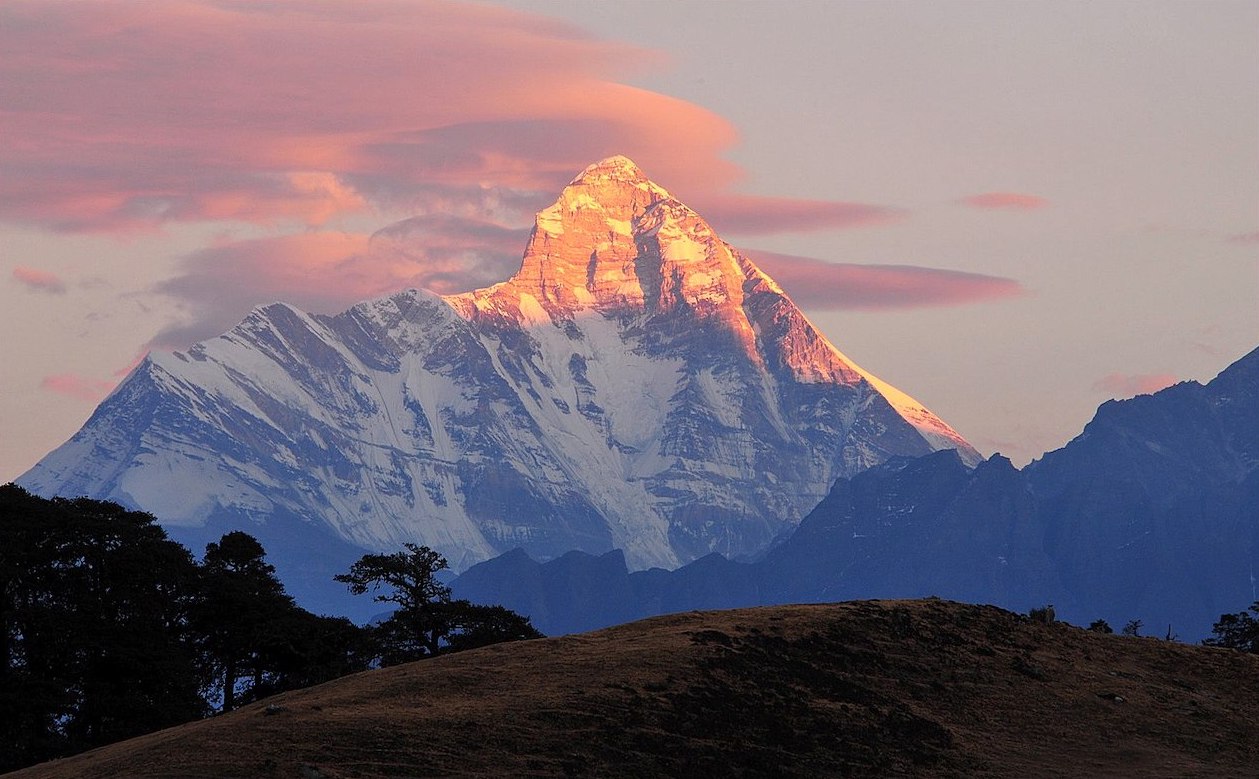
India's second-highest peak, Nanda Devi is the dream destination for most trekkers. At a staggering altitude of 25,643 feet , it is the 23 rd highest peak in the world . One of the most alluring peaks in the world, Nanda Devi's unexplored terrains add a mystic charm to its beauty.
Nanda Devi East Base Camp Trek is the trek-route that stuns you with the beauty of sister peaks of Nanda Devi and Nanda Devi East. This route became popular after the closure of Nanda Devi Inner Sanctuary.
Despite the popularity, the peak and the circle of colossal mountains surrounding it-the Nanda Devi Sanctuary-are the most difficult to scale. Nanda Devi is a two-peaked massif, with a 2 km long ridge along with the east and west directions. On the west lies the higher summit, and the lofty Nanda Devi East encloses the Sanctuary from the east. Chilling to the core, Nanda Devi East massif is one of the most challenging summits to climb, meant for hardcore climbers.
The opulent Nanda Devi Sanctuary encompasses an area of 113 km . in perimeter and stretches to an altitude of 19,685 feet. Majestic mountain peaks encompass it on all sides except west where it is surrounded by an inaccessible gorge. The region is blessed with beautiful landscape, an amazing array of mountain ranges and dense forests; it provides a perfect set up for adventure junkies seeking thrill and high mountaineering routes in their trek.
Some interesting facts about Nanda Devi
- The name Nanda Devi is derived from Goddess Nanda Devi translating to "Bliss Giving Goddess".
- Nanda Devi consists of twin peaks, connected by a 2 km long ridge.
- Nanda Devi East is also known as Sunanda Devi, the lower of the two adjacent peaks, is located at an altitude is 24,390 feet.
- The western summit of Nanda Devi, at an elevation of 25,643 feet is the highest of the two peaks. It is the main summit.
- Nanda Devi and Sunanda Devi, the twin Goddesses are worshipped throughout Uttarakhand.
- After many unsuccessful attempts, the peak was successfully conquered in 1936; it took 50 years of arduous exploration to finally scale the summit.
- Bill Tilman along with Eric Shipton and Noel Odell were the first to discover a way into the Nanda Devi Sanctuary.
- It is still considered one of the most difficult peaks to ascend. Traversing through Rishi Gorge, the very steep and narrow canyon is the most difficult part of the Nanda Devi trek.
Legend has that at Bageshwar, in the foothills of Kumaon, Lord Shiva married Goddess Parvati. Goddess Parvati is enshrined in Nanda Devi, outlined by Mount Trishuli (which is the trident of Lord Shiva).
- Region-Kumaon Himalayas, Uttarakhand
- Altitude-13,612 feet
- Trek Level-Difficult
- Trekking Distance-75 km (one way)
Duration-14 days
- Best Season-May to June and September to October
- Start Point of trek-Lilam
- End Point of trek-Milam Glacier
One of the most difficult treks to undertake, Nanda Devi Base Camp trek takes you closest to the Nanda Devi East peak. Meant for seasoned trekkers, the trail traverses through a circular and slippery route and demands swift manoeuvers throughout. It entails long walking days with a trek of almost 75 km. one way. Adequate preparation and several acclimatization bases are mandatory for this trek as it gradually transforms from an easy trek to a fairly tough one in later stages.
- Visit the villages of Burphu and Munsiyari- Munsiyari will captivate you with its untouched landscape and a scenic array of waterfalls, meet the Johari tribe famous for Ayurvedic herbs and woolen shawls, soak in the stunning view of Panchchuli peaks. Enjoy the artistic wooden carvings on houses at the desolate village of Burphu.
- Revel in their culture and get a sneak peek into the primitive lifestyles of locals.
- Witness the exotic flora, fauna and high altitude bird species. Nanda Devi National Park treats you to the most stunning wilderness in Indian Himalayas. Also known as Nanda Devi Sanctuary, it houses the most exquisite flora and some of the most endangered species of animals like The Himalayan Black Bear, snow leopard, Lingus, brown bears and many more. Fir, pines, rhododendrons, and Juniper are the main vegetation among 312 varieties of flora that enriches the park. The national park opens from 1st May till 31st October every year.
- Spectacular view of Nanda Devi East is the ultra selling point of this trek; the view is so close, you feel as if you are touching the summit.
- Milam Glacier is one of the main highlights of the trek. It is the major source of the river Gori Ganga. Get stunning views of Mount Trishuli, Hardeol and Rishi Parvat at Milam Glacier.
Short Itinerary
Kathgodam-Munsiari-Lilam-Bugdiar-Railkot-GhangharBase camp of Nanda Devi East-Milam village-Milam Glacier-Milam-Railkot-Bugdiar-Lilam-Munsiyari- Kathgodam
- Distance- 210 km by road
- Time taken-9 to 10 hours
- Altitude-7,514 feet
- Drive through the picturesque hill stations of Kumaon covering Almora, Bageshwar, Chaukori, Tejam and finally Munsiyari
- Overnight stay in a tent or a guest house
- Get the paperwork done for procuring mandatory permits from the local administration
- Revel in the beauty of Munsiyari, mingle with the local Johari tribe, enjoy the view of Panchchuli peaks
- Distance-10 km drive from Munsiyari to Selapani and 7 km trek from Selapani to Lilam
- Time taken-2 hours drive and 2½ hours easy walk
- Altitude-6,562 feet
- Overnight stay at a guesthouse
- Distance-12 km trek
- Time taken-7 to 8 hours
- Altitude-8,860 feet
- The trail along a 25 km long gorge lined by thick bamboo trees and mixed rain forest, ascend to Radgiri at the junction of Ralam and Gori Ganga rivers leading to Bugdiar
- Overnight stay in tents or a guest house
- Distance-16 km trek
- Time taken-6 to 7 hours
- Altitude-10,499 feet
- A steep climb to a massive cliff which shelters a local deity leads to an open valley, enjoy the beauty of 2 waterfalls, rest for a while before taking an uphill trek leading you to Railkot
- Overnight stay in tents
- Distance-13 km trek
- Altitude-10,827 feet
- Trek through an arid land, the villages are soaked in solitude till you reach Burphu village, enjoy the view of Burphu peak (20,670 feet) and the eastern side of Nanda Devi East, marvel at the artistically carved wooden doors and windows of the quaint and solitary village of Burphu
- Distance-7 km trek
- Time taken-3 to 4 hours
- Altitude-12,800 feet (base camp) and 24,380 feet (Nanda Devi East)
- Undertake a steep trek to reach Pachhu Valley, get a scenic view of the north face of Nanda Devi East, enjoy the dwarf rhododendron blossoms and the beauty of birch with anemones on the way leading to alpine meadows, trek 3 km from the base of Nanda Devi to reach the campsite, explore the ridges of Nanda Devi, capture some picture-perfect shots of Nanda Devi East massif in changing hues all through the day
- Distance-17 km
- Altitude-10,835 feet
- Cross Gori Ganga and climb further to reach Milam Village, learn about the culture of the villagers who believe that they are the descendants of Rajputs from Rajasthan, this village is the last major settlement before Tibet
- Distance-3 km trek
- Time taken-1 hour
- Altitude-13,456 feet
- Swift maneuvers are required as the path can be slippery due to ice, enjoy the scenic glacier which is the largest in the Kumaon region, enjoy magnificent views of Mount Trishuli, Hardeol, and Rishi Parvat, return to Milam Village
- Distance-14 km trek
- Reminisce the uphill trek as you carefully travel downhill to reach Railkot
- Time taken-5 to 6 hours
- Enjoy the downhill vista as you repeat your day 5, reach Bugdiar while passing through the deserted village of Burphu which is home to only 3-4 farmer families
- Distance-12 km
- Relive the memories of Day 4, click downhill shots of bamboo thickets and dense rain forests
- Distance-7 km trek and 10 km drive
- Time taken-Total 4-5 hours
- Overnight stay in a guest house
- Distance-210 km
- Time taken-9 to 10 hours by road
- Rejoice in the scenic landscape of Kumaon hill stations and make some beautiful memories as you head back home from this enchanting trip
How to reach
- By road-Reach Kathgodam by road from Delhi (310 km, 7-hour drive) and drive 210 km to Munsiyari from Kathgodam
- By rail-Reach Kathgodam by an overnight train from Delhi and drive 210 km to Munsiyari from Kathgodam, or drive to Munsiyari from Delhi (575 km, 16½ hour drive)
Deals And Offer
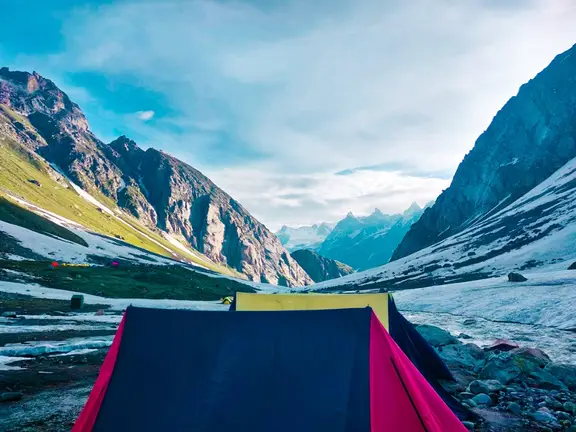
Hampta Pass Trek
4.87 ( 438 ), hampta pass trek 2024 - chandratal lake trek | moxtain, free cancellation till 30 days prior trek, rental & gear available on rent, book with 20% initial amount.
See Dates / Book Now
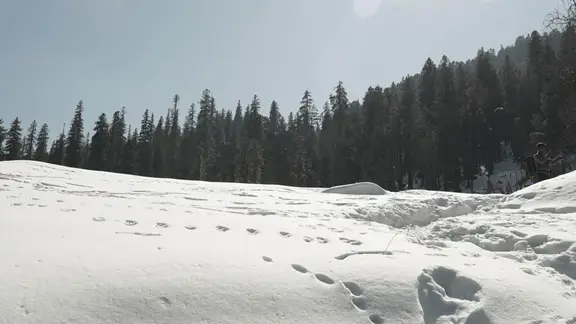
Dayara Bugyal Trek
4.85 ( 398 ), dayara bugyal trek 2024 - 6 days trek | moxtain.
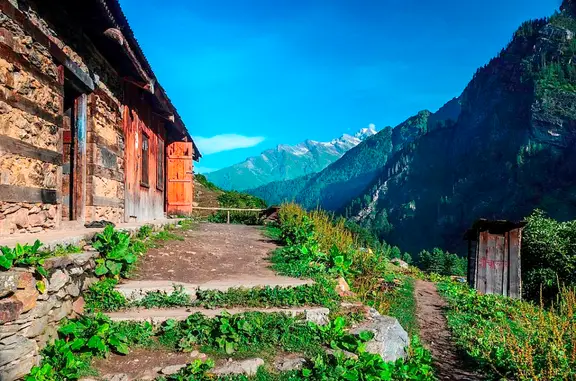
Kasol-Kheerganga-Tosh-Malana-Trek
4.56 ( 24 ), similar blogs.
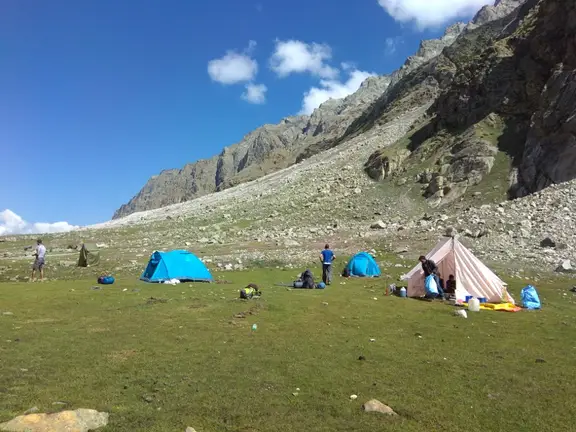
Deo Tibba Basecamp Trek
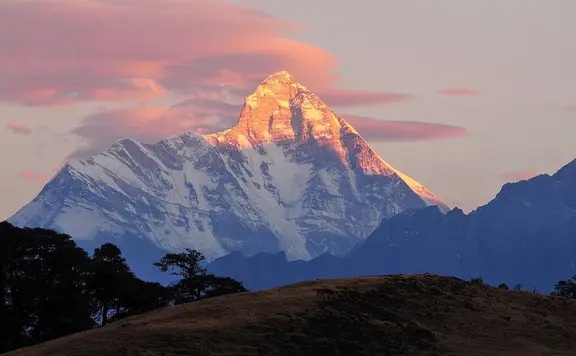
Khalia Top-Experience the unexplored Himalayan fantasy land

Altitude Mountain Sickness
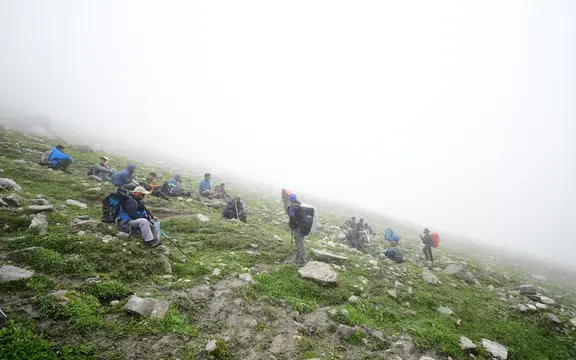
How To Be A Responsible Trekker
Similar trips, everest base camp trek, stok kangri, annapurna base camp trek, goechala trek, nag tibba trek, deoriatal chandrashila, sandakphu phalut trek, bara bhangal, mayali pass.
Mera Peak Climbing: Best Offerings 2024/25. Learn More
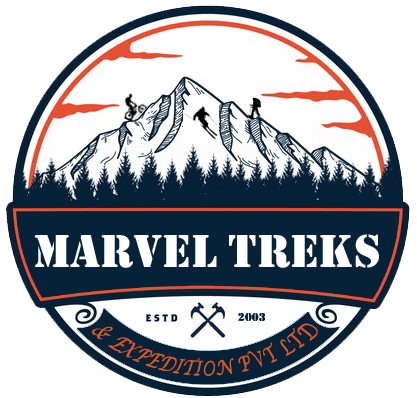
Nanda Devi Trek
Home » Trip » Nanda Devi Trek
Trip Downloads
Challenging
Teahouse/Lodge
Autumn, Spring
Nanda Devi Trek Overview
Nanda Devi, standing tall at 8,7861m (8.761km), is the second tallest mountain in India. It falls within the boundaries of Nepal and India and falls in the Uttarakhand state of India. It is part of the Garhwal Himalayas . The name ‘Nanda Devi’ refers to the guardian goddess of the Himalayas of this region. There is a belief that Nanda Devi is the goddess of bliss. So, if you’re looking for a one-of-a-kind experience in the Indian Himalayas, look no further! Nanda Devi Trek is your answer. In addition, this trek features exquisite nature wonders that are worth trekking.
The Nanda Devi Peak lies within the beautiful Nanda Devi National Park . The park is home to many exotic flora and fauna and is one of the world’s heritage sites. Moreover, many rivers and glaciers within this area add more beauty to this area. Nanda Devi Peak stands proudly surrounded by these beauties. One is not allowed to climb Nanda Devi’s peak despite being utterly beautiful and mesmerizing. The trek to Nanda Devi provides a heartwarming experience for its travelers. It is the perfect escape from the day-to-day hustle. The trekking route has a wide diversity of vegetation to see. The beautiful forest of rhododendron, birch, and other trees welcomes travelers. It makes the expedition exciting.
Trekkers travel through lush forests, cold glaciers, and distant villages, experiencing nature’s natural magnificence. The trail ends at the base of Nanda Devi, India’s second-highest peak. It’s a test of endurance and a journey of self-discovery, drawing adventurers from all over the world to view its breathtaking beauty.
Marvel Treks , your trusted guides, will lead you through the Nanda Devi trip with competence and passion. With our seasoned experience, experts navigate difficult terrain to ensure your safety and comfort. we will lead you through stunning landscapes, revealing hidden wonders and cultural treasures along the route. By our side, every step of the trek becomes an unforgettable adventure across the mountains of the Himalayas.
Highlights of Nanda Devi Trek
Nanda Devi is a mountain in the Indian Himalayas, standing at 7,816 meters (25,643 feet) above sea level. It is the second-highest peak in India, after Kanchenjunga.
There have been many expeditions to Nanda Devi over the years, with the first successful summit occurring in 1936 by a British team.
Some highlights of expeditions to Nanda Devi include:
- The first successful summit of the mountain was in 1936 by a British team.
- The first ascent of the mountain by a woman was achieved by Shanti Swarup Bhatnagar of India in 1936.
- The first ascent of the mountain by a double amputee was achieved by Mark Inglis of New Zealand in 2007.
- The oldest person to reach the summit of the mountain was achieved by Kurt Diemberger of Austria at the age of 80 in 2007.
- The first winter ascent of the mountain was achieved by a Polish team in 1991.
These are just a few examples of the many highlights and achievements of expeditions to Nanda Devi. The mountain continues to attract climbers from around the world, and new records and achievements are constantly being set
Outline Itinerary
- Day 1: Arriving at Delhi and travelling to Haridwar through AC train then transferring to a hotel in Rishikesh
- Day 2: Driving to Joshimath and exploring Joshimath in evening
- Day 3: Driving for an hour to reach Lata village where our trekking team will be waiting for us ; Visiting Nanda Devi temple
- Day 4: Trekking to Lata Kharak
- Day 5: Trekking to Semi Kharak and returning back to Lata Kharak
- Day 6: Trekking to Dharansi passing through Jhandi Dhar and Bagfyana pass, camp Will be set
- Day 7: Trekking to Tolma village
- Day 8: Trekking to Surai Thotta and driving to Karanprayag
- Day 9: Driving back to Haridwar and flying to Delhi
- Day 10: Returning home
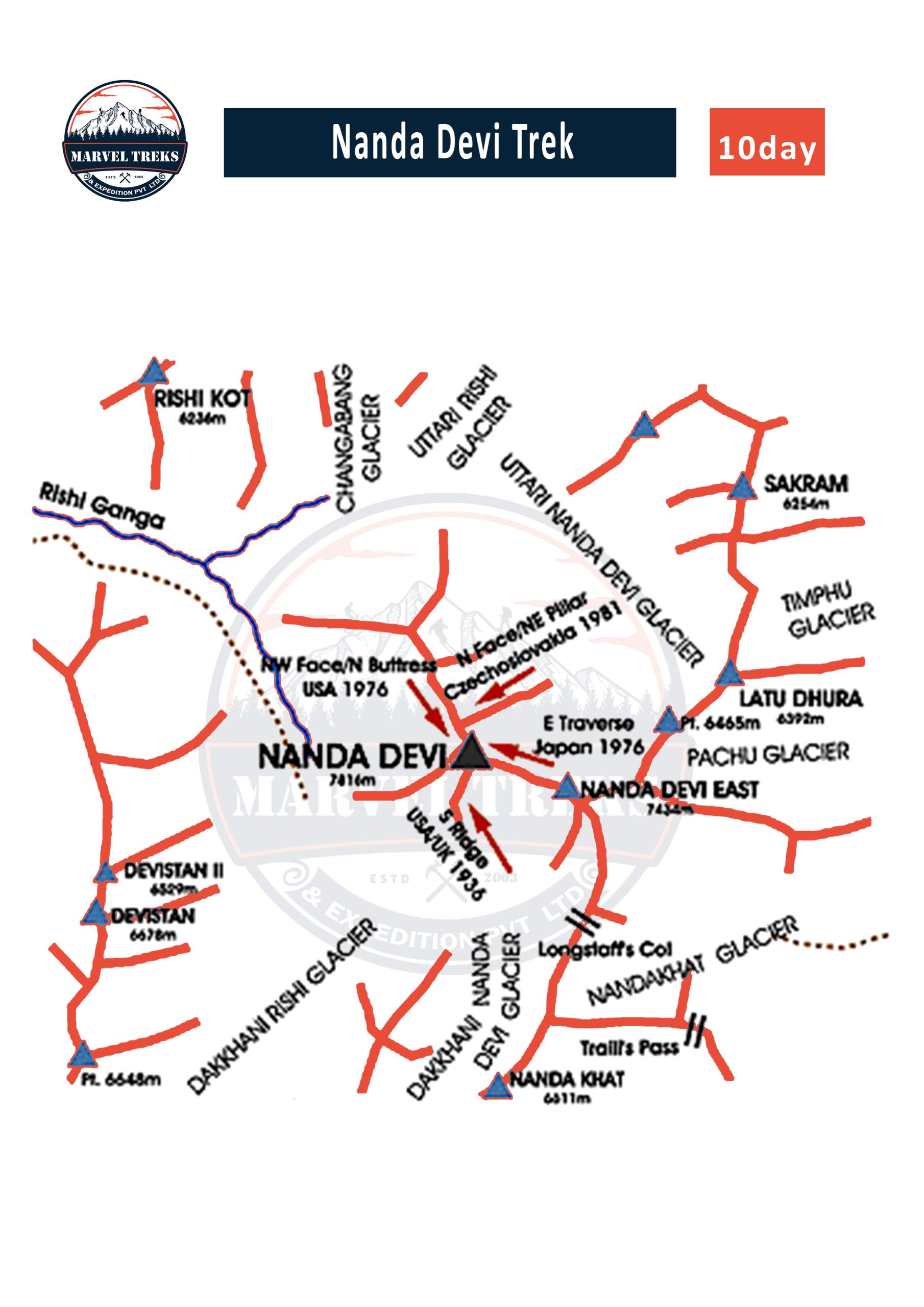
Difficulty to Climb
The trek is not that difficult for travellers who have been trekking before. But for those who are not used to and find trekking for several hours a day difficult, this trek could be a bit difficult. Also, the trekking route passes through remote, abandoned, and less used passages, so it might be a bit dangerous to travel. However, with proper preparations and guidance from experienced guides, it won’t be a big problem.
Nanda Devi with the best Expedition company
The trek to Nanda Devi is exciting and adventurous, but it has its own set of challenges. Travellers have to trek several hours during the trip. Also, the route is a bit remote and less used, making it a bit dangerous. However, with proper preparation and guidance, one can easily overcome these difficulties.
It is where Marvel Treks comes into the picture. The entire team of Marvel Trek works deliberately to provide the best services and facilities to you and makes sure that you will have a once in a lifetime experience.
Taking care of the basic needs, safety measures and legal formalities to provide satisfactory and convenient services in the best interest of the clients are the main goals of Marvel Trek.
If you want to live your dream of adding adventure to your life and wish to take a break from your day-to-day hustle in the most exciting way with trustworthy help, Marvel Trek is there in your service.
We take care of all the arrangements for your trip at a reasonable cost.
Contact us and book a trip with us, and let’s get going in fulfilling your dream of adventure.
Client requirements
- The clients should be healthy enough to make the expedition.
- They should have some prior experiences in trekking.
- They should be fit and should be trained a bit before the actual departure.
Why should Marvel trek be chosen for climbing?
Marvel trek has been providing its clients with excellent and satisfactory services since 1998 at a reasonable price.
Also the team of Marvel trek has skilled professional guides who have years of experiences in trekking and are familiar with the geography and weather conditions of the mountains.
You can trust them to guide you with proper instructions and full safety without compromising your wish to enjoy the trip.
Marvel trek keeps its client’s satisfaction,safety and comfort as its priorities.
When is Nanda Devi Trekking usually done ?
The most favourable season to trek to Nanda Devi would be the spring and summer. During these seasons, the climate is pleasant. One can witness the beauties of Nanda Peak and other surrounding peaks. The greenery and the bloomed wildflowers seen during these seasons take the whole experience of trekking to another level.
How hard is Nanda Devi Trek?
Trekking to Nanda Devi is not as hard as other treks. There are several hours of trekking which might be hard for a few. But there will be leisure times to take a rest. Besides this, the routes for this expedition are less used, making it a bit dangerous. However, that won’t be much of a problem with proper guidance from the guides. So, trekking Nanda Devi is at a moderate level when it comes to difficulties.
How long will be the Nanda Devi Trek?
Trekking to Nanda Devi is a self-refreshing activity, yet it can be exhausting too, so making a rush might not be the best thing to do. The overall adventure of trekking to Nanda Devi takes around ten days.
Trekking Equipment list
Requirement.
- The climbers should get themselves tested to make sure they are healthy enough to climb the mountains.
- A visit to the dentist is also recommended as there is a chance of acute dental problems at high altitudes.
- It is also highly recommended that the climbers should have some previous experiences with high altitudes.
- It is also requested that the climbers should workout a bit months prior to ascending the mountain.
Payment and cancellation
Policy regarding Payment and Cancellation Payment:
Payment: 1) To confirm a reservation, a deposit equal to 30% of the total price is required. 2) If the payment is made online, the remaining balance is due 10 days before the Tour, Trekking, Peak Climbing, or Expedition begins. If the payment is made in cash, it can be made after arrival. 3) If the booking is made within 30 days of the expedition beginning, full payment must be made at the time of booking.
Cancellation: 1)A full refund of the deposit will be given if a Tour, Trek, Peak Climbing, or Expedition is canceled more than 60 days before the start date. 2)The deposit will not be refunded if a Tour, Trek, Peak Climbing, or Expedition is canceled within 30 days of its start date. 3)A tour, trek, peak climbing, or expedition will not be refunded if it is canceled prior to or on the start date. 4)All participants should strongly consider purchasing travel insurance to cover any unforeseen cancellations or other occurrences.
Note: We reserve the right to modify or cancel any trek in the event of a natural disaster, political unrest, or any other unforeseen circumstances beyond our control. In such cases, a full refund or an alternative option will be provided.
Dates of Trip
Group discount prices, frequently asked questions, booking details, full board service.
- Transportation:- Includes pickups and drop offs from and to the airport along with the domestic flights and jeep rides.
- Food and accommodation:- Accommodations will be provided in a 3-star hotel while staying in Rishikesh as well as during different stops in the trip. A welcome dinner will also be held to introduce our team with the clients. Later,3 meals will be served during the trip which will be cooked by talented cooks along with occasional teas and coffees.
- Permits and fees The company will pay for the air cargo charges as well as all the taxes to the Indian government on your behalf. The company will also take care of different Royalties and permits from Indian government National Park area permits will be arranged Permits for Walkie talkie as well as satellite phones will also be provided
- Insurance The company will cover for insurances of all the involved staff in case of accidents.
- Equipments All the tools and equipment that will be needed for the expedition will be transported by the company through air cargo and potters.In case of unfavourable circumstances,it may also be done through land or helicopters.
- Liaison Officer, guide and porters Every member will be facilitated with one guide and one porter. Also,a legit Indian government Liaison will be present throughout the expedition
- Camp staffs and equipments The base camp will be fully equipped with necessary items that are needed for a comfortable stay. Solar panels or generators will also be managed for electricity tents will be equipped with heaters to keep you warm. Expert cooks and porters will be there in the camp to assist you.
- Communication Walkie talkie and satellite phones will be arranged for the members to communicate. Internet access will also be granted.
Base camp service
- Transportation:- Includes pickups and drop offs from and to the airport along with the train and jeep rides.
- Food and accommodation:- Accommodations will be provided in a 3-star hotel while staying in Rishikesh as well as during different stops in the trip. A welcome dinner will also be held to introduce our team with the clients. Later,3 meals will be served during the trip which will be cooked by talented cooks along with ocasis
- Liaison Officer,sherpas and porters Every group will be facilitated with one guide and porters. Also,a legit Indian government Liaison will be present throughout the expedition
- Communication Walkie talkie and satellite phones will be arranged for the members to communicate Internet access will also be granted.
- International flights The clients have to bear their flights fees while arriving and leaving Nepal.
- Visa and insurance The clients are responsible for their VISA while arriving in India. You have to pay for your insurance in case of any accidents
- Meals in Rishikesh While staying in Rishikesh, you will be responsible to pay for your lunch and dinner.
- Personal belongings and interests The clients are requested to arrange their own clothings and required gears while joining the expedition. They also have to arrange the items required to maintain their personal hygiene. They have to bear the additional charges for services like phone calls,hot bath,laundry etc. They have to pay extra charge in case they want to shoot videos or capture pictures.
- Tips and bonuses It will be highly appreciated if the clients can make some tips and bonuses to the hardworking guide and porters.
- Extra services In case you want any other services that’s not mentioned above then you have to pay extra from your pocket.
Price: US$ per person
Your Full Name
Your Phone Number
Your Country Expected No. of Persons In Trip
Your message (If any)
Price W/O Addons: US$ per person
There are no reviews yet.
Your email address will not be published. Required fields are marked *
Your review *
Name *
Email *
Save my name, email, and website in this browser for the next time I comment.

10 Days from
- Best Price Guarantee
- Hassle-Free Booking
- No Booking or Credit Card Fees
- Team of highly experienced Experts
- Your Happiness Guaranteed
Enquire 24/7
We are featured on

POPULAR TRIPS

Bidding For - Nanda Devi Trek
Bidding Price*
Your message (optional)
Explore the Majesty of Nanda Devi: A Journey to Base Camp
Nanda Devi Base Camp Trek is a pilgrimage into the heart of the Garhwal Himalayas, where the majestic Nanda Devi, India’s second-highest peak, stands as a sentinel of awe-inspiring beauty. Nestled in the state of Uttarakhand, this trek is a harmonious blend of challenging ascents, alpine meadows, and unmatched natural splendor.
Starting from the quaint village of Lata, the trail winds through dense forests, charming hamlets, and picturesque landscapes. Trekkers are greeted by the melodious sounds of gurgling rivers and the vibrant hues of rhododendron blooms during the spring season.
The journey unfolds with panoramic views of the Nanda Devi Sanctuary, surrounded by a ring of towering peaks. As trekkers ascend, they witness the ethereal beauty of alpine meadows and glacial moraines, leading to the Dharansi Pass at an elevation of approximately 4,200 meters.
The Nanda Devi Base Camp, nestled in the heart of the sanctuary, offers an intimate encounter with the towering peak and its surrounding giants. The pristine beauty of the landscape, coupled with the tranquility of the high-altitude surroundings, makes this trek an immersive experience into the splendors of the Garhwal Himalayas.
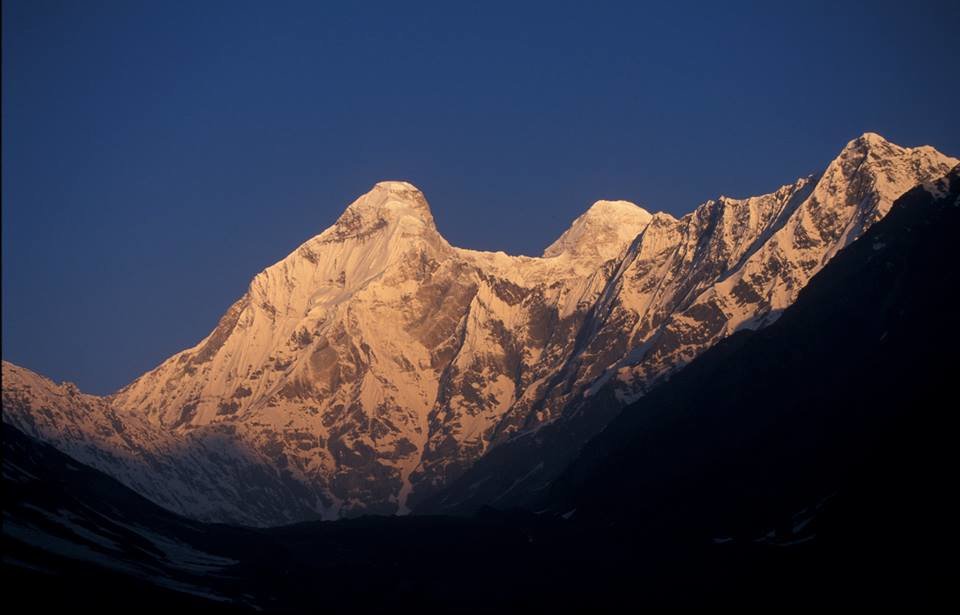
Upcoming Treks to Nanda Devi Base Camp
Nanda Devi Base Camp, the most thrilling trek of all time
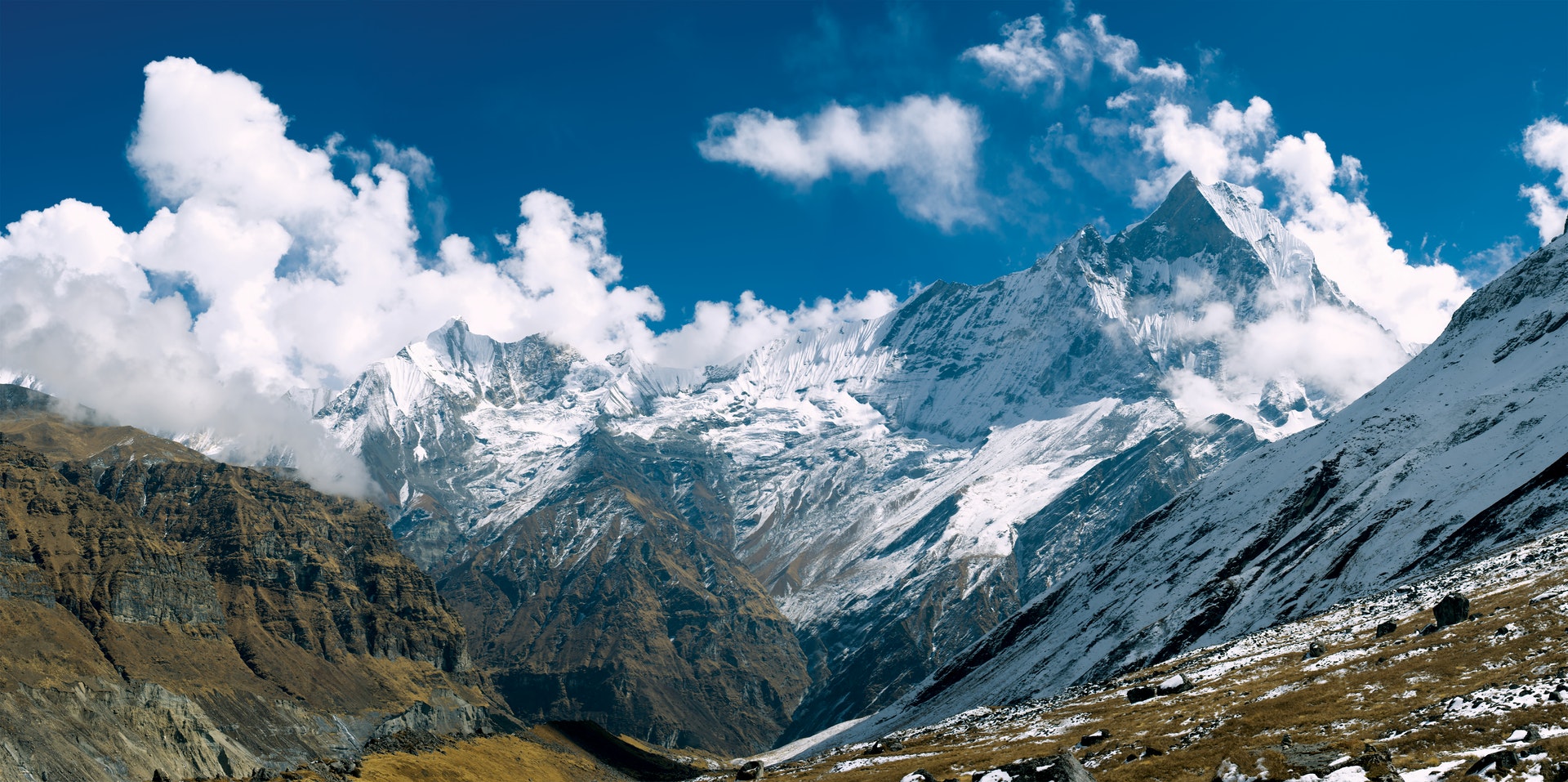
Starting from
₹ 35466 ₹ 26600 +5% gst.
- 9 Days 15,750 ft. 50 Km
- Difficult Uttarakhand
- Best season : May, Jun, Sep, Oct
Trek Highlights
- Witness the beauty of the twin peaks - Nanda Devi and Nanda Devi East.
- Though the first attempt to climb Nanda Devi was a failure, it was done in the year 1930.
- Later in 1936 a British team with three Sherpa climbed the mountain successfully.
- Nanda Devi base camp trek is one amogst them which gives you the wonderful experience.
- Second highest peak in Indian Himalaya.
- In this trek you will pass a number of lovely waterfalls.
- The valley opens up to reveal beautiful, lush ‘alpine’ meadows.
Inclusion/Exclusion
- Inclusion in cost during the trek:
- 02 Nights Accommodation in Munsayri will be provided using Guest House / Hotels on triple / quad sharing basis.
- 06 Nights Accommodation during the trek will be provided using Dome / Alpine trekking tents on triple sharing basis.
- Meals as specified in the itinerary (it will be basic Indian vegetarian Meals.)
- Experienced Trekking Guide for 08 Days i.e. Munsyari to Munsyari.
- Experience trekking Cook for the Trek.
- Trekking Crew.
- Trekking Permits and Permissions.
- Drop and pick up to / from trekking point in Munsyari by local public transportation in sharing basis.
- Sleeping Tents.
- Dining Tents.
- Kitchen Tents.
- Toilet Tents.
- Sleeping Bags (You may also carry your own sleeping bags as per your comfortability).
- Sleeping Liners (We do provide the same, however its recommend to carry your own for comfort).
- Sleeping Mattress.
- Exclusion in cost during the trek:
- Mandatory GST of 5% on Invoice Amount.
- Any kind of Travel / Health Insurance (Trekveda strictly recommend each traveller to please carry your own travel / health insurance.)
- Any Meals /Snacks / Beverages in during trip.
- Any of Cost for Airfare, Train fare
- Any of Cost for Airfare, Train fare.
- Any kind of medical expenses.
- Any tips, laundry, Phone call, liquors, mineral water, camera fee or any other personal nature expenses.
- Any other fee / charges not mentioned in the cost included section.
- Backpack offloading charges, the backpack should not weigh more than 9 kgs. Suitcases/strollers/duffel bags will not be allowed ( Subject to additional cost)
- Any Personal trekking Gears.
- Any transport facility to / from Munsyari

Have any question?
contact us @
+91 8958094170
- OVERVIEW & ITINERARY
- THINGS TO CARRY
- SAFETY & SECURITY
- FITNESS TIPS
Short Itinerary
Day 1: Arrival in Munsyari (2,290 Meters) by surface 165 Kms approx 4-5 Hrs.
Day 2: Munsyari - Lilam: (1,940 Meters) – 40 Minutes drive and approx 2 Hrs Trek –Bogdiyar (2450 Meters) by Trek 16 kms approx 7-8 Hrs.
Day 3: Bogdiyar-Rilkote (3,200 Meters) by Trek 16 Kms approx 6 Hrs.
Day 4: Rilkote- Ganghar (3,300 Meters) by trek 13 Kms approx 6-7 Hrs.
Day 5: Ghanghar- Excursion to Nanda Devi Camp (3,900 Meters) approx 3 Hrs.
Day 6: Nanda Devi Base Camp – Martoli (3,350 Meters) by trek 12 Kms approx 5 Hrs.
Day 7: Martoli – Bogdiyar (2,450 Meters) by trek 18 Kms approx 9-10 Hrs.
Day 8: Bogdiyar – Lilam (1,850 Meters) by trek 16 Kms approx 7-8 Hrs - Munsyari (2,290 Meters) by Trek 5 Kms approx 3 Hrs.
Day 9: Departure from Munsyari.
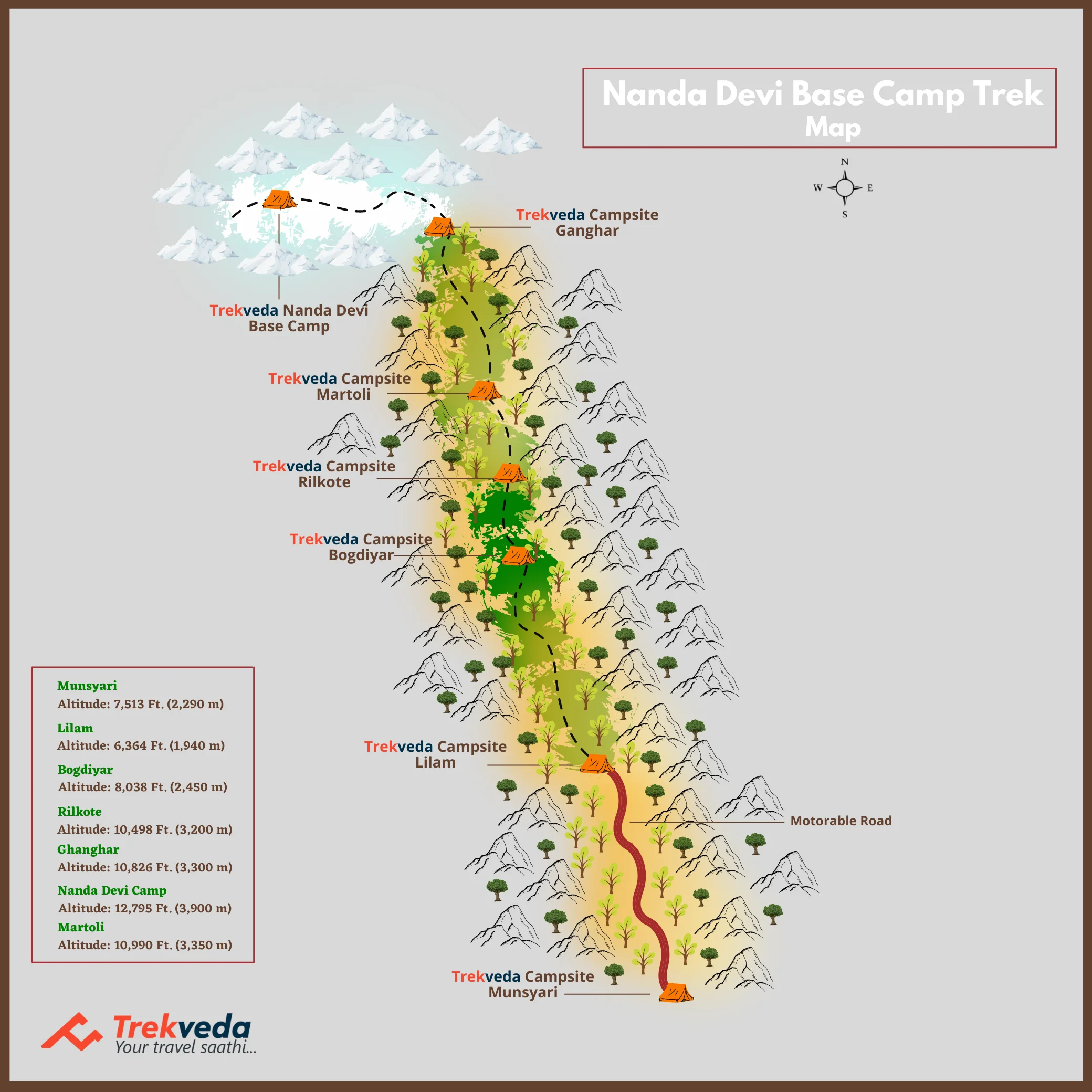
Nanda Devi with 7,816 meters of height is the wonderful trek for every trekker from different parts of the world. After the closure of the Nanda Devi Inner Sanctuary region, the Nanda Devi East Base Camp Trek became the only way through which trekkers can witness the beauty of the twin peaks - Nanda Devi and Nanda Devi East. Though the first attempt to climb Nanda Devi was a failure, it was done in the year 1930 and again in the year 1934. Later in 1936 a British team with three Sherpa climbed the mountain successfully and was followed by several other trekkers in the succeeding years. Though treks in India are well known but Uttarakhand trekking has so much to offer and this ultimate trek in Uttarakhand: Nanda Devi base camp trek is one amogst them which gives you the wonderful experience and Nanda Devi base camp trek best time in mid June to mid September. Nanda Devi base camp trek package is worth taking.
What makes this Trek different?
Trekking to East Nanda Devi Base Camp is always in the bucket list of all the adventure lovers, the second highest peak in Indian Himalaya. Nanda Devi trek is on the heights but with a moderate climbing and the passionate trekkers can never deny planning a trip to Nanda Devi East Base Camp. This alluring trek with the view of admirable Nanda Devi Peak, which happens to be one of the most stunning in the world, the trek to the east base camp is an unmatched experience. Nanda Devi base camp is spiritual as well as is an adventurous trek one can plan and add in their bucket list.
Trek Itinerary : Nanda Devi Base Camp Trek
Today on your own proceed to Munsyari It is ideally located for the experience of high altitude trekking to various glaciers and it's the base camp for Nanda Devi. On Arrival check into the hotel/ Guest House, meeting and briefing about trek with the guide, rest of the evening at leisure.
Day 2: Munsyari - Lilam: (1,940 Meters) – 40 Minutes drive and approx 2 Hrs Trek –Bogdiyar (2,450 Meters) by Trek 16 kms approx 7-8 Hrs.
Today morning we enjoy magnificent sunrise on the Panch Chuli (5 peaks), overlooking Munsyari, we drive for approx 40 minutes to Chilamdhar then 20 minutes easy walking, mostly downhill, crossing Jimigad bridge starting point of the under construction motor able road , which leads up the Gauri Ganga Valley, from here we start our approx 2 Hrs easy walk to the village of Lilam / Pumdeo village. Lilam is situated at the start of the long gorge through which we begin our trek. We continue our trek uphill through dense, semi-tropical rain forest and thick bamboo which grows on the steep slopes. After enjoying our packed lunch we continue descending till Rargari Bridge and continue ascending along the gorge for another couple of hours to the camp site at Bogdiyar.
Today we have a good steady climb for most of the morning. After the first hour of our trek we will reach the beautiful opening of the gorge and a small trail-side shrine to a local deity, which stands under an enormous cliff wall. Leaving the jungle below us, we climb out of the narrow gorge and pass a number of lovely waterfalls to reach our campsite just beyond the check-post at Rilkote. Camp is up against the cliff walls with a small spring nearby.
Today we follow a trail that leads to Burfu and Ganagha then on to the sparsely inhabited village of Martoli, continuing up to the wide, more barren and rainless zone of the Gauri Ganga Valley. Gauri Ganga River to our camp at Ghanghar sits at the head of the Pachhu Valley. This semi-deserted settlement, with only a few families left, is evidence of the general de-population of the area. From Ghanghar, we catch our first glimpse of Nanda Devi and to the north, Milam Village.
The narrow trail climbs steadily through small stretches of rhododendron, juniper and birch forest. As we pass by the peak of Nanda Bhanar (5900 m), the valley opens up to reveal beautiful, lush ‘alpine’ meadows. These meadows are at the terminal moraine of the glacier leading from Nanda Devi East. A beautiful campsite lies within a few kilometers of the foot of the Nanda Devi.
Martoli village is one of the beautiful village in Johar Valley from where one can enjoy the scenic beauty of Mt. Nanda Devi East / Nanda Devi /Nanda Kot/ Trishuli etc. today we will camp at Martoli village which is situated on hill platform also there is a nice meadow and a famous Goddess Nanda Devi temple.
Today morning we have an opportunity to do prayer at Nanda Devi Temple in the village of Martoli and thank Goddess Nanda Devi for our success trip. Thereafter we enjoy nice downhill walk following the Gauri Ganga River. Crossing Rilkote and proceeding to Bogdiyar.
Today is longest and hard day of the trekking today after early breakfast two hours easy walk after that 3 hrs ascending through tropical forest and dense bamboo bushes. We take a break for lunch and continue next 2-3 hrs downhill to Lilam but last hours walk will be steep uphill walk. On reaching road head we board our vehicles and straight drive to Munsyari. Rest of the day at leisure.
Today morning in time we departure from Munsyari on our own.
Nanda Devi Base Camp Trek: Essentials
Trekking, no doubt, is one of the most thrilling adventure one could ever have in his/her life. With an elegance of nature and unmatchable experience of the pristine mountain ranges, trekking stands out among all the adventures across the world, but nothing comes free, there are certain aspects of the trekking which one needs to consider while he/she is making up his/her mind for trekking. Here’s a list of some basic requirements which one would need during his/her camp trekking. Let’s pay some heed to these prerequisites for trekking.
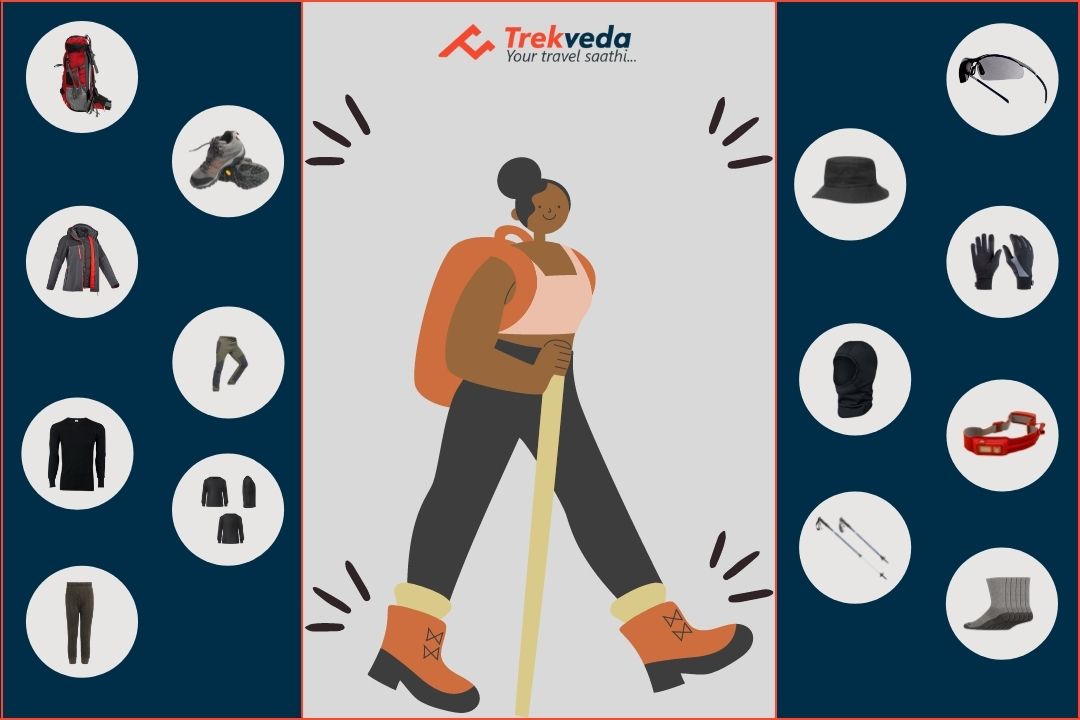
Things You Can’t Afford Missing On Trek
1. A Sturdy Backpack/RukSack
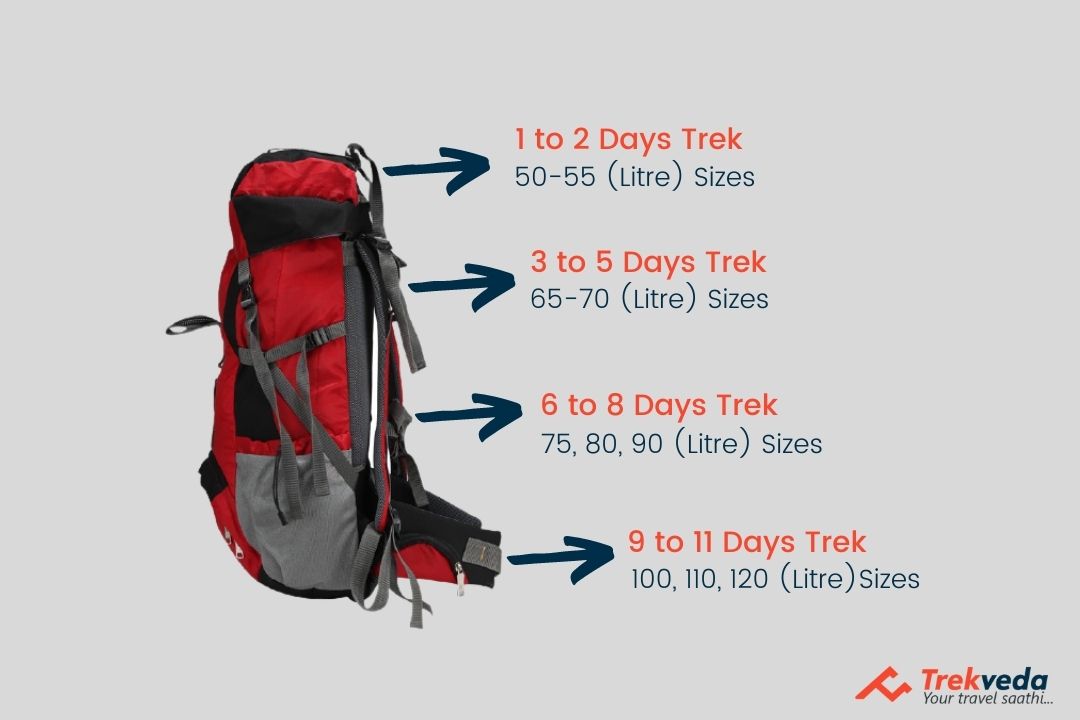
A high-quality backpack with an ease of carrying facility with durable and stern straps is one of the pivotal thing that you’d need during the entire trekking. The easier it’s to carry, the more fun you can have during your trek.
2. A Pair of Trekking Shoes
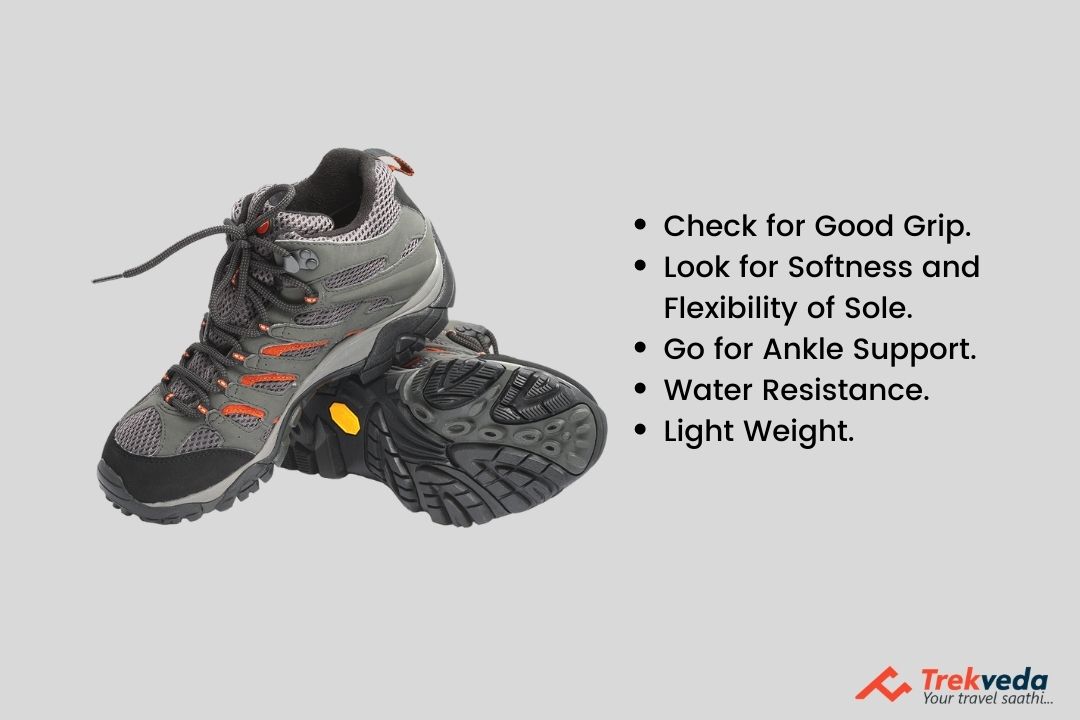
Your regular sports shoes can be a mess during the trek and one of the most regretting thing that might take away the joy of trekking. To prevent yourself from slippery patches through the streams, a pair of trekking shoes with good grip would do a great work for you and reciprocate your experience of trekking to the manifolds.
Clothing is one of the most important aspect of trekking but that doesn’t imply the “what if situation”, hence carry the clothes that you’d need normally. Carrying more and more clothes will only add the weight, thus problem. Once on the trek, you’d not generally need to change the clothes every now and then, provided if you maintain your hygiene properly.
Three Warm Layers Jacket

On high altitude treks, temperature after the sunset drops to the considerable degrees. So during these campsites, you might need an additional layer along with the padded jacket coupled up with a fleece and a warmer.
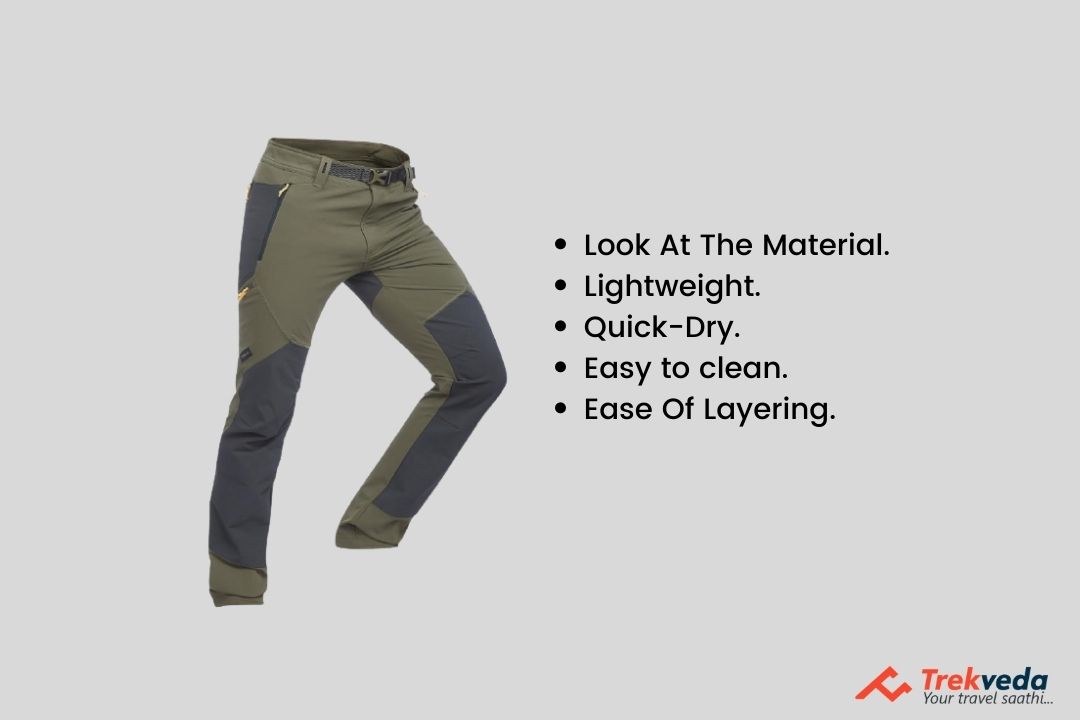
Please don’t go for jeans/ denims for the substitute for the trek pants since they’d not add comfort to your stay at the campsites. Wear one pair and carry the remaining two.
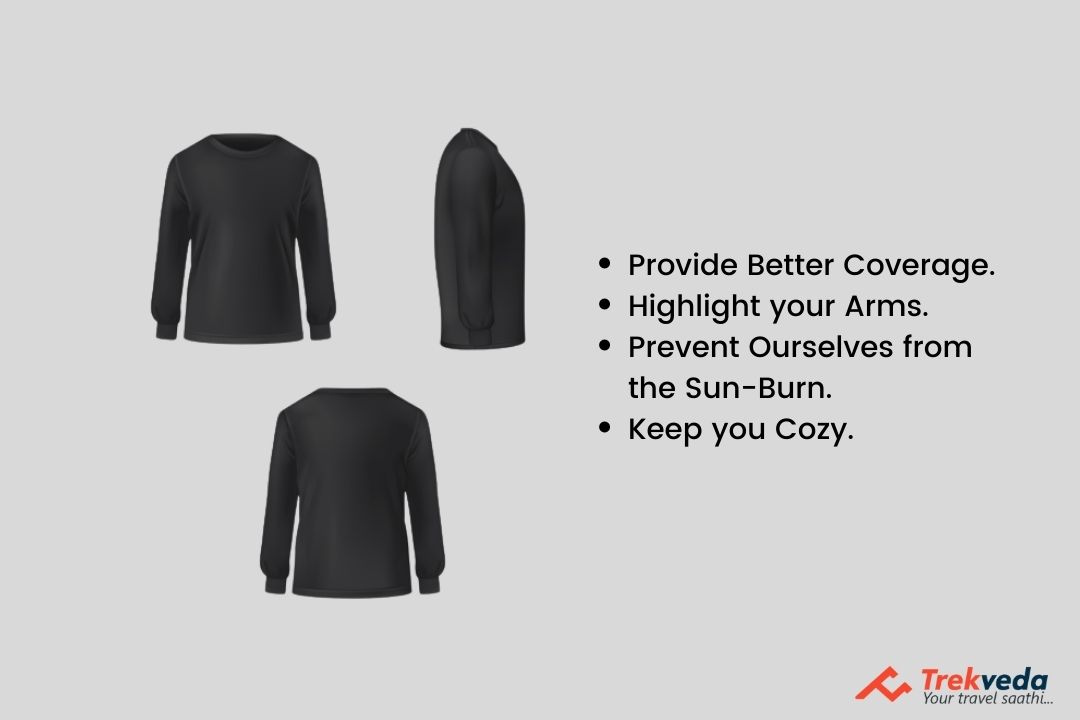
It’s advised to wear full sleeved t-shirts in order to prevent ourselves from the sun-burn. Carrying a dry-fit t-shirt or two can be a wise idea if you’re trekking during the rainy season. Regardless of the cold weather, trekkers’ bodies tend to sweat and to prevent yourself from falling ill, you’re advised to change your clothes at campsites.
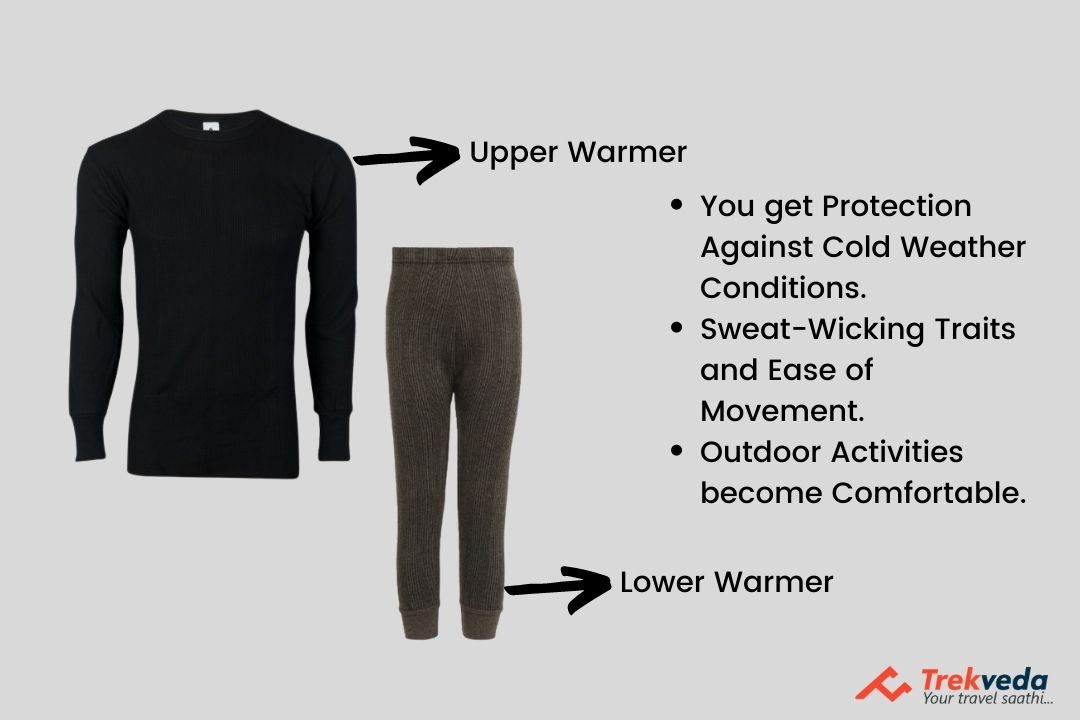
Warmers or thermals can be added on one’s own concern related to their health and their exposure to the cold climate.
Accessories

Sunglasses are to counteract snow visual deficiency. While at the same time you're probably not going to discover snow in October, convey a couple in any case.

The sun feels more grounded while at the same time strolling on the mountain slants. Convey a sun cap to shield your head and neck from the warmth, particularly in case you're trekking later in the day.
Engineered Hand Gloves

One sets of downy or woolen hand gloves. One sets of water evidence/safe, wind verification gloves.
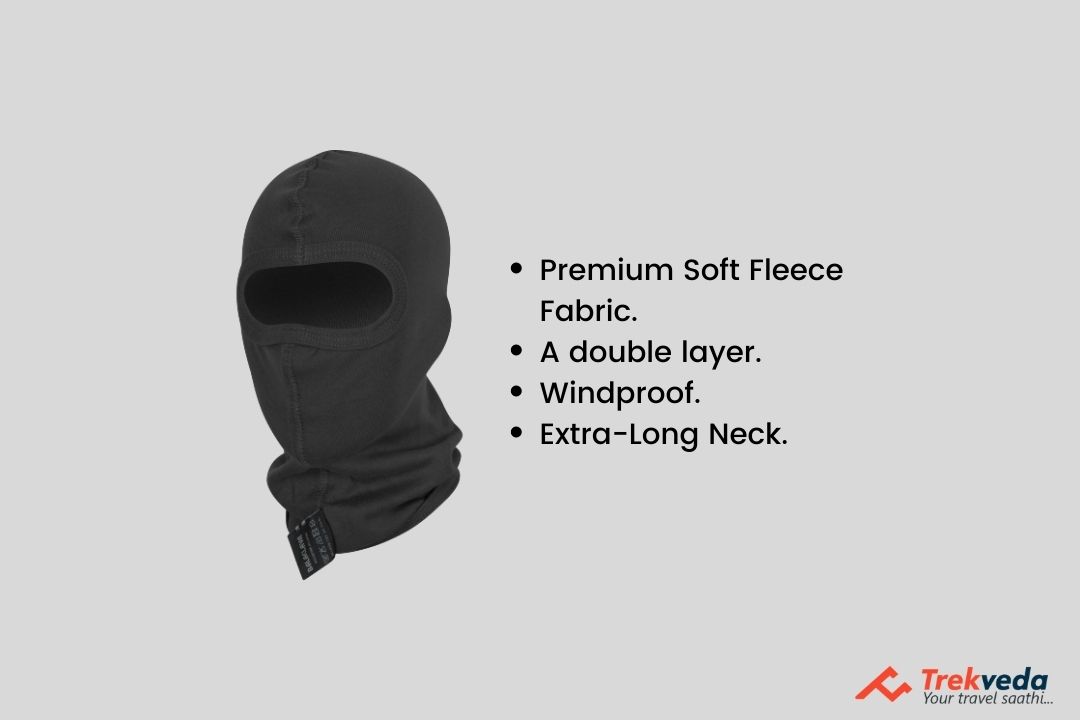
You may utilize woolen scarves rather too.

A part from two sports socks, you can take a couple of woolen socks for the night as they’d spare you from the dripping temperature.
Headlamp/LED Burn
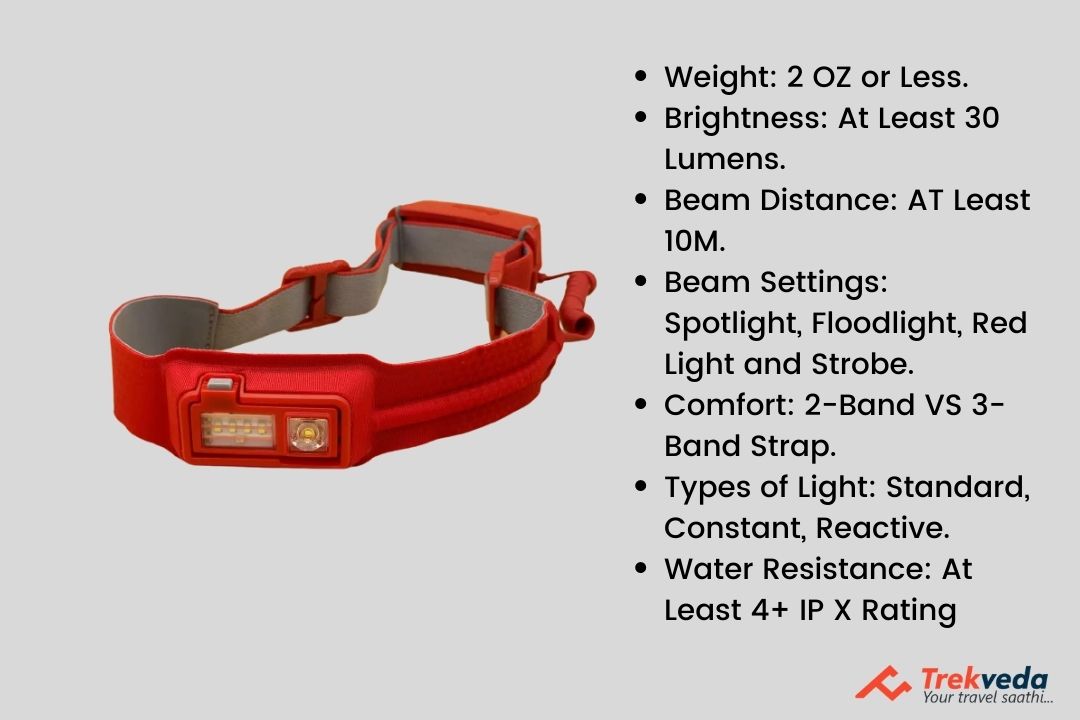
Trekking Pole
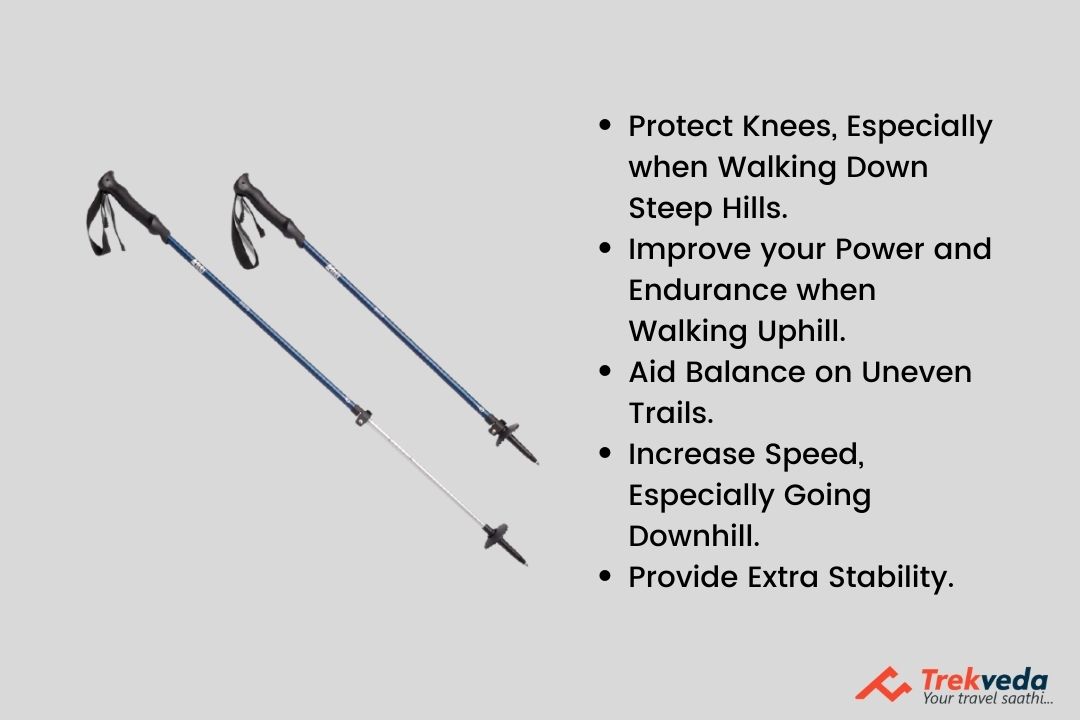
Having a trekking pole in your hand during the trek is boon, although at times it may bother you as an unnecessary article but it proves out most handy during the submit as it curbs your effort of straight inclinations of the high altitudes which often turns out tiring.
Other Essentials to Carry
An Additional Pack: This is one of the best practice you can do on one-day submits or treks where you need to get back to your campsite by the end of the day. Here you can pack your essentials like, water bottle, medical aids and snacks. This keeps you away from carrying the unnecessary weight.

Be wise while choosing your cosmetic needs and daily use products. Refrain from using the non-biodegradable products, if you do so then make sure that you leave residue on the mountains. Always carry a zip bag to put such piece of stuff after use. Sanitary napkins also needs to be treated in the same manner.
Indispensable Water Bottles
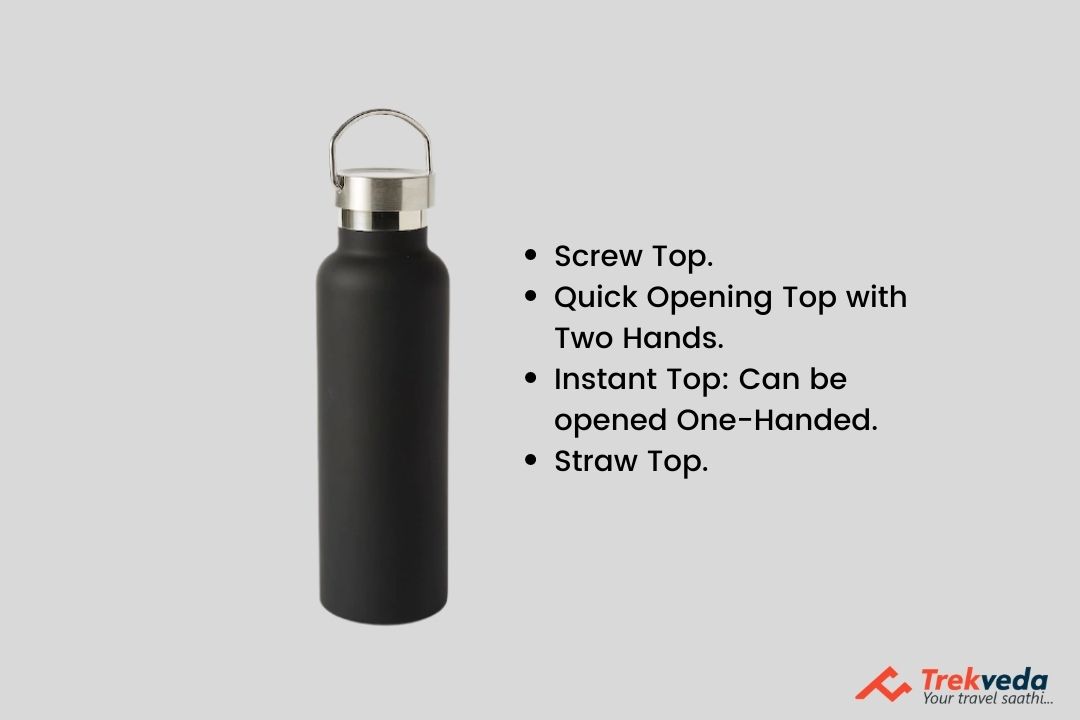
To keep your body hydrated during the trek, you are advised to carry your own water bottles during the treks since leaving plastic and its product is not advised on the mountains since they are not suitable for the environment of the altitudes.
Plastic Bags
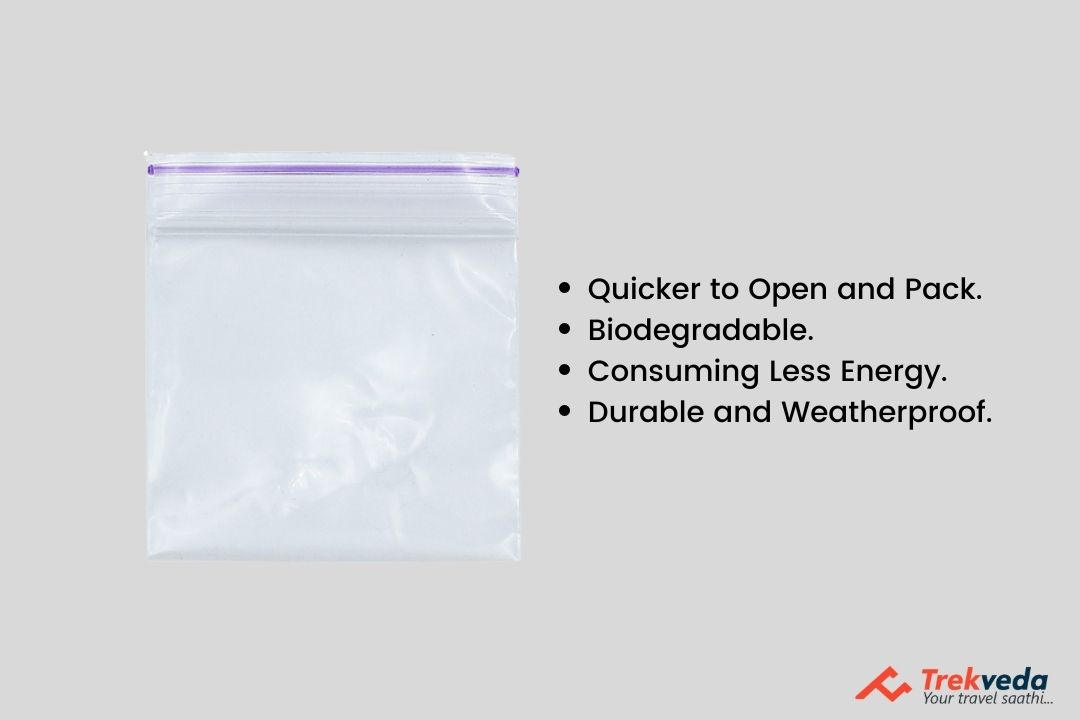
To keep everything organized, you should compartmentalize the stuffs into plastic zip bags and also carry a few in spare for wet clothes and other by-products.
Mandatory Documentation
There are certain rules and laws that you need to abide by, while going for the treks, however Trekveda takes care of all such kind paper works which is inclusive in the package. Certain registration fees and document verification along with some permissions are required in order to protect the nature and its evergreen heritage for future. In addition to this, if you need to avail a guide, you can also hire a guide with some bucks and a nominal paper work.
Please carry the documents mentioned below. Documents two and three need to be downloaded (PDF), filled in, signed and handed over to the trek leader at the base camp.
- 1 passport size photos and an original + copy of government photo ID document – required for Sanctuary registration and TIMS (Trekker’s Information Management System)
- Medical Certificate (first part to be filled by a doctor and second part by the trekker)
- Disclaimer form (to be filled by the trekker)
Measures Taken by Trekveda to Ensure the Security of Trekkers
Trekking is altogether a different kind of adventure where you required to be physically and mentally prepared for the best and adverse, all at once. With high altitudes making it tough to breath, the scenic beauty of those pristine mountains leave you spell-bounded so that you forget to breath for a moment or two. In addition to the physical and mental preparation, there are certain aspect of the health that are needed to be considered at the first hand when you make up your mind for the trekking,
Trekveda, by dint of its team of trained professionals, leave no stone unturned to provide you with the best trekking experience while ensuring your safety as its priority. Here are some vital aspects that Trekveda includes in its checklist to ensure the safety of its trekkers.
Criteria for Fitness Analysis
Trekking at high altitudes demands endurance and fitness and those who are prone to any kind of physical or physiological ailments are advised to not to go for high altitude treks in the beginning. To get assurance about the trekker’s fitness, we comply with certain aspects of the being fit such as BMI (Body Mass Index) along with the fitness proof since we can’t put the trekkers into the risk.
Acclimatization is another important aspect when it comes to getting an adaptation to the climate at the high range treks. A day at rest is not just the rest but a chance to get used to of the place and its habitat.
Monitoring the health is one thing that is conducted regularly during the trek by the trek leaders which includes the monitoring of your blood pressure, oxygen level and pulse rate. Details of your health during the trek is maintained in the health card on the regular basis. Health card can be collected from the trek leader at the end of the trek.
Medical Kit for High Range Trekking
An ideal medical kit that’s developed for the trekking has Blood Pressure Monitor/checker, Stature, Oxygen checker and Oxygen Cylinder coupled up with certain must have medicines, in case of medical emergency:
- Dexamethasone
- Asthalin Inhaler
Trekking Equipment for High Altitudes
Trekveda provide you all the necessary equipment for trekking from tents to ropes. In addition to that, our trek leaders also ensure the safety by various safeguards they take time to time for your safety. Micro spikes are provided to attach to your shoes which help you to keep the traction on the snow and make it easier to climb. An additional gaiters are provided to cover the shows which prevent the entering of snow into the shoes. Customized tents are provided to the trekkers which ensure the warmth and temperature 10 degrees higher than the outside coupled up with high quality sleeping bags which can endure the temperature up to 15 degree Celsius below the freezing point.
Nutrition and Hydration
Trekveda, keep all your nutritional and hydration requirements on its checklist, our trek leaders will guide you to keep your body hydrated on the high altitudes as de-hydration can attract to the severe medical emergencies on high altitude treks.
We provide the highly nutritious meal to energize your body for the trek, however before certain long trails we ensure your nutritional requirements to be fulfilled with some high energy snacks or packaged lunch.
Make sure you keep up with your hydration and nutritional part as this can lead to some fatal consequences for your health.
In case of any symptoms you feel during the trek, don’t ignore or avoid them, immediately tell the trek leader.
Keeping up with the pre-defined processes and the guidelines will help you to have a memorable trekking experience.
What Trekveda has to offer in case of medical emergency like AMS, HAPE or HACE?
In case of medical emergencies, Trekveda and its trek leaders bear the sole responsibility to get you back to your wellbeing with their training and techniques. Suspecting any physiological disturbance in your body, immediately report to your trek leader as they are trained to counter such problems.
Problems like Acute Mountain Sickness can be prove fatal if not taken into consideration seriously on time. If you encounter/experience any of the symptoms such as persistent headache, fatigue or weakness, nausea, dizziness, loss of appetite, difficulty in sleeping, you shouldn’t let it go or treat it by your own either.
Acute mountain sickness is one of the most common yet the fatal problem trekkers face due to number of reasons, if the problem continues to persist, then you’re advised to descend down to the basecamp and then to visit the doctor immediately.
People with AMS are treated with number of medicines such Diamox, Nifidipine etc. coupled up with methods like Triple One Test- where one disprin is given with a liter of water along with the rest for an hour.
While AMS is most common at the high altitudes yet it can’t be risked taken casually as it leads to severe fatal conditions like HAPE (High Altitude Pulmonary Edema) or HACE (High Altitude Cerebral Edema) which, if not treated on time can lead to number of serious chronic disorders. These conditions need to not to comply with AMS, they can occur without AMS preceding.
It’s suggested to take every single disturbance into the consideration while you’re on the trek.
However, Trekveda is capable of tackling all the medical emergencies with its trained professionals yet there are several things that you need to consider, specially the intake of medicines and the knowledge about their advantages and side-effects. Don’t administer the medicine if you’re trekking through an organization, always seek help from the trek leaders, they are trained for such purposes, while in case of being a solo trekker, you should know about the medicines.
Keeping yourself hydrated and nutritionally fulfilled curbs the chances of AMS.
Risk and Response
A high altitude trek requires an audacious state of mind, however leaving on a bold excursion without computing the dangers is absolute idiocy. That is the reason we have recorded a couple of Risk and the Response arranged by Trekveda to limit or address the dangers in the most ideal way.
Risk: Altitude
Before you begin the trek, it is critical to comprehend the ramifications of high altitude on your body. Know about side effects of AMS (Acute Mountain Sickness) like mellow cerebral pain, queasiness and general distress.
Response: If you feel any of these indications, illuminate the trek pioneer on need and take after his directions. Each campground has as stretcher, completely prepared medical aid pack, oxygen chambers to address the circumstance.
Risk: Weather
Weather is unusual in the Himalayas. Despite the fact that we are constantly attentive about the evolving climate, nobody can ensure a snowfall, rain or Sun. Do comprehend that your security is of most extreme significance to us and we won't continue any further from the campground if the climate isn't ideal.
Response: The choice of the Trek Leaders and Guides to continue or sit tight for the climate to show signs of improvement will be last.
Risk: Injuries
Often, while trekking over troublesome territories, you may have minor wounds like leg sprain, wounds and so forth. Genuine wounds like breaks or real cuts are exceptionally uncommon.
Response: All our Trek Leaders are Certified Wilderness First Aid responders. They are prepared to deal with crises and can handle minor wounds with an all-around prepared medical aid unit. If there should arise an occurrence of genuine wounds, the patient is carried on a stretcher to the closest street head and is directed to closest therapeutic focus.
Risk: Lack of Communication
In the remote zones of the Himalayas, portable systems don't reach. On a trek, one is cut off from the universe of calls, SMS or WhatsApp Messages.
Response: We’d depend on walkie-talkies and sprinters to communicate between the campgrounds and the base camps.
Pre-Trek Preparations
Trekking, for its ever-lasting memories and experience, demands just a few things which involve physical endurance with physiological wellness. Not just the one who’s physically fit would do the magic in trekking but one also needs to be mentally fit as well in order to cope up with the adversities one might have to face during the treks such natural calamities, rains or other unforeseen conditions. To keep up with such requirements of trekking here are a few things you can do to get yourself physically fit.
Prerequisites of the Trek
Cardiovascular Endurance and Stamina
Cardiovascular endurance is the primordial thing that this trek asks for along with the stamina to withstand the stringent conditions during the trek. There are number of ways you can increase your endurance level but Jogging regularly with gradual increase in the pace would do the magic in just 2 or 2 and a half months. You can also increase your endurance and stamina through swimming, cycling and much more.
Combining the speed and distance target is the most effective way to get your body and mind prepared for the Trek. If you’re planning to build your stamina in a phased manner then here you should pay heed to:
- Target completing the distance of 5 km in 35 minutes or less at the beginning
- Pace up your legs to complete the 5 km in 30 minutes or less
- Before you begin the trek, you should be able to complete 10 km in 60 minutes or less
To build the strength is another most important thing and a major requirement for this trek. The whole journey of the trek is like an eternal staircase, the more you climb the better you can have the view. It goes with a climb followed by a flat then again, a climb followed by a flat. All the scenic beauty of the trek demands no less than the power of your legs.
The strength of your legs is something you need to work upon. Here is what you can do to strengthen your leg muscles to bear the pain of the trek.
Doing the squats can help. Goal for 3 sets of 15 repetitions without fail. You can begin with 8 squats in each set at the beginning, subject to your core strength for the exercise.
Flexibility
The more flexible you are the more you have the chances to get the glimpse with lesser hustle. Stretching is another major aspect of the trekking which provides you the much-needed flexibility to climb the altitudes with ease while carrying the backpack altogether is not an easier errand.
Stretching your body at large can bring you the utmost comfort during the trek. Here are some stretching you can do to get the flexibility-Stretch your hamstring, quadriceps, hip flexors, lower back muscles and shoulders. They’ll give strength and help you arrive on the slopes with the relaxed muscles. All these exercises would help you to get through the trek with ease and comfort provided you give an ample time to these.
Cardiovascular Exercise
Cardiovascular exercise is one of the most sought-after method which provide not just the physical endurance but also the strength to withstand any unavoidable circumstances sternly. Trekking demands the high endurance which you can develop in a month or two where you need to begin with the jogging or running (only if you could do). This practice needs to be combined with the speed and distance targets. You need to keep on increasing both with the time.
Begin with the small chunks of the targets and gradually increase for the bigger one. For instance,
Begin with a target of completing a distance of 5km. in 45 minutes and then gradually increase it to 7 km. in the same time and remain stick to this practice until you are able to cover 10 km. in 80-90 minutes without fail, at a stretch.
Strength Building Exercise
Another vital area of improvement, you need to work upon. Before you head to the trek, you need to have the physical strength in order to carry backpacks on the uneven terrains. Considering everything under the sun, you ought to prepare yourself for the core strength. A strength would be make you suffer less than others who’d not pay the heed.
Flexibility in the body is what the trekking demands the most. Carrying the backpacks without flexibility in your hamstrings, quadriceps, shoulder, lateral sides etc. can prove out to be fatal. More the muscles relaxed, easier would be your trekking experience. Carrying a backpack, however light in weight, can bring you the unnecessary pain which may spoil your entire trek.
Concentration
To pacify yourself or any other companion, yoga and meditation are the key. These practices not only give you the mental peace but also provide you with a placid inner conscience which is extremely important in order to withstand the cons during the trek.
This also improves your decision-making ability in the direst stressful situations, during the trek.
Terms and Conditions
Tour Payment Terms
Initial amount of 20% of the Invoice amount, the Client must pay the balance amount 15-20 days prior to the date of departure of the Tour.
Adventure Tours (Trek & Expedition) Payment Terms:
- INR 1500/- per person as an advance booking amount to confirm your adventure tour.
- Remaining amount of your booking will have to be paid 1 days before the date of travel.
Tour Amendments / Cancellations Policy
If the Client is willing to amend or cancel his/her booking because of whatsoever reasons including death, accident, illness, or any other personal reasons including non-payment of the balance payment, the Company is liable to recover Cancellation charges from the Client, as company had already paid your amount in advance in order to Guarantee your services.
For Adventure Tours (Treks & Expedition)
For Other Tours.
- 100% Voucher will be provided if the trek/ tour is canceled due to unforeseen circumstances or any kind of Natural Calamities, Political Unrest, and Sudden Global Health Concern, Riots, Lockdown Government instructions etc. in this case Trekveda will issue you a voucher of respective amount having 1 year validity from Voucher date, which can be used in any trek of your interest operated by Trekveda.
- In case of any restriction/health issue (guest gets Covid +ve), we will be avoiding charging any cancellation basis documents been shared .The credit note for the same amount will be issued which guest can use in future.
Itinerary Policy
This itinerary is a sample itinerary based on the information available at the time of publication, all information given in this program Trekveda reserves the right to change any program information before or after your booking the tour due to any events beyond our control. In case if we are aware of any changes sufficiently in advance we will notify you at the time of booking, otherwise our Tour Manager or Local representative will inform you of the changes. Major road works or floods, landslides may necessitate route changes in the itineraries. All of these may cause us to make changes in the itineraries. The Company has mentioned the detailed itinerary, price inclusions & exclusions, special notes etc. in the pdf.
Activities Of The Itinerary
Trekveda is a travel and holiday organizers only, we do not control or operate any airline, neither do we own or control any shipping company, coach or coach company, Hotel, Transport or any other facility or service mentioned in this program. We take care in selecting all the ingredients in your holiday; but because we only select and inspect them and have no control in running of them, we cannot be responsible for mechanical fault or any injury, death, loss or damage which is caused by the act or default of the management or employees of any hoteliers, airlines, shipping company, coach owner/ Transport operator who are the company’s independent contractors arising outside our normal selection and inspection process.
Terms & Conditions:-
- There is no Contract between the company and the client until the company has received the initial deposit amount per person as specified for each tour package. The full payment must be received in accordance with procedures laid down under Payments Terms. If not paid in that time, the company reserves the right to cancel the booking with consequent loss of deposit and apply scale of cancellation charges as mentioned in the cancellation policy hereunder.
- The Company has the right at any time and for any reason:-
- To terminate the Contract after acceptance of the deposit but prior to the Commencement of Tour without assigning any reason whatsoever. In the event, the Company terminates the Contract, the company shall refund the initial deposit amount without payment of any interest.
- To amend, alter, vary or withdraw any tour, holiday, excursion or facility it has advertised or published or to substitute an Independent Contractor of similar class if it is deemed advisable or necessary. In either case, the Company shall not be liable for any damage, additional expense, or consequential loss suffered by the Clients or for any compensation claims made.
- The Company would be operating its Group Tours with minimum group strength of 6 adult passengers in each group. If the group strength falls below 6 passengers, the Company reserves the right to Pre-pone OR Postpone OR Merge or Cancel the group. If the Company cancels the Group Tour for any of the above reasons then the monies paid till then by Clients will be refunded against the receipt copies. It is clear understanding between either parties that any loss arising on account of cancellation of flight / train / bus tickets booked by the Clients; either through the Company or on his/her own or through a third party; the Company shall not be liable for such losses or additional expense, or consequential loss suffered by the Clients.
- No person other than the Company, in writing, has the authority to vary, add, amplify or waive any stipulation, representation, term or condition in this program.
- In the event of the Company exercising its rights to amend or alter any of the services as mentioned in the itinerary, after such tour or holiday has been booked, the Client shall have the right:
- To continue with the tour or holiday as amended or altered.
- To accept any alternative tour or holiday which the company may offer. In either of these above cases the Client shall not be entitled to, or the Company shall not be liable to the Client for any damage. Additional expense, consequential loss suffered by him or to pay any amount as refund.
- In case of any dispute, decision of TREKVEDA will be final and binding.
- TREKVEDA reserves the right to call you back on the contact number shared by you on the website.
Health & Safety: The Company shall in no circumstances whatsoever will be liable to the Client or any person traveling for:
- Any death personal injury, sickness, accident, loss, delay, discomfort, increased expenses, consequential loss and / or damage or any misadventure howsoever caused.
- Any act, omission, default or Independent Contractor or other person or be any servant or agent , employed by them who may be engaged or concerned in the provision of accommodation, refreshment, carriage facilities or service for the Client or for any person travelling with him howsoever caused.
- The temporary or permanent loss of or damage to baggage or personal effects howsoever caused In this condition the expression “Howsoever caused” includes negligence on the part of any person.
- No liability on the part of the Company arising in any way out of this Contract in respect of any tour, holiday, excursion facility shall exceed the total amount paid or agreed to be paid for the tour holiday, and shall in no case include any consequential loss or additional expense whatsoever.
- If the Client has any complaint in respect of the services provided by any of the Independent Contractors, the Client shall immediately notify the same in writing to the Independent Contractor and a copy thereof should be handed over to the Tour Manager of the Company in order to enable the Company to take up the matter with the Independent Contractor so that in future other Clients do not face the same difficulty.
- Any claim or complaint by the Client must be notified to the Company in writing within 07 days of the end of this holiday tour. No claim notified to this Company beyond this period will be entertained and the Company shall incur no liability whatsoever in respect thereof.
- Each of this condition shall be severable from the other end if any provision be invalid, illegal or unenforceable. The remaining provisions shall nevertheless have full force and effect.
- Insurance: The tour cost does not include any costs towards the Travel / Meclaim Insurance premium. In case if the Client needs an Insurance coverage, it is suggested to go for suitable insurance policy on your own. The Client has to deal directly with the Insurance Company in case of settlement of any claim.
- Change in Tour Price: The tour prices printed / advertised / quoted to Client are dynamic prices. The person booking tour early is likely to get the lowest price as communicated / offered by the Company, subject to availability of seats. Similarly, person booking tour at the last will be offered the highest prices. This pricing module has been adopted to get early bookings on tours. Hence it is quite obvious that persons travelling on a same group tour are likely to have paid different tour prices. The Company will not entertain any claim whatsoever on account of the same. Also it is clear agreement between either parties that the prices quoted in the proposal / brochure have been calculated based upon the prevailing hotel / transport tariffs and applicable taxes thereon at the time of printing this brochure. The Company reserves the right to amend the price published in this program in case of costs increased before the date of departure. All such increases in price must be paid for in full before departure by the Client. The company also reserves the right to charge offer time to time as per the present situation demand / circumstances.
- Force Majure:-Acts of god (including exceptional adverse weather conditions), earthquake, fire , war (declared or undeclared), invasion, rebellion, revolt, riot, civil commotion, civil war, nuclear fission, Lockdown, strike, act(s) of omission/commission by any concerned government(s), or government agencies, judicial or quasijudicial authorities, occurrence of any event can force the Company to change or extended. Hence any additional expenditure occurred due to the above reasons the same will be borne by the passengers.
- Please note trekking / driving time given in the program are approximate and it may vary due to break for refreshments, photography, bad weather and Road conditions
The menus are pre – set menus provided for breakfast/lunch/dinner on the tour as mentioned under each Tour itinerary and inclusions as printed in our brochure. The meals will be served at restaurants of hotel of stay. The enroute meals or meals during excursions could be packed meals or served by enroute/local restaurants / Dhabas. We cannot process a special meal nor do we guarantee the special diet to the customer. We however reserve the right to change the meal arrangement if circumstances make it necessary to do so. If a tour participant does not avail his/her meal in stipulated time; he/she has to avail the meal on his/her own arrangement and expenses. No claim can be made for the meal which he/she has missed and not utilized.
Itinerary Changes
For the comfort and convenience of our clients, we will sometimes reverse the direction, or slightly amend the itinerary. We will try to advise you of these amendments, prior to the start of the tour or on tour. In the event that a tour participant misses on any part of the sightseeing tour or any such tour due to delay on his part, he will not be entitled to claim refund of the same.
We have mentioned the indicative names of the Hotels for each tour. We reserve the right to change the same due to unavoidable circumstances. In that case we may provide alternative, similar accommodation for which we are not liable to pay any refund. We will not be responsible or liable in case of loss of property or life at the Hotel. Similarly any damages caused to the hotel rooms during your stay, shall be payable by the Clients and the Company will not be liable for the same.
Transport / Coach / Sitting
We use Deluxe 2 X 2 Coaches or vehicles such as Tempo Traveller, Tata Winger, Chevrolet Tavera, Mahindra Scorpio, Toyota Qualis, Tata Sumo or similar as per the availability of vehicles and actual size of the group. Our tour manager / local representative will take reasonable care of your luggage but if you are carrying any high value items on the coach, we advise you not to leave them behind when you leave the coach. We will not be responsible or liable in case of theft or robbery of the said items from the coach. All baggage and personal effects are at all times and under all circumstances your responsibility. Any damages caused to the hotel rooms / coach during your stay, shall be payable by the Clients and the Company will not be liable for the same. The drivers of the vehicles are bound by specific rules like maximum driving hours within a day/during a week, rest period per day/week etc. Clients will have to strictly adhere to the prescribed timetable for the day so that the driver can complete the travel. In case, any of the sightseeing schedules is missed due to delays caused by the client, the same will not be refunded to the client under any circumstances. Please note that AC will not work in Hills and no claims to this regard shall be entertained.
Risk and Liabilities - Clients shall agree that Trekveda shall not be held responsible for consequences of natural calamities, weather condition, failure of scheduled airline, detention and delays due to quarantine, strike, theft, force major, civil disturbance, government restriction or regulation, accident by aircraft, car, bus or any other form of transport relating to program schedule. The travelers understand that such situations may occur, and we will inform you of the situation as soon as we have knowledge of it. The right is reserved to cancel or alter any package as conditions require, all additional cost occurs in such case will fully be borne by the travelers. Also, Trekveda shall not be held responsible for any loss/damage of your personal belongings.
- Price is subject to change without any prior notice.
- Price is based on the “Base” Category of Hotel Room; this is Irrespective of the Package Category Chosen. Upgrade to Higher Category is available at an extra cost.
- All domestic Hotels/Transport rates are based on current tariff & subject to change without prior notification; the revised rates will be charged extra.
- Many regions do not have star category hotels. Generally there isn’t any star categorization in this sector, however the same is demarcated as per prices and put into slabs of 2*/ 3*/ 4*or STD/ DLX/ PRM or equivalent.
- Quote based on Non-Ac Rooms in Hills. AC Rooms on Extra Charges.
- Please be reminded that all special requests like early check-in, smoking, non-smoking, views, floors, king, twin, adjoining and/or interconnecting rooms are strictly subject to availability upon arrival and cannot be guaranteed prior. Any expenses arising out of this is to be borne by the customer.
- Only 01 extra bed/mattress is allowed per room. This extra bed means a Mattress / Roll over Extra mattress on floor provided where proper extra bed isn’t available.
- In case of guests cannot climb the higher floors, we request you to update this at the time of booking so that we may take appropriate action and try for rooms in the Ground floor. This is again subject to availability and difference if any will have to be settled directly before check out.
- There will not be any refund in cased any of the sightseeing is missed/uncovered during the trip.
- In hills, hotels may be located in a way where the view might be of a building in the front, beside or behind it.
- The Hotels may/may not have some of following amenities as per its policy. Tea/coffee maker/ mini fridge/ enhanced toiletry kit (with moisturizer, tooth paste, brush, shaving kit, lufa, bathroom sleepers, bath-robe) etc.
- For meal plans, menu will be on fixed plan/ buffet basis and not on A-la-Carte basis. MAP & AP Meal plans do not include Evening snacks & cold drinks / liquor, Soups or Deserts. For order on A-la-Carte basis, guests are requested to make direct payment for additional items.
Incidental charges due to unforeseen situations
All arrangements made by Company are in the capacity of an agent only. Company will not be liable for claims or expenses arising from circumstances beyond our control such as accidents, injuries, delayed or cancelled flights & acts of Force majeure/ traffic jams / traffic halts/ diversions/ bandh/ curfew, Union strike, VVIP movement, etc. – We will request you to bear with us the situations beyond our control. We will arrange for alternate sightseeing. In case of discontinued itinerary due to these reasons no refund on the hotel booking will be provided and alternate accommodations (as per availability) are managed in the place where you have to stay back. While it is our endeavor to manage the alternate arrangements during such scenarios, please note the difference may be charged for the same.
Will you provide us with tents and sleeping bags?
We give 4 seasons tents by Gipfel for higher altitudes which can without much of a stretch withstand substantial snowfall and tempests. They are sufficiently extensive to accommodate 3 individuals on the double with a vestibule to put the knapsacks. Our resting packs are comprised of Heat seeker Pro manufactured protection that can give you comfort in - 10 degrees Celsius. We likewise utilize extra wool liners to have warm effectiveness even in the extraordinary temperatures of - 17 degrees Celsius. In the event that you convey your own resting sack, you will get a cashback compensate gave that you educate us when you have booked your trek.
What will we do if it rains?
Bring Poncho (Rain cover) for your backpack and your own. It will protect your belongings from getting damped. In case if you get drenched due to any reason, it’s advised to put off your wet clothes as early as possible because keeping yourself wet at high altitudes can attract unwanted medical complications which may cost you fatal
Will backpacks, raincoats and other equipment be available for rent?
Who am i making this out to, can i take my child along on this trek what is the age limit.
Morbo can't understand his teleprompter because he forgot how you say that letter that's shaped like a man wearing a hat. Also Zoidberg. Can we have Bender Burgers again? Goodbye, cruel world. Goodbye, cruel lamp. Goodbye, cruel velvet drapes, lined with what would appear to be some sort of cruel muslin and the cute little pom-pom curtain pull cords.
Example: Cruel though they may be...
Who will be with us on the trek from Trekveda?
What kind of food is served on the trek should we carry any food.
Morbo can't understand his teleprompter
When it gets really cold can I consume alcohol?
How do i manage the negative temperatures on the trek do i need special jackets, is it safe to trek with trekveda, can i leave traveling clothes in basecamp behind and collect them after the trek, how many people are there in one group, is there an option to offload my backpack, meals in a day, what is the starting and ending point of trek, do i have to bring any trekking gear, what is the wellspring of drinking water is it safe to drink, do we require a trekking pole, are trekking shoes necessary would i be able to utilize floaters to trek, what number of individuals will share a tent, is accommodation for men and women different, what sort of nourishment do you give, do i have to convey any documents with me, is there a doctor going with us on the trek, is there any arrangements for bathing, do we get mobile network on the trek, are smoking and drinking allowed on the trek, recommended treks.
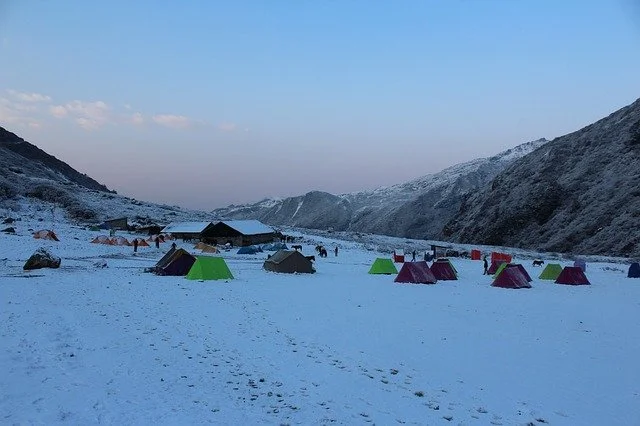
Goechala Trek
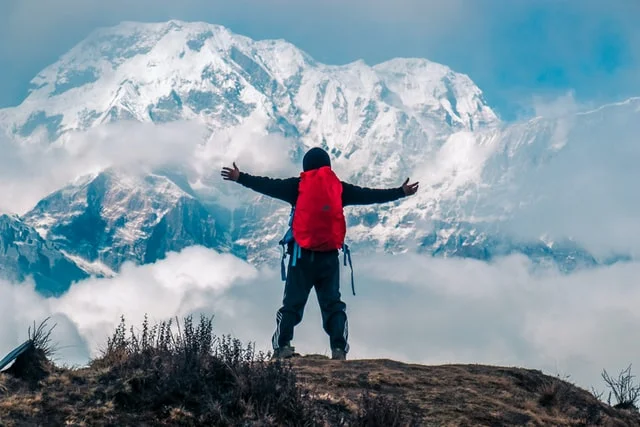
Annapurna Base Camp Trek
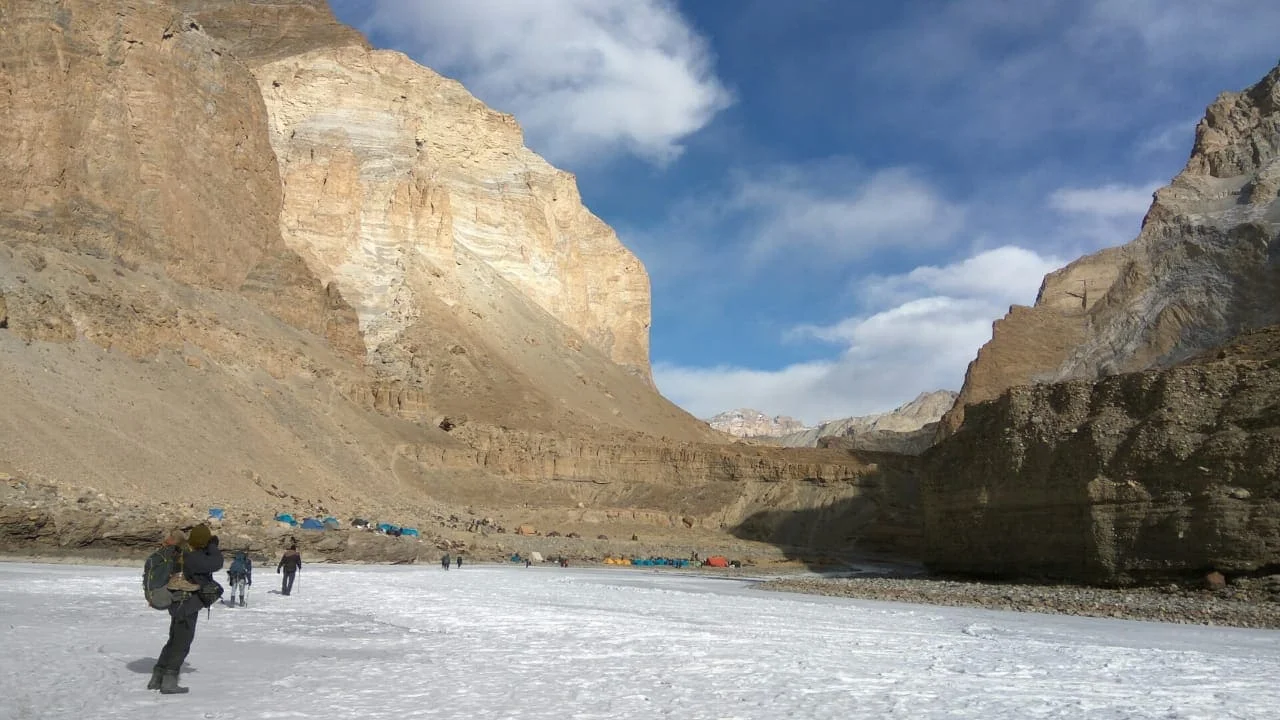
Chadar Trek
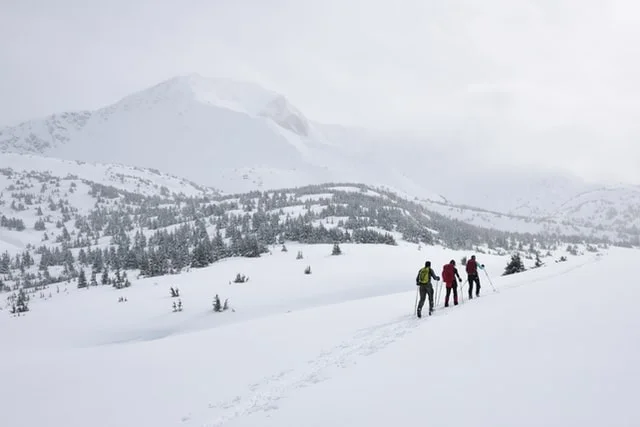
Pin Parvati Pass Trek
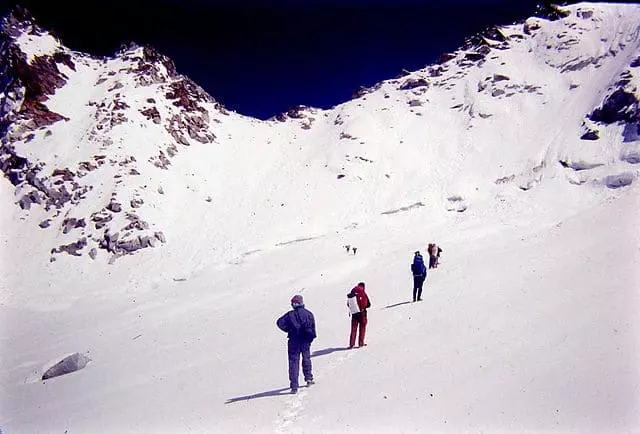
Borasu Pass Trek
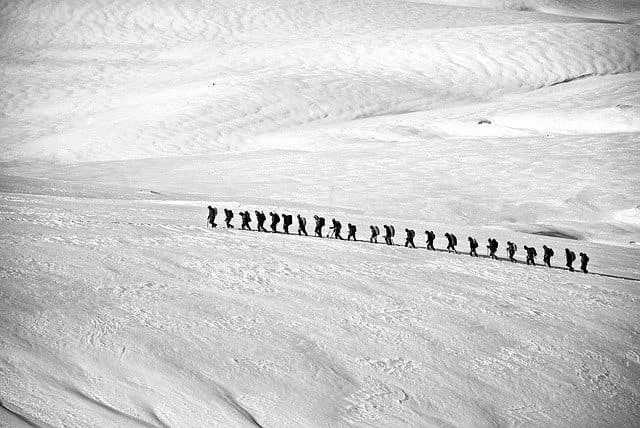
Lamkhaga Pass Trek
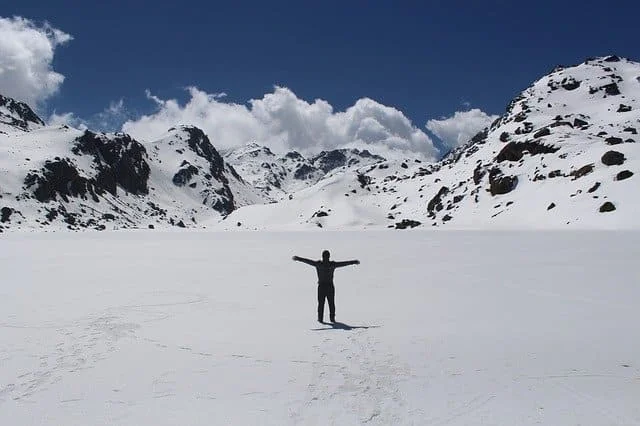
Kalindikhal Pass Trek
Choose your date.

Nandadevi Basecamp Trek
Nandadevi basecamp trek.

Day 1 Day 01: Dehradun – Kathgodam (272 kms ) 7-8 hours drive
We start early morning from Dehradun via road towards Kathgodam. Kathgodam being the mid stop is one of the twin townships of Haldwani-Kathgodam located in Naintital District of Uttarakhand. This place has two beautiful temples called ‘Sheetla devi’ and ‘Kalichaud’. Kathgodam is one of the most picturesque locations situated in the Bhabar region, the foothills of Kumaon Himalayas. We rest at a guest house for the night.
Day 2 Day 02: Kathgodam - Munsiyari ( 379 kms ) 9-10 hours Drive
Situated on the banks of Goriganga river, mountaineers , glacier enthusiasts, high altitude trekkers and nature lovers commonly use it as their hub or base camp. The Drive towards Munsiyari crosses Chaukori which has Tea estates and magnificent Himalayan views. We rest at the Guest house for the Night .
Day 3 Day 03: Munayari – Lilam (1850 mtrs. ) 7 kms
This is our first day of the trek and the trail is pretty easy . The Lilam village radiates local Garhwali culture of its winter habitants . Maa Bhagwati Temple falls on the way . Set amidst Nature’s finest painted canvases this campsite offers some picturesque views. We camp overnight.
Day 4 Day 04: Lilam- Bogudiyar (2609mtrs. ) 12 kms
The trail enroute Bogudiyar is dense wooded lush green and witnesses some water streams. Gori Ganga is a river near Bogudiyar Village . We camp by the river side tonight.
Day 5 Day 05: Bogudiar- Rilkot (3130mtrs.) 12 kms
The trail from this point becomes challenging towards the ascend. We cross through some interesting Himalayan terrains to reach the Village of Rillkot and campsite is besides gushing river where we spend the night in tents.
Day 6 Day 06: Rilkot- Ghanghar (3300mtrs.) 13 kms
The Altitude gradually increases to this point by 170 meters. This trail reveals some amazing Landscapes and views of the surrounding Himalayan ranges as we cross beautiful meadows enroute Ghanghar. This location also forms the Start of the Pachu Valley. Local wooden Architecture and local markets with some temples are highlights of this village. We camp here for the night.
Day 7 Day 07: Ghanghar- Pachu Glacier ( 4000smtrs.) 7kms
We start the Steep ascend towards Pachu Glacier early morning. One has to pass some dense woods surrounded with Rhodendrons – The Deep Pink Flower covered trees- green birches and some varied species of other Himalayan Flora along the path.This trail reveals the magnificent views of Pachu Glacier as you approach the Campsite. We spend the night in tents.
Day 8 Day 08: Day at the NandaDevi Base Camp
As the campsite is located on the eastern side of Nandadevi peak, trekkers get an opportunity to rise up to breath-taking Sunrise. This site also offers Stunning views of the Peak. This will be a rest day to soak in the magnificence of Nature and we camp overnight here.
Day 9 Day 09: Pachu Glacier- Martoli 17 kms
The descend starts towards Martoli after breakfast, encountering some uphill climb. Martoli is yet another Garhwal village offering local cultural exposure into the lives of these villagers. While one can experience wonderful picture perfect frames of Nanda Devi peaks. We spend the night at a homestay to experience the culture as a local.
Day 10 Day 10: Martoli -Rargari 20 kms
This trail is easy and takes us to the road access point at Rargari where we can embark in our vehicles for a road journey back towards Munsiyari. We stay at this location for the night before proceeding towards Munsiyari.
Day 11 Day 11: Rargari- Kathgodam 310 kms 9-10 hours drive
We proceed back towards Kathgodam via road enjoy the surrounding landscapes as we halt for lunch in nearby village enroute. We reach Kathgodam and stay in the guest house for the night.
Day 12 Day 12: Kathgodam- Dehradunn (272 kms ) 7-8 hours drive
We start early morning after breakfast for our return to Dehradun and arrive early evening.
Day 2 How difficult is the trek & what are the challenges?
What is the best time to do the trek and how is the weather, what are the top highlights of the trek.
There are no reviews yet.
Your email address will not be published. Required fields are marked *
Your review *
Name *
Email *
Save my name, email, and website in this browser for the next time I comment.
- Your designated hotels may not reopen by the time you reach there. While we are making alternate arrangements, do understand that things may not be as “tip-top” as our designated hotels.
- The gurudwara, Hemkund Sahib may not be open. While we are trying to take permission to go to Hemkund Sahib, if it does not happen, then do understand that the pandemic has put restrictions beyond our control.
Upcoming Treks
- 17-07-2021 to 23-07-2021 open
- 17-07-2021 to 23-07-2021 close
Send Request
Your query has been successfully registered. we will contact you within 24 hours., something went wrong.try after sometime..
- Tour Enquiry
- Sign up | Login
- My Bookings
- New User? Sign-up
- Domestic Tours
- South India
- Maharashtra
- Golden Triangle
- North India
- North East India
- International
- Maldives (Discontinued)
- All Domestic Tours
- All International Tours
- Offbeat Tours
- Domestic Cruise Tours
- Jungle Lodges by JLR
- Kabini River Lodge
- Bandipur Safari Lodge
- JLR Kings Sanctuary
- River Tern Lodge
- Kali Adventure Camp
- Hampi Heritage & Wilderness Resort
- K Gudi Wilderness Camp
- Car Rentals
- Destinations
- Tourist Places on Drive
- Driving Directions
- * Workation
- * Tour Plans
- List Property
- Uttarakhand
- Nanda Devi National Park
NANDA DEVI NATIONAL PARK | TREKKING & SIGHTSEEING TO NANDA DEVI
- Nanda Devi National Park Overview
- Top 4 Places to Visit in Nanda Devi National Park
- Best Nanda Devi National Park Tour Packages
- Top Resorts in Nanda Devi National Park
- Best Time to Visit Nanda Devi National Park
How to Reach Nanda Devi National Park
- Nanda Devi National Park Tour Plans
- Driving Directions to Nanda Devi National Park
About Nanda Devi National Park
Country: india | state: uttarakhand, #18 of 18 places to visit in uttarakhand | places to visit in india, ideal trip duration: 5 full days, base station: nanda devi national park, joshimath (52 kms), nearest city to nanda devi national park: dehradun (345 kms), best time to visit nanda devi national park: may to october, peak season: june & september, nanda devi national park weather: summer: maximum - 15°c and minimum - 5°c winter: maximum - 12°c and minimum - minus 10 °c.
At a distance of 26 km from Lata Village, 52 km from Joshimath, 94 km from Badrinath, 300 km from Rishikesh, 345 km from Dehradun, 327 km from Haridwar and 535 km from Delhi, Nanda Devi National Park is situated in the higher ranges of Himalayas in Chamoli district of Uttarakhand. The entire park lies at an altitude of 3,500 m and is surrounded by the Nanda Devi Mountains on three sides. It is one of the most scenic national parks in India apart from being a top trekking destination as well as one of the popular Tourist places in Uttarakhand . The Nanda Devi basin was declared a game sanctuary in 1939. In 1982, an area of 630.33 sq. km was added and it was declared a national park, which now forms the core zone of Nanda Devi Biosphere Reserve. Along with adjoining Valley of Flowers National Park, Nanda Devi Park was inscribed as UNESCO World Heritage Site in 2004. Nanda Devi National Park covers an area of 630.33 sq. km, which is surrounded by a buffer zone of 5148.57 sq. km. The whole region of Nanda Devi National Park falls under the Western Himalayas Endemic Bird Area (EBA). The park is divided into two parts - Inner Sanctuary and Outer Sanctuary. The Upper Rishi Valley, often referred to as the Inner Sanctuary is featured by Changabang, North Rishi and North Nanda Devi glaciers. The Trisul and Ramani glaciers are features of the Outer Sanctuary. The forest cover in this park is mainly restricted to the Rishi Gorge and the inner circle is quite dry. The park provides shelter to snow leopard, Himalayan black-bear, serow, Himalayan musk deer and Himalayan Tahr. There are around 114 species of birds, including orange-flanked bush robin, Indian tree pipit, yellow-bellied fantail flycatcher, blue-fronted redstart and vinaceous-breasted pipit. Varied species of butterflies can also be seen in the Nanda Devi National Park. The park has around 312 species of flowers, along with juniper and alpine vegetation. Trekking is the most popular activity in the national park. In 1982, access to trekkers was banned to protect the biodiversity. However recently, tourists in small numbers are allowed to visit the park. Visitors need to get the permission from Nanda Devi National Park Authorities, Joshimath for the trek. The visitors will move in groups and each group will consist of maximum of five visitors. Not more than two groups are permitted in one day and not more than four groups will be permitted in one week. One registered guide will accompany every five visitors. Visitors above 14 years will only be allowed to participate in the trek. The entry point to the park is Lata Village which is around 26 km from Joshimath and the trek exits at Surai Thotha which is 30 km from Joshimath. The total duration of Nanda Devi Trek is 5 Full Days. Day 1: Lata Village - Lata Kharak (9 km, 8-9 Hours) The first day of the trek is probably the toughest and involves a steep ascent of almost 1524 m with a break at Belta and it takes 8-9 hours. The camp at Lata Kharak is situated at an altitude of 3689 m and is surrounded by high peaks. Day 2: Lata Kharak - Dharansi Pass (10 km) The trek begins with a steep climb up to Jhandi Dhar and further up to Bagfyana pass. From here the trail ascends and descends through the narrow gorge of Satkul to Dharansi Pass (4250 m). Day 3: Dharansi Pass - Debrugheta - Dharansi Pass (14 km) Trek to Malthuni - Bethratoli Ridges of the inner and outer sanctuary form a magnificent pass up to Rani Kholi and Donidhar. The trail is a steep descent of about a kilometer to Debrugheta. Return to Dharansi Pass by late afternoon. Day 4: Dharansi Pass - Hitoli Camp Site (12 km) Return trek up to Jhandi Dhar of about 7.5 km and further steep descent of 4.5 km to the Hitoli camp site through thick forests of Rhododendron, Birch and Fir. Overnight stay in tents at Hitoli campsite. Day 5: Hitoli Campsite - Tolma - Surai Thotha (8 km) One has to trek 5 km to Tolma village through the rich forest of Thuner, Kail, devdar and Surai. Then further trek down 3 km to Surai Thotha, from where it is a 30 km drive to Joshimath. There are very few accommodation options near the national park. Visitors can choose to stay in the hotels at Joshimath. There are hardly any restaurants within the park. It is advisable to carry food and water. Jolly Grant Airport at Dehradun is the nearest Airport to Nanda Devi Park at a distance of 319 km. Rishikesh is the nearest Railway Station which is 300 km away from the Park. About 26 km from the Park, Lata Village is the nearest motorable road, while Joshimath is the major bus hub which is 52 km from the Park. The ideal time to visit the Nanda Devi National Park is from May to October. In the months of June to August, there is heavy rainfall in the area. The route to Nanda Devi remains
...read more
Nearest Airport: Dehradun - Jolly Grant Airport (319 Kms)
Direct flights to dehradun, nearest train station: rishikesh railway station (300 kms), direct trains to rishikesh, nearest bus station: lata village bus station (0 kms) joshimath (52 kms), direct buses to nanda devi national park, distance chart, distance chart & driving directions to nanda devi national park, top 10 places to visit in nanda devi national park, joshimath, near badrinath.

#1 of 4 Places to Visit in Nanda Devi National Park
At a distance of 42 km from Badrinath, Joshimath, also known as Jyotirmath is a town and a municipal board in Chamoli district of Uttarakhand. It is situated at an altitude of 6150 feet in the snow-capped Himalayan ranges just above the mountains of Dhauliganga and Alaknanda. It is also the gateway to many Himalayan expeditions, trekking trails, camping and pilgrimage centers. Joshimath is one of the four maths or monasteries established in the 8th century by Adi Guru Sri Shankaracharya. The math here is dedicated to Atharva Veda. Joshimath lies in the region of Vishnuprayag, where two rivers of Dhauliganga and Alaknanda meet. Joshimath is an important pilgrimage center with several temples and religious sites. Narasimha temple and Bhavishya Badri Temples are the prominent temples located in Joshimath. Narasimha Temple is an ancient temple of Lord Vishnu and main temple of Joshimath. It has idol of Lord Narasimha, which is believed to be established by Shankaracharya. As ..... Distance (From Nanda Devi National Park): 52 Kms Trip Duration (From Nanda Devi National Park - Including Travel): 1-2 Hours .....

#2 of 4 Places to Visit in Nanda Devi National Park
At a distance of 16 km from Joshimath, 56 km from Badrinath, 262 km from Rishikesh, 304 km from Dehradun and 495 km from Delhi, Auli is a cute hill station in Chamoli district of Uttarakhand. It is one of the best ski resorts in India and one of the top Uttarakhand tourism destinations for adventure sports. Known for its snow-cladded surroundings, Auli is one of the best places preferred by many Indians during their honeymoon tour . Auli, also known as Auli Bugyal which means meadow in Garhwali, is located at an average altitude of 2800 m in the Garhwal Himalayas. Earlier, Auli was a prominent trade centre and the trails of Auli were frequently traversed by the semi-nomadic Bhotiya tribes who maintained barter trading with Tibet for centuries. According to legend, the revered Guru Adi Shankaracharya visited Auli during 8th century AD. He built a math at Joshimath, which still is intact ..... Distance (From Nanda Devi National Park): 68 Kms Trip Duration (From Nanda Devi National Park - Including Travel): Full Day .....
Bhavishya Badri Temple, Near Auli
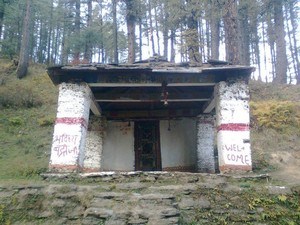
#3 of 4 Places to Visit in Nanda Devi National Park
At a distance of 23 km from Joshimath and 35 km from Auli, Bhavishya Badri, also spelt as Bhabisya Badri, is situated near Subhain village of Niti Valley on the way to Lata from Tapovan in Uttarkashi district of Uttarakhand. Bhavishya Badri is one of Panch Badri temples located at a height of 2744 m above sea level. The presiding deity of this small temple is Lord Narsimha, an incarnation of Lord Vishnu and known to be the future seat of Badrinath . According to the legend of Bhavishya Badri, at the end of Kali Yuga, a landslide will occur collapsing Nara and Narayan hills and blocking the path to Badrinath. This devastating landslide will occur when the right arm of the statue of Narasimha currently situated in Joshimath detaches from its body. Then, Badrinath will appear at the Bhavishya Badri temple and be worshipped here, instead of the Badrinath shrine. Bhavishya Badri can be reached via Saldhar which is 18 km by road ..... Distance (From Nanda Devi National Park): 39 Kms Trip Duration (From Nanda Devi National Park - Including Travel): Full Day .....
Kuari Bugyal / Kuari Pass, Near Auli
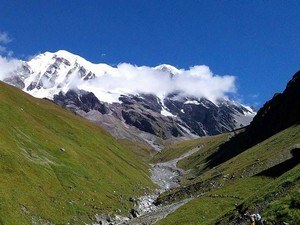
#4 of 4 Places to Visit in Nanda Devi National Park
At a distance of 20 km from Auli, 27 km from Joshimath, 21 km from Tapovan & 17 km from Gurson Bugyal, Kuari Bugyal is a famous meadow known for untouched beauty of Himalayas situated at an altitude of 3350 m. It is well known for one of the famous trekking trails in Uttarakhand, Kuari Pass Trek. Kuari Bugyal is perfect place for trekking. During summer season, tourists throng to this place to explore the trekking trails of this beautiful region. Lord Curzon made the trek to Kuari Pass, and since than it has come to known as Curzon's trail. It is very popular among European and American travelers. There are four trekking routes to reach Kuari Pass with different starting points at Auli, Ghat, Joshimath and Tapovan. The Ghat route is the longest trail with a length of 40 km spread across 4-5 days while Auli route is shortest which is 20 km long and take about 3 days. All the trails reach Gailgarh, from where Kuari Pass is scaled on same day and returned back to the base camp. ..... Distance (From Nanda Devi National Park): 60 Kms Trip Duration (From Nanda Devi National Park - Including Travel): 3 Full Days .....
Nanda Devi National Park Related Pages
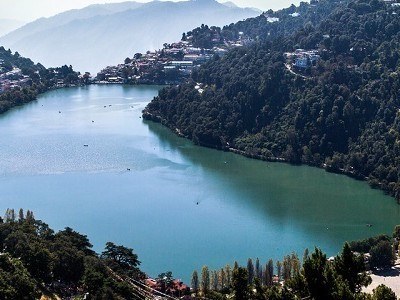
Near By Places
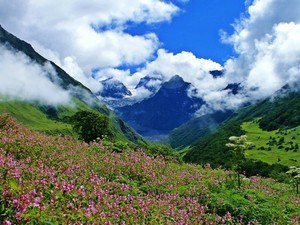
Similar Places
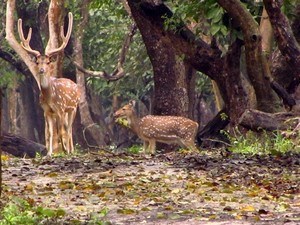
100% SECURE PAYMENTS
Domestic & international cards accepted.

Our WhatsApp Numbers
International tours, +91-8217845740, south india tours, +91-7995649483, goa, maharashtra, gujarat tours, +91-7032828835, north india tours, +91-9535139583, rest of india, +91-7799591230, request quote, travellers #.
Explore Tour Packages
Planning a Trip?
Discover affordable tour packages, need customized tour request quote, login / sign-up, your sign in was successful itinerary will be downloaded shortly., sign up with trawell.in.
Already Created Account? Login Here
Sign in with Trawell.in Account
Forgot Password?
New User? Sign Up Here
Activate Your Trawell.in Account
Your account is activated successfully. Login Here
Reset Your Trawell.in Password
Your password has been reset successfully. Login Here
Booking Policy

- Trip Reports
- Areas & Ranges
- Huts & Campgrounds
- Logistical Centers
- Fact Sheets
- Custom Objects
- Plans & Partners

- Additional Parents
- Images (40)
- Climber's Log Entries
- Comments (14)
- Additions & Corrections (3 )
Nanda Devi in the highest peak in the Indian Garhwal Himalaya. The mountain has two summits, the main summit at 7816m (25,643ft) and Nanda Devi East at 7434m (24,389ft). The mountain itself in surrounded by a number of peaks over 21,000ft, making it an extremely difficult mountain to access. This circle of peaks forms what is known as the Nanda Devi Sanctuary.
The first successful ascent of the main summit was by Tilman and Odell in 1936 via the south ridge. With the successful ascent, Nanda Devi became the highest mountain climbed by man until 1950 when Annapurna was climbed. In 1976, Americans James States, Lou Reichardt and John Roskelley climbed the main summit by a new route, the North Ridge. This expedition ended in tragedy when Nanda Devi Unsoeld (Willie Unsoeld's daughter who was named after the mountain) died near the main summit. A fantastic account of this expedition can be read in the book by John Roskelley, "Nanda Devi, the Tragic Expedition".
In the mid 1960's, it is reported that the CIA during an expedition put a monitoring device on the main summit to monitor nuclear activity in Tibet/China. It was supposedly lost in an avalance. Article on this The mountain was closed by the government shortly after and then re-opened in 1974. In 1983 the area was closed for environmental reasons. The mountain remains closed to this day.
There are very few ascents of this beautiful mountain, and in time we may see the Sanctuary reopen and new attemps being made.

- Ascent History of Nanda Devi
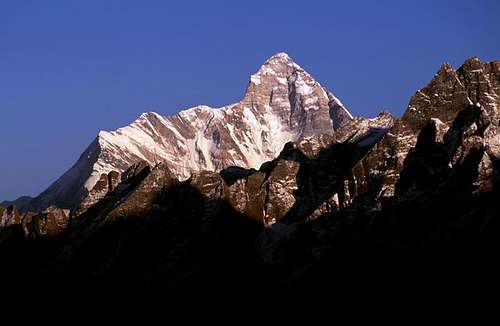
- Peaks of the Nanda Devi Sanctuary
The Nanda Devi Sanctuary has a "rim" of mountains around it and is known as the Sanctuary Wall. Inside this Sanctuary Wall is the Inner Sanctuary Ridge. The North Sanctuary Wall includes the peaks Latu Dhura (21,000ft), Rishi Pahar (22,900ft) Deo Damla (21,700ft), and Mangroan (21,500ft). On the west flank of the Sanctuary wall, you will find Kalanka (22,900ft) Changabang (22,500ft), and Dunagiri (23,000ft).
On the south side of the Sanctuary Wall rises Bethartoli Himal & South (20,800 & 20,700ft), Trisul (23,400ft). On the eastern edge of the Sanctuary stands the impressive Mrigthuni (22,500ft), Devtoli (22,300ft) and Maiktoli (22,300ft). Many of these peaks on the outer rim of the Sanctuary are still open to climbing.
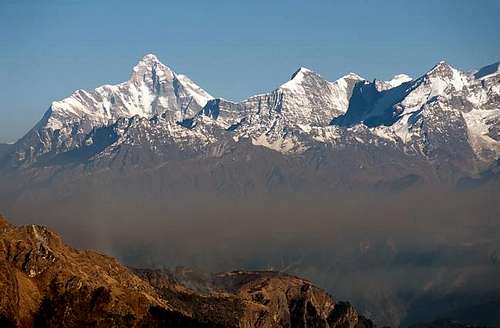
- Getting There
The Sanctuary is closed to all visitors, but the peaks on the outer rim of the Sanctuary can be climbed from outside the Sanctuary. This would allow for an attempt on the Nanda Devi East from the east or any of the other mountains forming the ring from the outside. The main summit is off limits currently because it falls inside the ring.
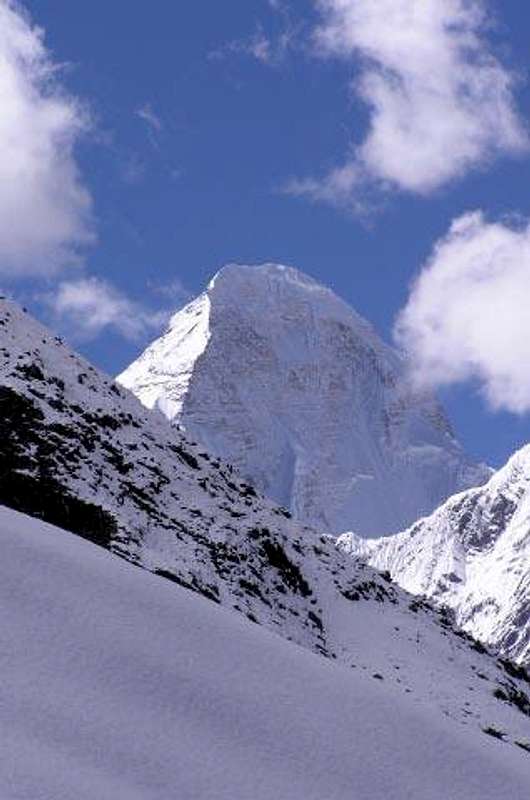
The mountain (Main Summit) is currently closed to all visitors. To climb any peaks in the Sanctuary, you must get permission from the Mountaineering Foundation in India. There are fees based on the height of the mountain you wish to climb, and a government liasion must be on your team. Additional fees will be assessed for environmental protection.
The Indian Mountaineering Foundation can be contacted at Benito Juarez Road, New Deli.
- When To Climb
May - June or September - October.
- The Climb ...
Nanda Devi is a full expedition style climb. Gear appropriate to this type of climbing is necessary.
- Useful Links
US State Department Information on Travel to India
The Garhwal Himalaya East Page
Nanda Devi Sanctuary Page
Additions and Corrections Post an Addition or Correction

dmiki - Dec 31, 2010 7:14 am - Voted 10/10
30.5425, 79.970833 ? Or even better: 30.36814 / 79.99008
dmiki - Dec 31, 2010 7:25 am - Voted 10/10
Bliss-Giving Goddess
dmiki - Dec 31, 2010 7:27 am - Voted 10/10
"The first attempt to traverse the ridge between the main summit and Nanda Devi East resulted in the death of two members of a French expedition in 1951. Team leader Roger Duplat and Gilbert Vignes disappeared on the ridge somewhere below the main summit. Tenzing Norgay was in a support team on this expedition; he and Louis Dubost climbed Nanda Devi East to look for the missing pair. Some years later Tenzing was asked what was the most difficult climb he ever did, expecting him to say Mount Everest; he surprised his interlocutors by saying Nanda Devi East."
View Nanda Devi Image Gallery - 40 Images
- Additions & Corrections
- Nearby Mountains & Rocks
- Interactive Map
- Mountains & Rocks in India
Parents refers to a larger category under which an object falls. For example, theAconcagua mountain page has the 'Aconcagua Group' and the 'Seven Summits' asparents and is a parent itself to many routes, photos, and Trip Reports.
- Bhagirathi - II
- Mount Thelu
You need to login in order to vote!
Don't have an account.
- Rating available
- Suggested routes for you
- People who climb the same things as you
- Comments Available
- Create Albums

IMAGES
VIDEO
COMMENTS
Nanda Devi East Coast Trek Cost. According to Ahvan Adventures, the cost per person is about 34,500 per head. Nanda Devi East Coast Trek Itinerary Day 01: Delhi - Kathgodam (By AC Train) - Almora. The train for Kathgodam leaves from New Delhi at 06:00 hours. Once you board the train you will arrive at Kathgodam at 11:20 hours.
The Complete Guide To Nanda Devi National Park Trek - A revolving door of imagery ... Booking a whole jeep will cost you Rs. 1100. The distance from Joshimath to Lata is about 32 km and will take about 1.5 hours. The grocery shop at Lata is the starting point of the trek. Joshimath is at an altitude of 6952 feet.
How to reach Nanda Devi Base Camp Trek Starting Point - Munsiyari. By Air. The nearest airport to Munsiyari is the Pantnagar Airport (312 km). ... For this service, you will be charged over and above the trek cost. The charges for offloading vary with every trek. Travel Insurance: Travel Insurance is not included in this package. We recommend ...
Nanda Devi East A.B.C trek does not come in the purview of a simple trek. If adequate attention is not given to logistics it can be damning especially if you are planning to climb Longstaff col which is tantalizingly so close to the advanced base camp of Nanda Devi East. ... 10 km away, where the trek starts. The cost of an SUV is between Rs ...
The phone does not work in during the Nanda Devi trek, so any necessary calls you make from Munsiyari base camp will not be networked further. ... Up to 30 Days - 90% cost is Refundable. Between 21 to 30 Days - 50% cost is Refundable. Less than 20 Days - No Refund (Refunds are initiated in 7-8 business days) Recent Blog Posts. Trekking in ...
Nanda Devi Base Camp Trekking Tour : Cost Per Person : Group Fixed Departure Date : Rs 32500: Custom Date Expedition : Rs 44500: ... The trek to Nanda Devi East Base Camp leads off at an altitude of about 4,200 meters en route to Milam Glacier. The experience undertaken as soon as stays framed continuously with the impressive view of Rishi ...
Nanda Devi (7816 M) is India's second highest mountain. It is a massif with two peaks namely the Nanda Devi East (7434 mtrs.) and Nanda Devi West (7,816 mtrs.). Nanda Devi East Base Camp Trek is the perfect way to witness the beauty of the sister peaks - standing in the centre of a ring of peaks - majestic and aloof.
Nanda Devi Base Camp - Detailed Itinerary, Reviews, Safety - Trekup India
Book Nanda Devi East Base Camp Trek Online @ Best Price Available. Avail Best Offers on Nanda Devi Trek & Explore the Himalayas. Book Now!
Daywise Itinerary For Nanda Devi Milam Glacier Trek. (click to read detailed route briefing, elevation graph, altitude time info and photos from the day) Day 1 Arrival Day Munsiyari. Day 2 Rest Day Munsiyari. Day 3 Trekking Day Lilam. Day 4 Trekking Day Bogudiyar. Day 5 Trekking Day Martoli.
The peak of Nanda Devi and the mountains surrounding it were closed in 1983 to preserve and protect its fragile ecosystem. The area around is the Nanda Devi National Park which is declared as a World Heritage Site by UNESCO. The trek to the Nanda Devi Base Camp is a difficult trek of 9 to 12 days depending on your trek guide.
Cost Includes: - Camping Tents, Kitchen tents, Dining Tent and Sleeping bags (Holofill) and Carry mats. - Nutritious, high calorie vegetarian food - Transportation from Kthgodam to Munsyari.(Day-1) ... While the route on the Nanda Devi trek will take most of the time, the return is a fairly easy descent.We retrace the same trail back to panchu ...
The cost of the Nanda Devi East Expedition can vary depending on several factors, such as the expedition duration, the services and support provided by the guiding agency, the number of climbers in the team, the level of logistical support, and the overall itinerary. ... Nanda Devi Inner Sanctuary Trek: This trek takes you to the base of Nanda ...
The Nanda Devi trek passes through the opulent Nanda Devi Sanctuary, an amphitheater of seventy miles in perimeter and stretching to an altitude of 6,000 meters lies adjacent to the Rishi Ganga valley. Several attempts were made to climb the Nanda Devi Peak but it was only in 1934, Bill Tilman accompanied by Eric Shipton reached the sanctuary ...
Nanda Devi East is also known as Sunanda Devi, the lower of the two adjacent peaks, is located at an altitude is 24,390 feet. The western summit of Nanda Devi, at an elevation of 25,643 feet is the highest of the two peaks. It is the main summit. Nanda Devi and Sunanda Devi, the twin Goddesses are worshipped throughout Uttarakhand.
Nanda Devi Trek Overview. Nanda Devi, standing tall at 8,7861m (8.761km), is the second tallest mountain in India. It falls within the boundaries of Nepal and India and falls in the Uttarakhand state of India. It is part of the Garhwal Himalayas. The name 'Nanda Devi' refers to the guardian goddess of the Himalayas of this region.
Nanda Devi Base Camp Trek is a pilgrimage into the heart of the Garhwal Himalayas, where the majestic Nanda Devi, India's second-highest peak, stands as a sentinel of awe-inspiring beauty. Nestled in the state of Uttarakhand, this trek is a harmonious blend of challenging ascents, alpine meadows, and unmatched natural splendor. ...
Nanda Devi base camp Trek in Himalayas is the most astonish trek, to experience the best time and the stunning flora fauna one must plan a trip to Nanda Devi base camp trek best time in mid June to mid September. ... Exclusion in cost during the trek: Mandatory GST of 5% on Invoice Amount. Any kind of Travel / Health Insurance (Trekveda ...
NANDADEVI BASECAMP TREK Description Nanda Devi Peak located in the Garhwal Himalayas in Uttarakhand stands tall holding the Honour of being the Second Highest Mountain Peak in India. Nanda Devi literally meaning "The Goddess of Bliss (Ananda) "stands true to its name. After several futile attempts to conquer this Peak and to gain access to the Nanda Devi Sanctuary , for over half a century ...
Any other expenses not in the inclusions. Trekking Distance: 25 - 35 Km. Altitude: 3650 mt. Package Cost: Rs.20000 per person. Reference Link: details. Nanda Devi Trek Packages Cost, Online Booking, Tour details, Contact number, Best Time to visit, Package details, Five day Tour details, Entry pass.
For Nanda Devi national park , Please call @ 85000 87012. Reference Link: details. Nanda Devi National Park trek Timings, Permit fees, Tour Guide, Contact number, Opening Dates, Contact number, Packages, Best Time to visit, Route info.
The total duration of Nanda Devi Trek is 5 Full Days. Day 1: Lata Village - Lata Kharak (9 km, 8-9 Hours) The first day of the trek is probably the toughest and involves a steep ascent of almost 1524 m with a break at Belta and it takes 8-9 hours. The camp at Lata Kharak is situated at an altitude of 3689 m and is surrounded by high peaks.
The mountain has two summits, the main summit at 7816m (25,643ft) and Nanda Devi East at 7434m (24,389ft). The mountain itself in surrounded by a number of peaks over 21,000ft, making it an extremely difficult mountain to access. This circle of peaks forms what is known as the Nanda Devi Sanctuary. The first successful ascent of the main summit ...